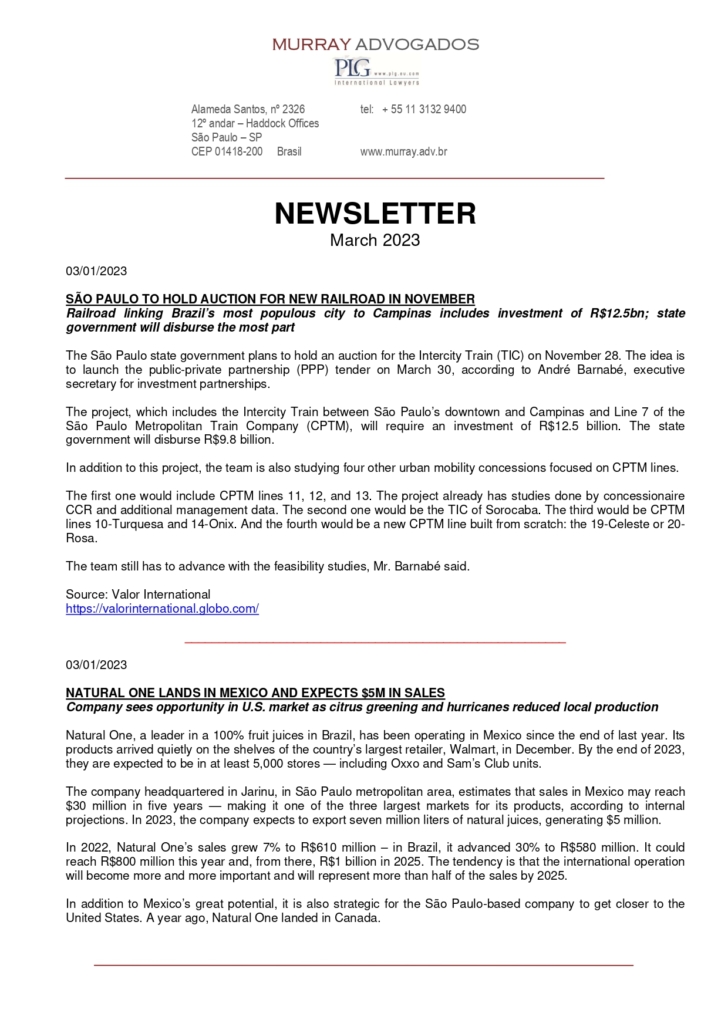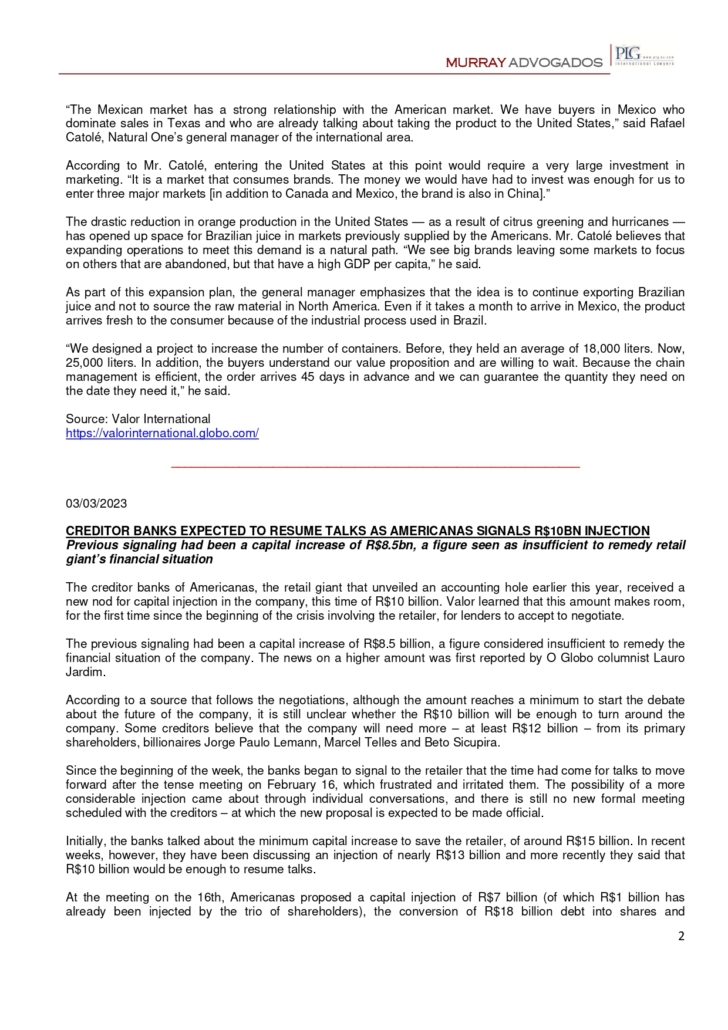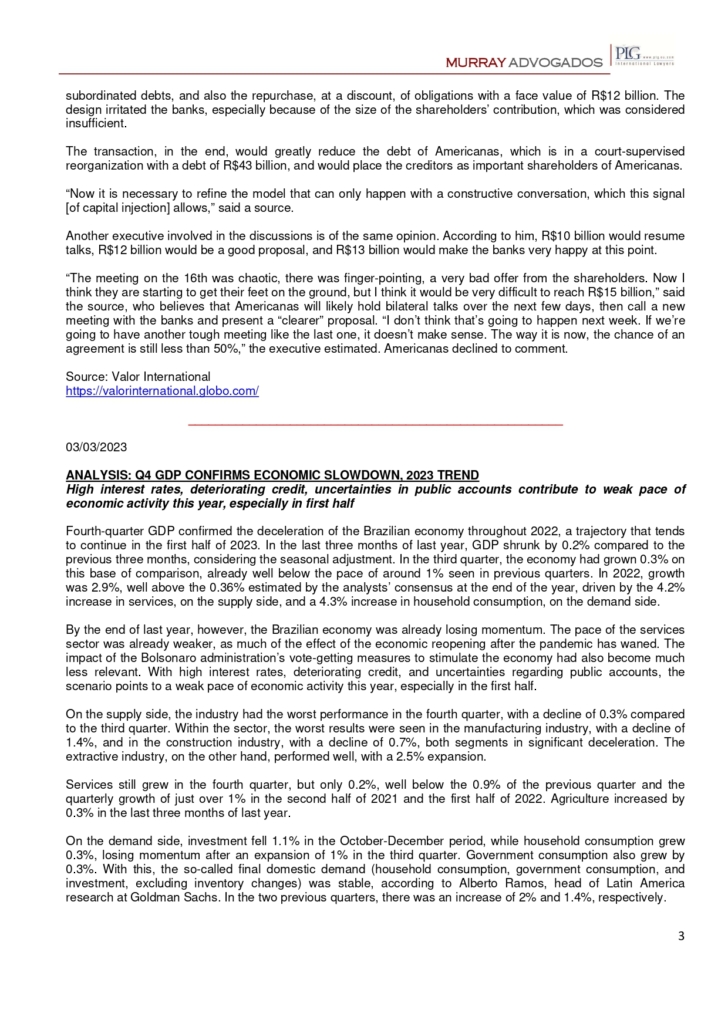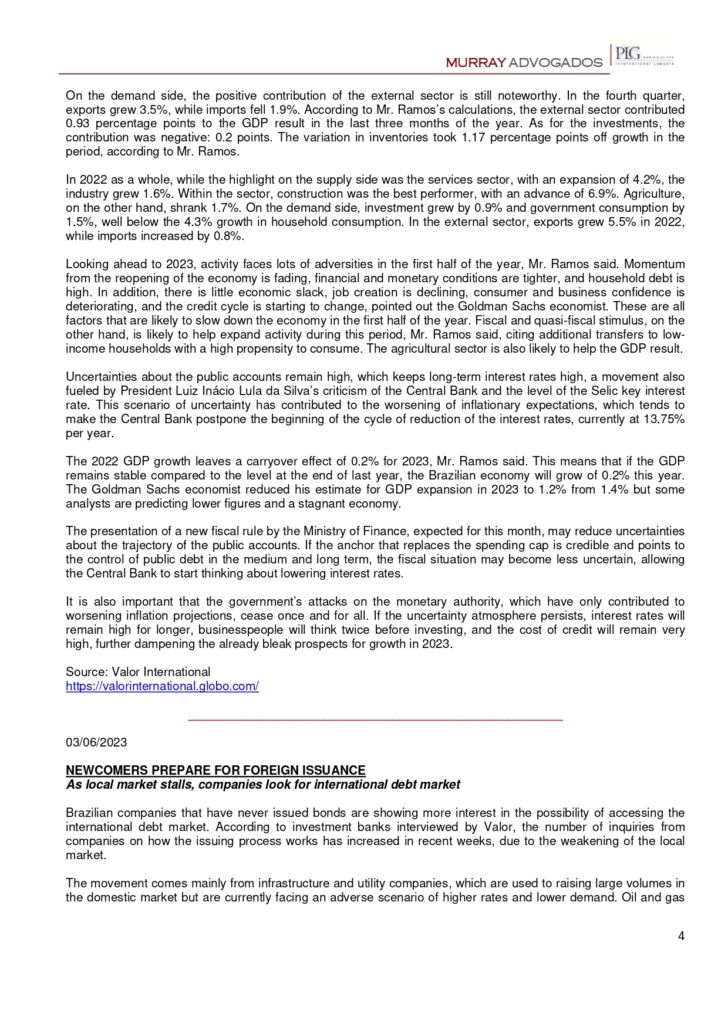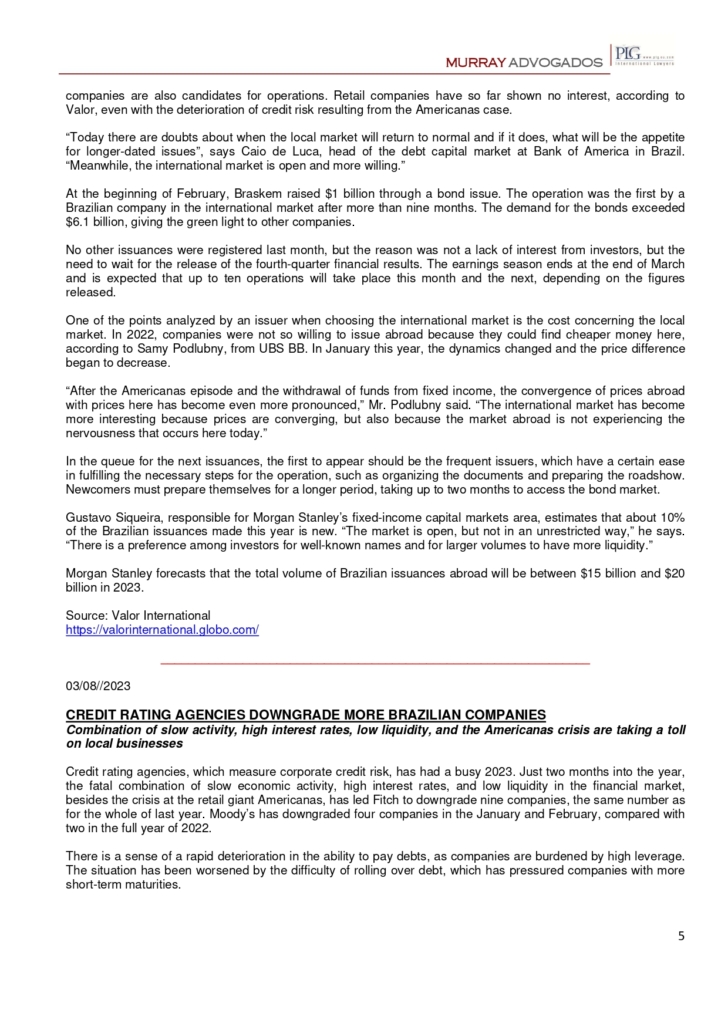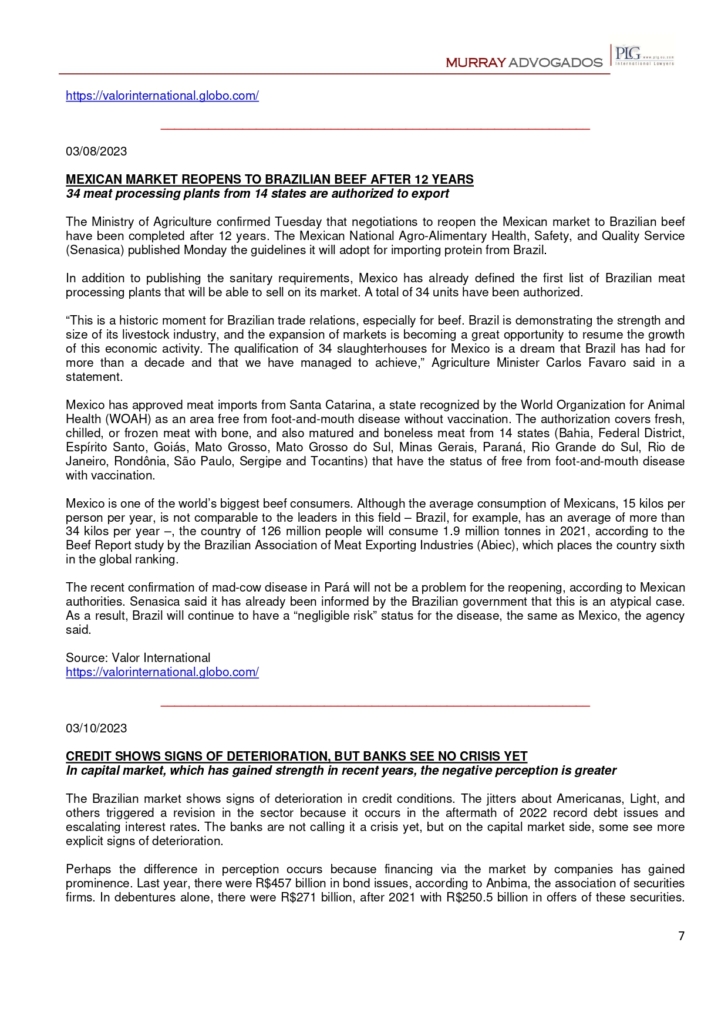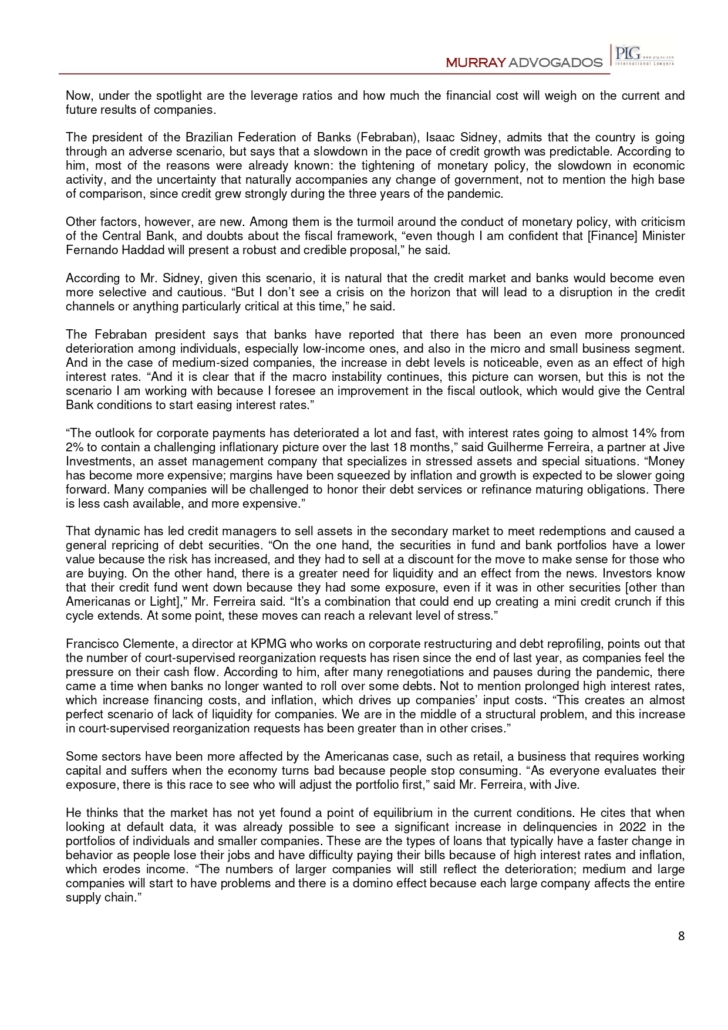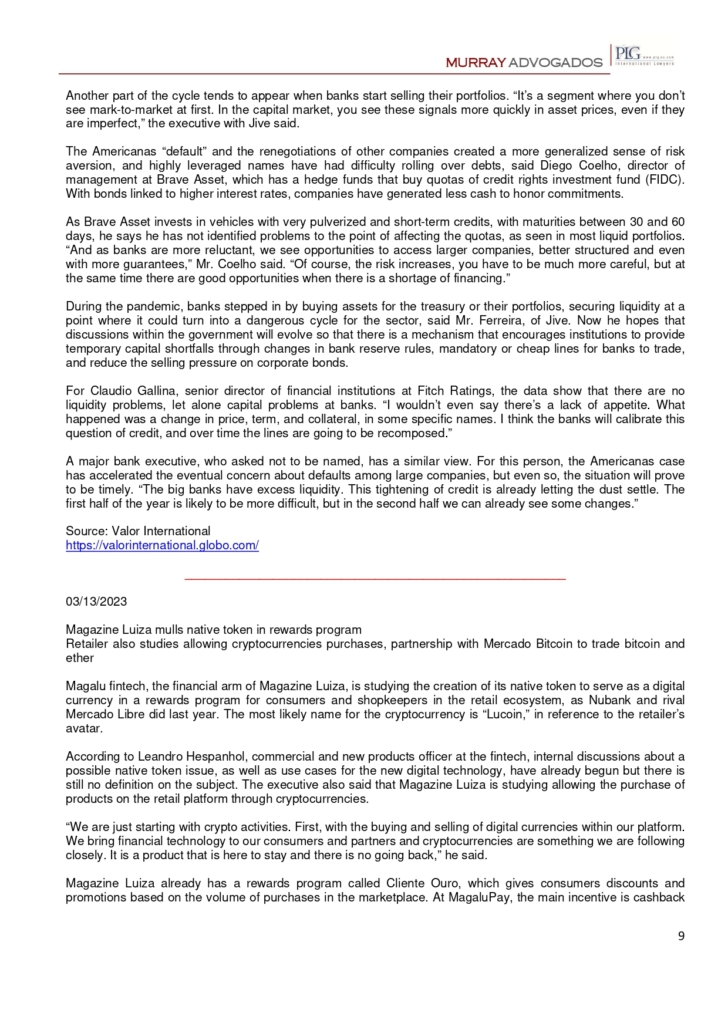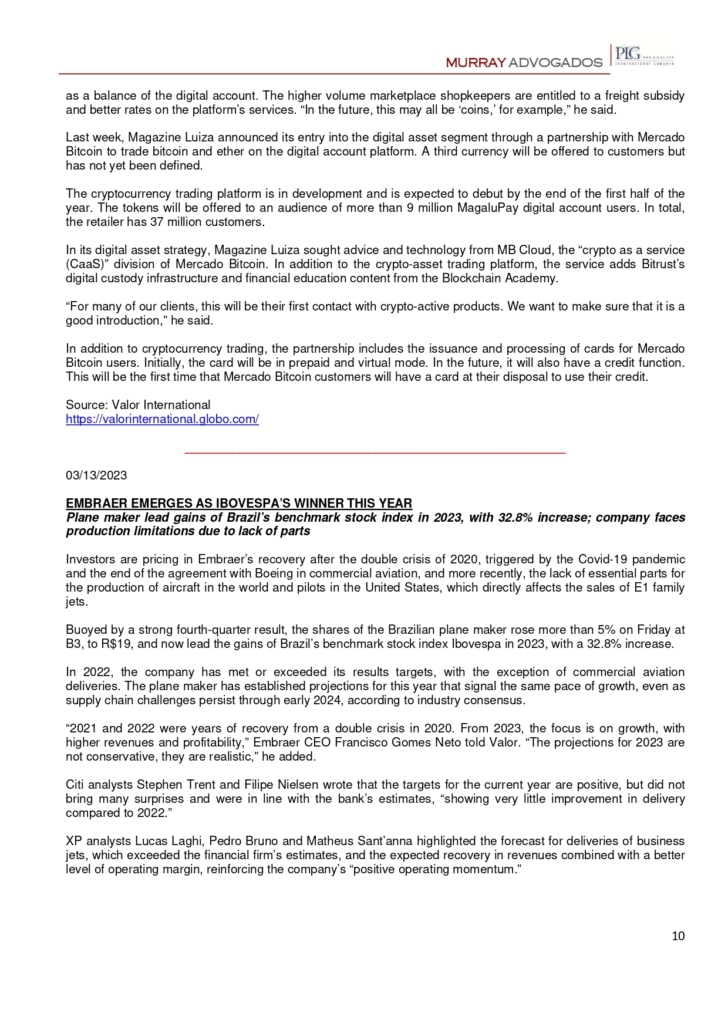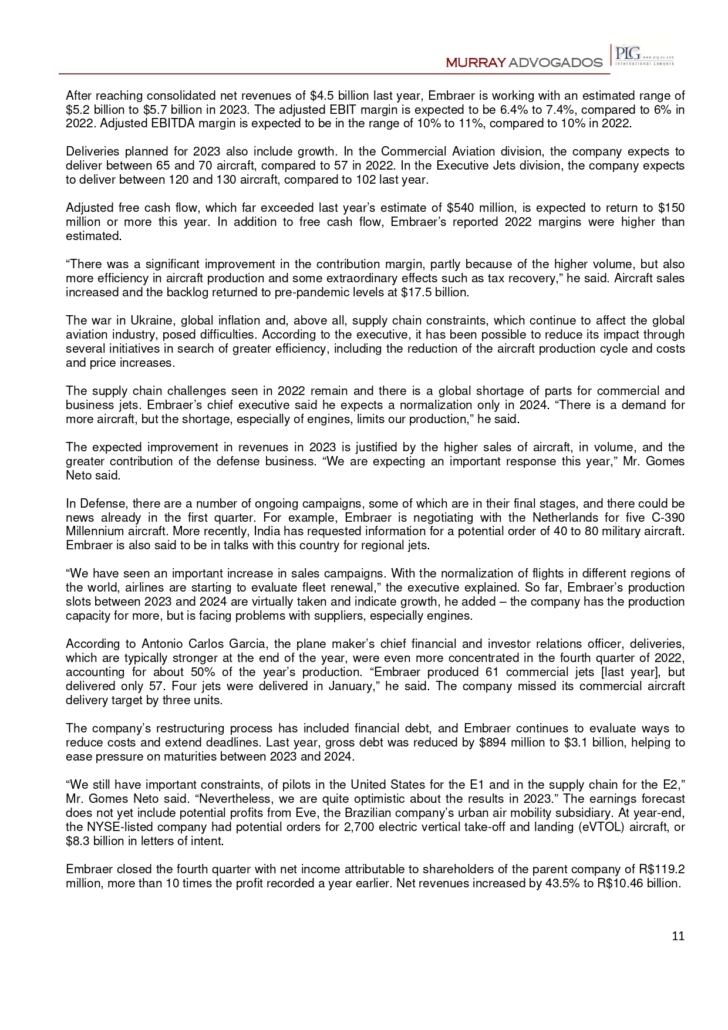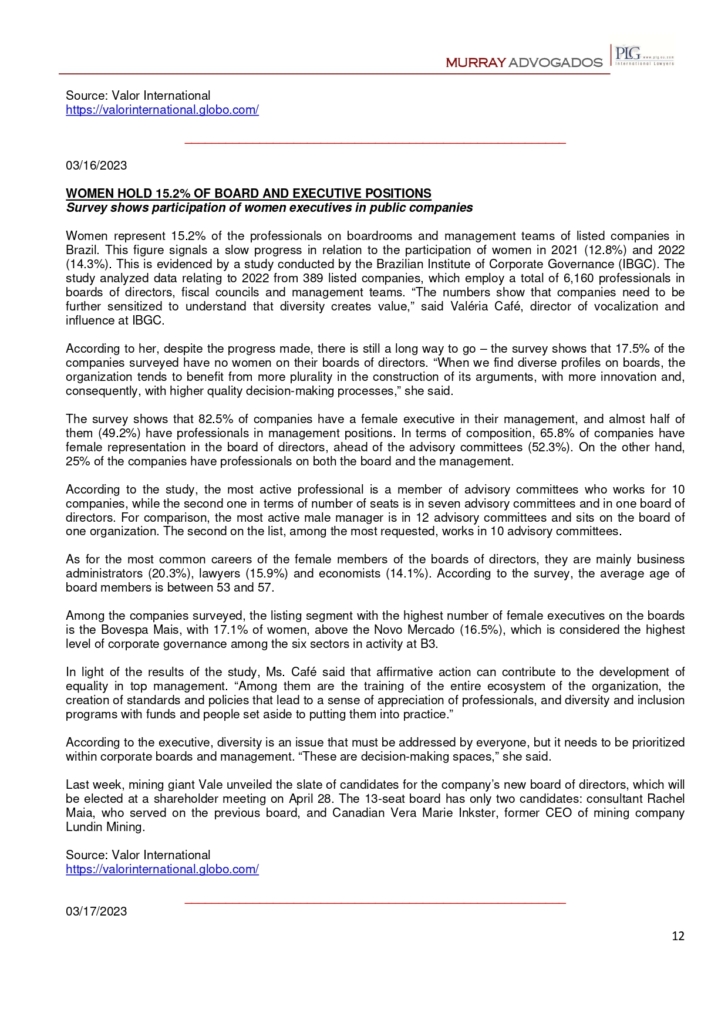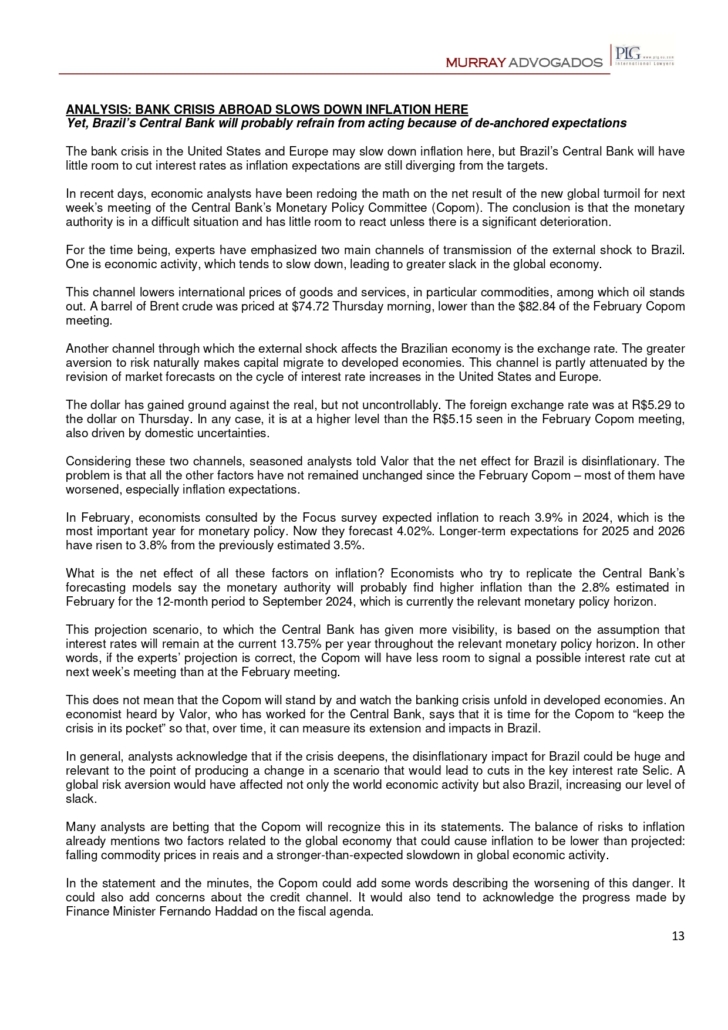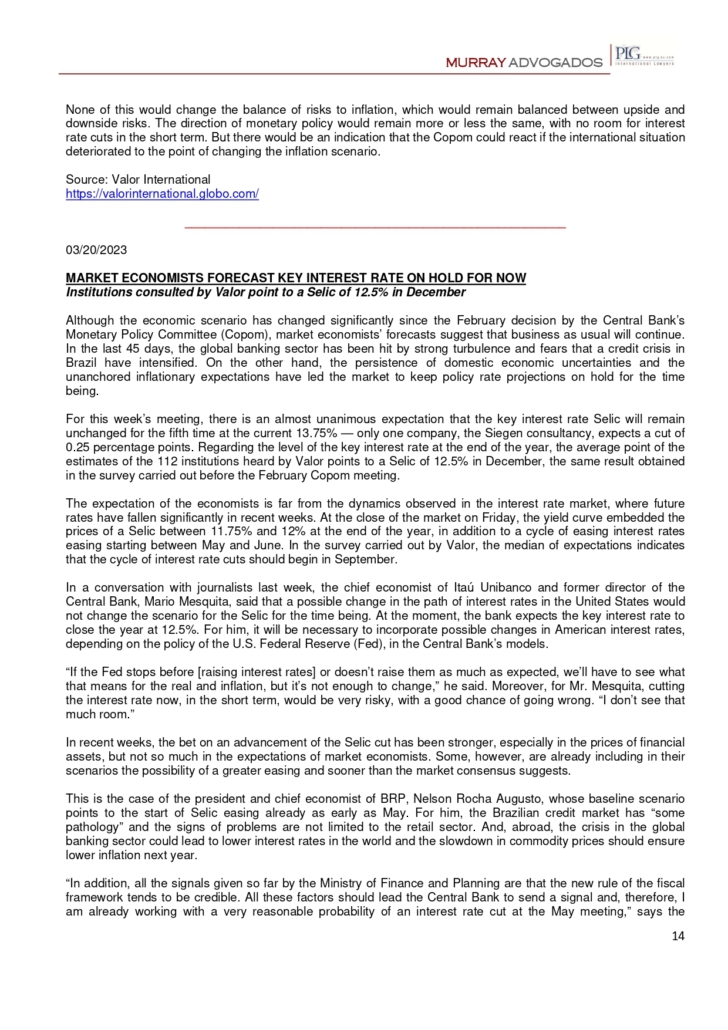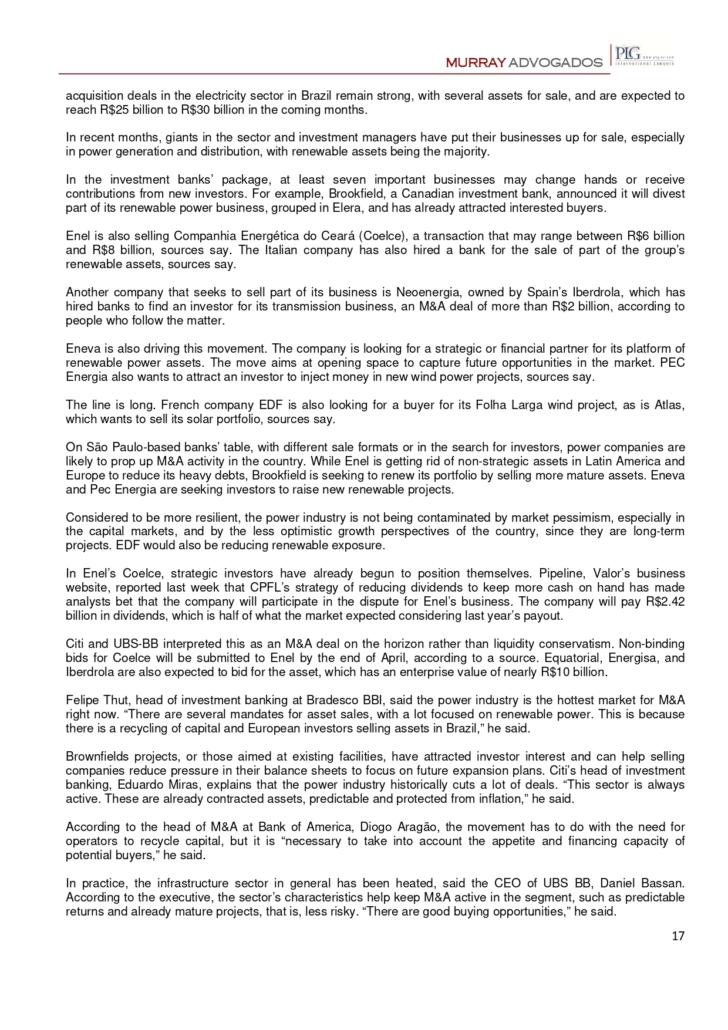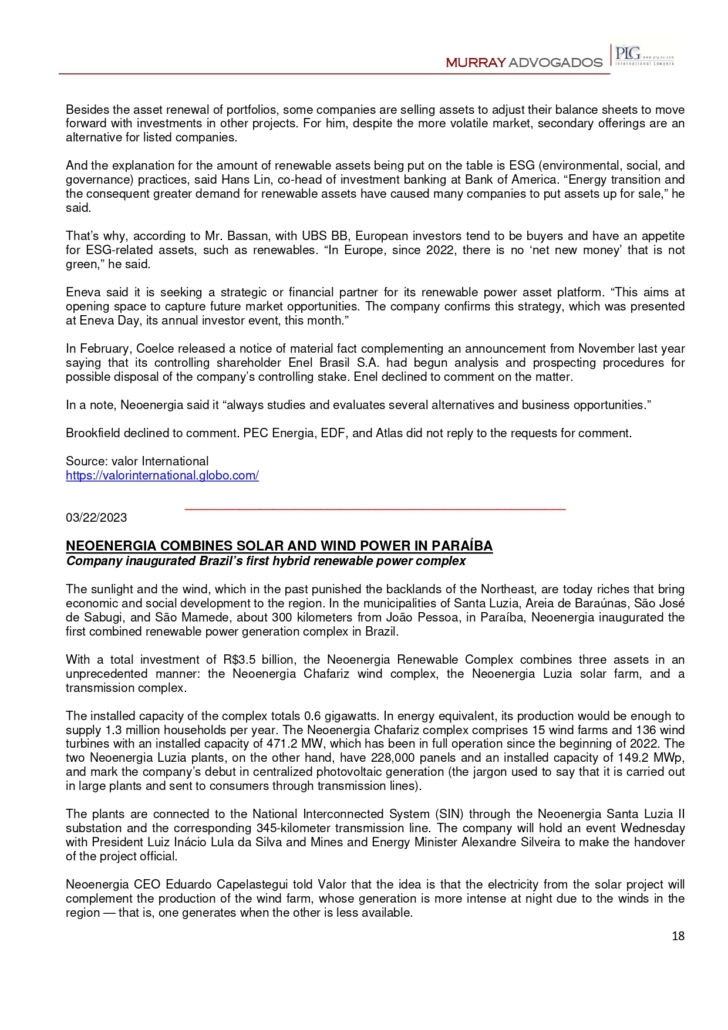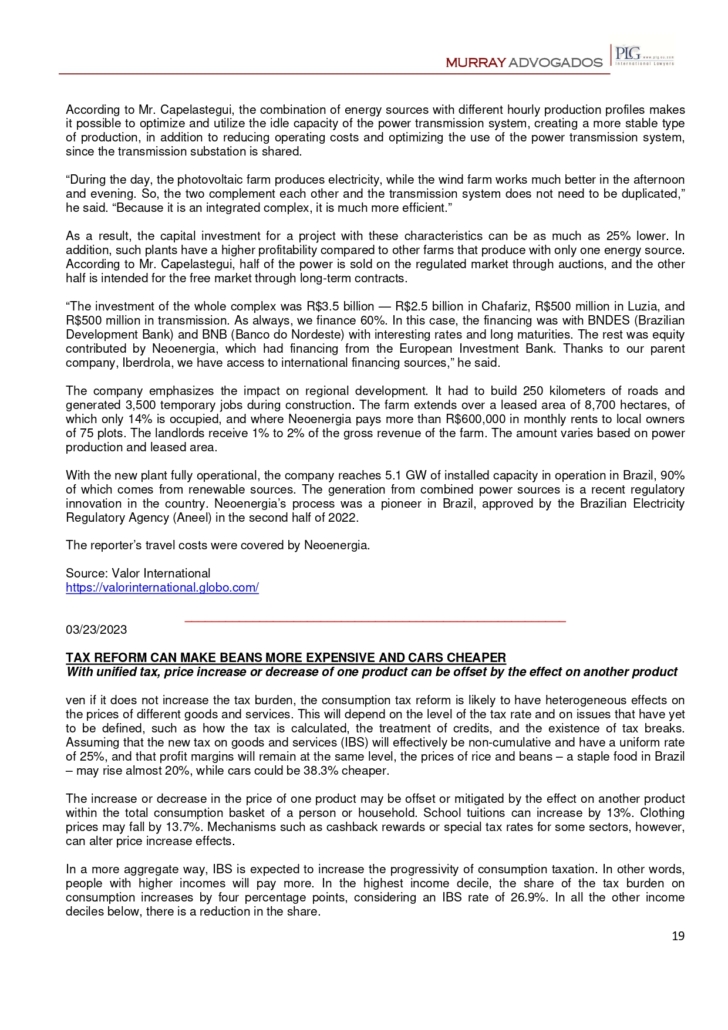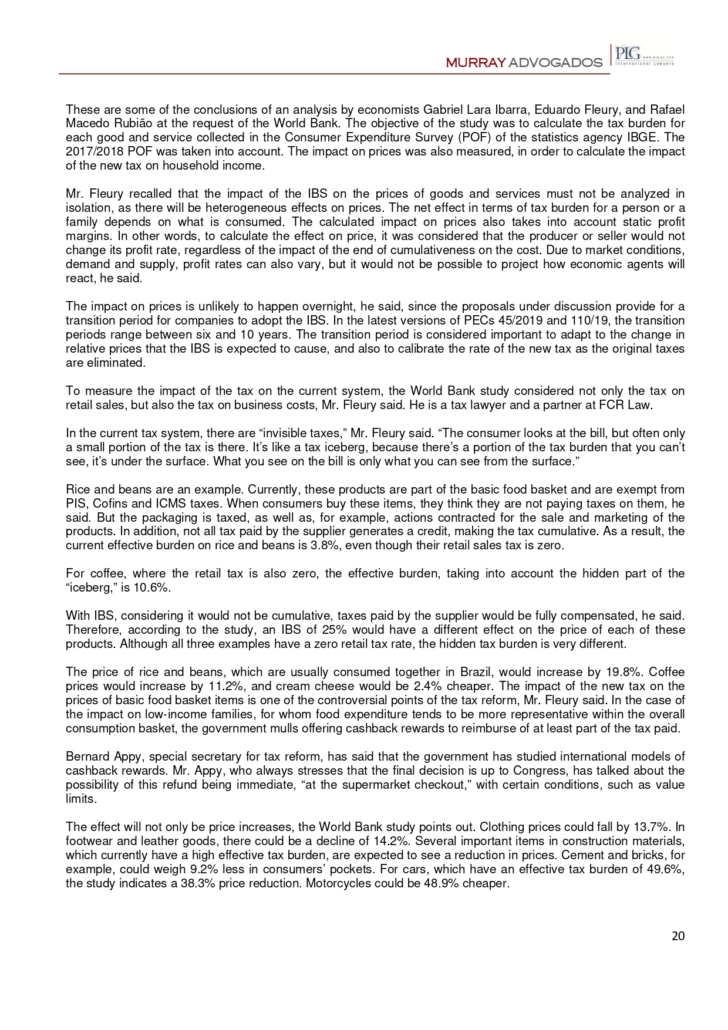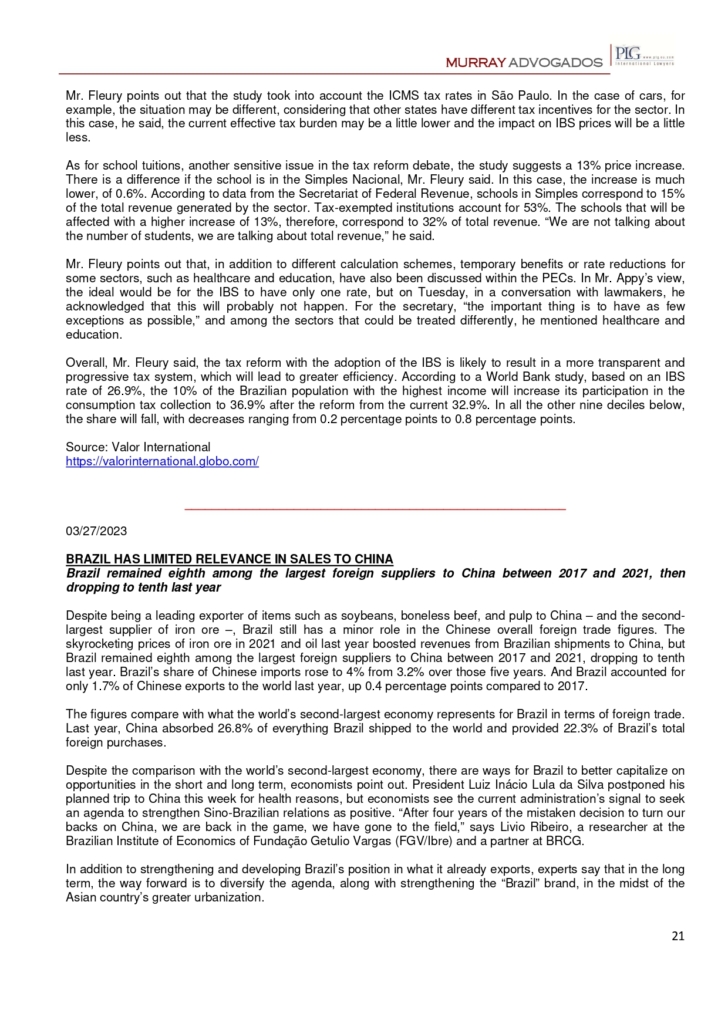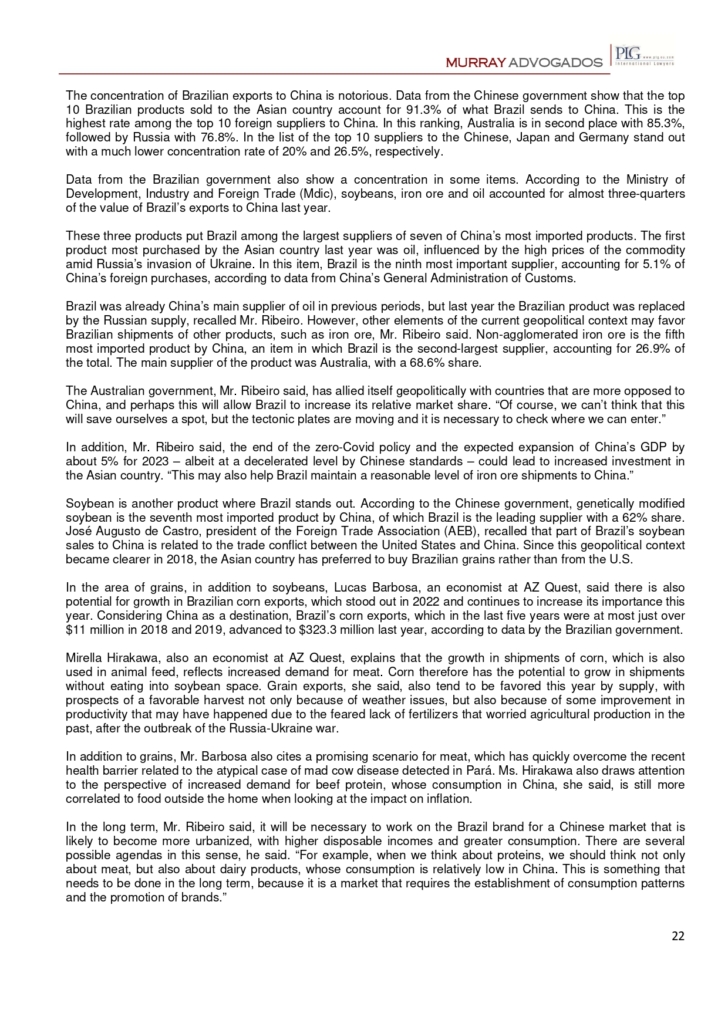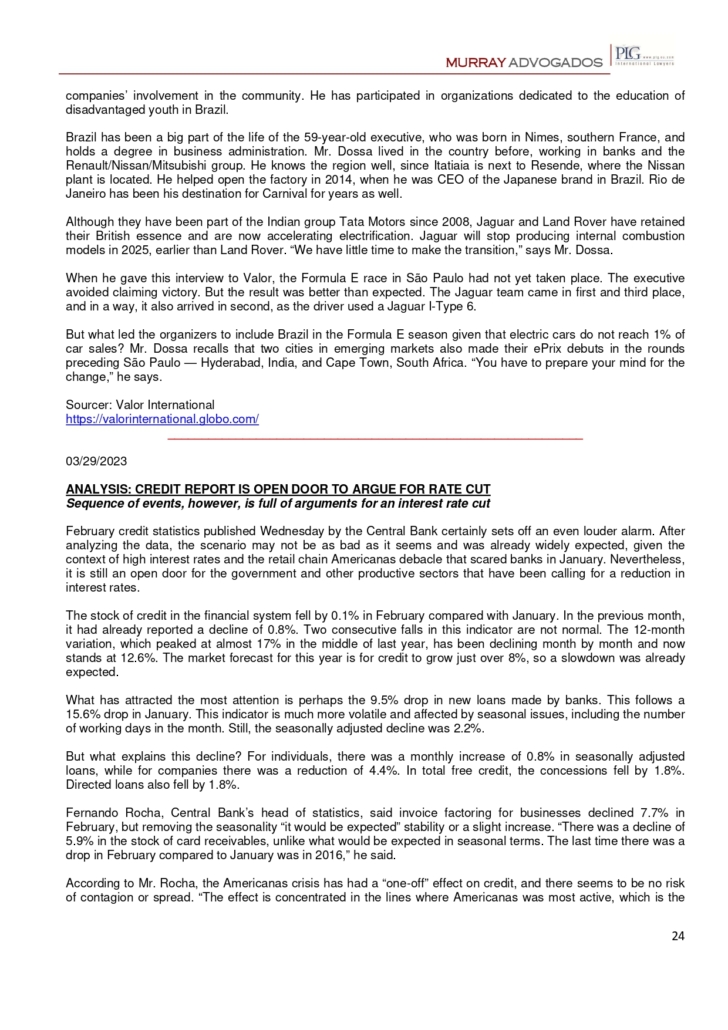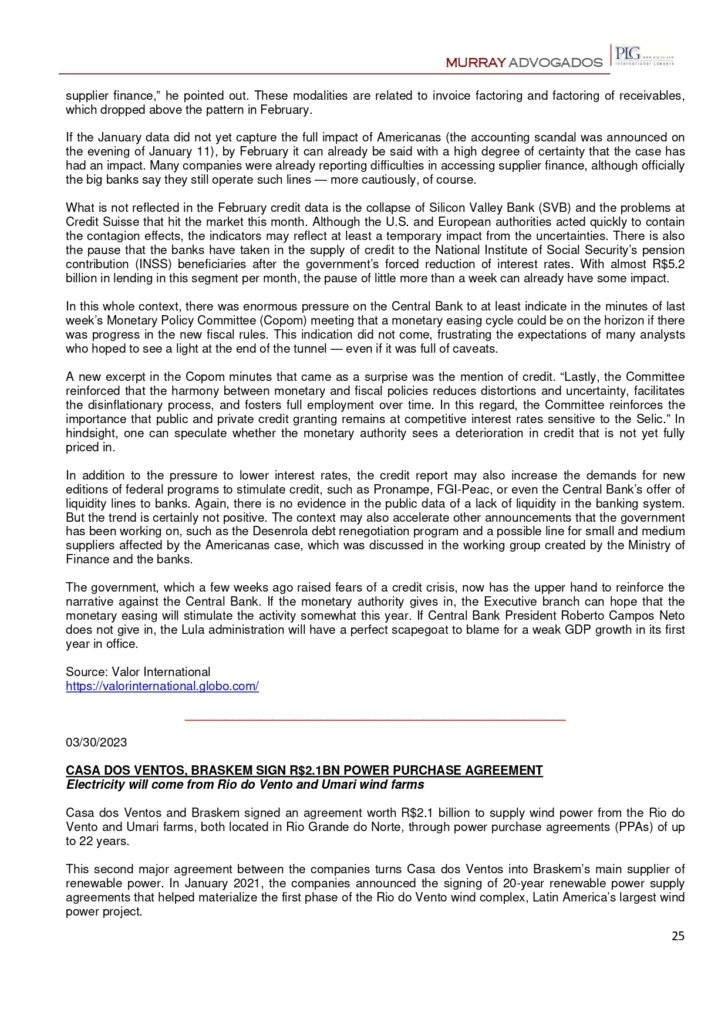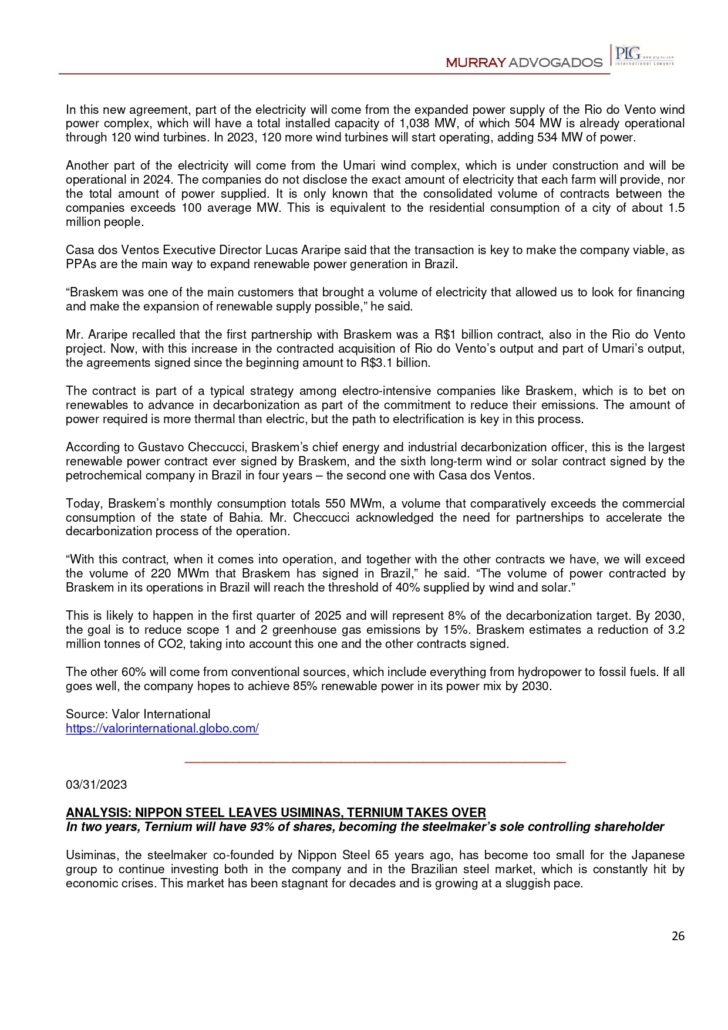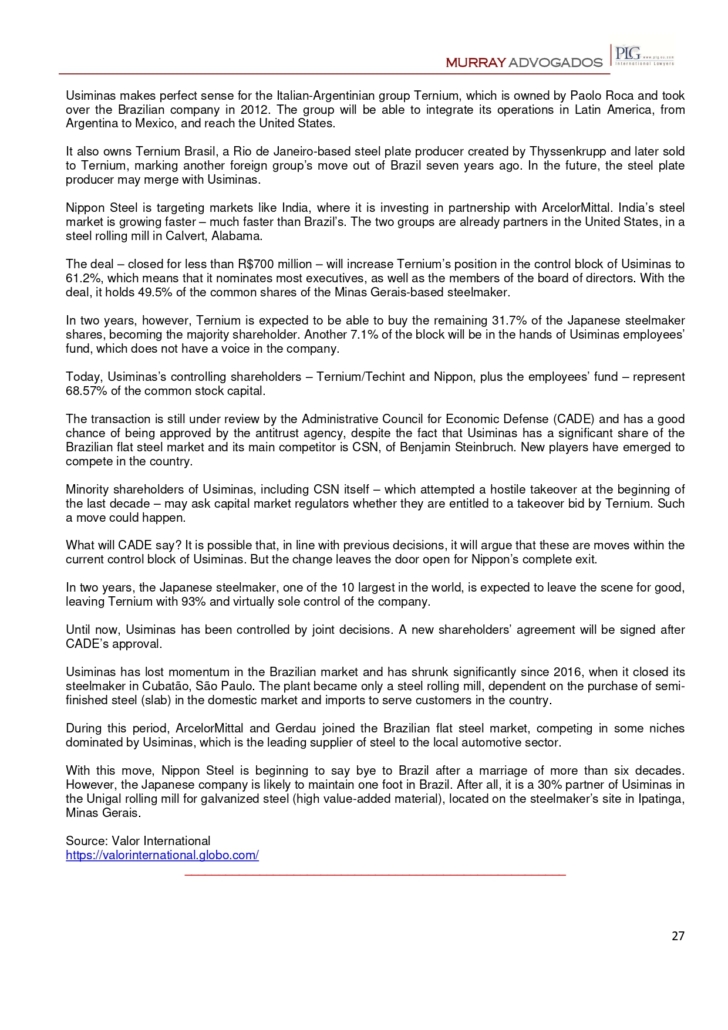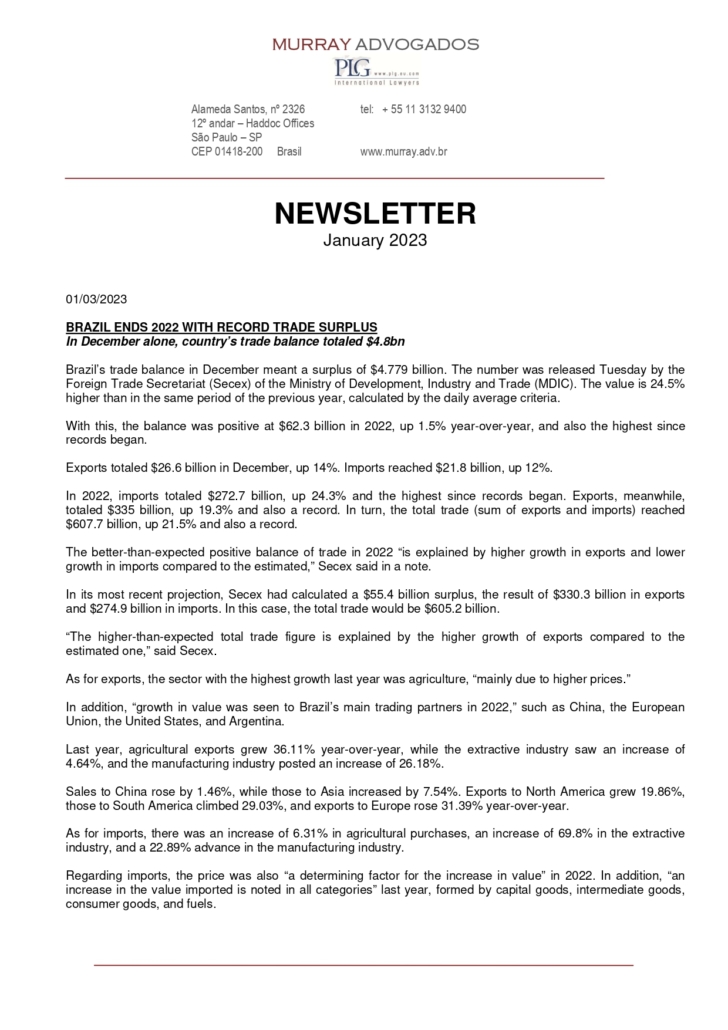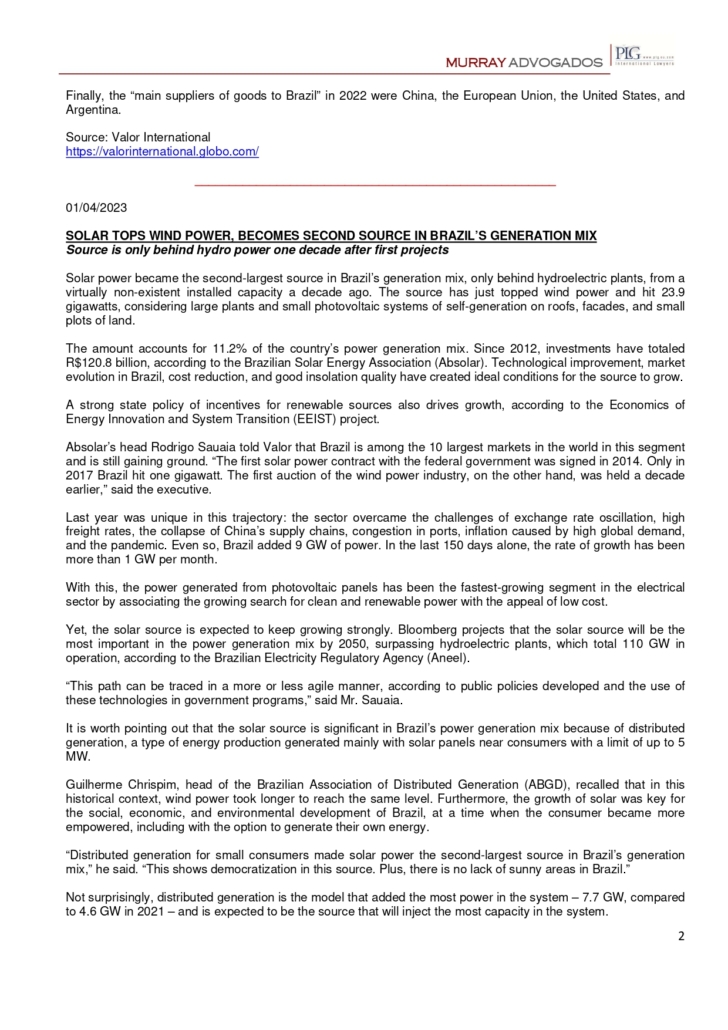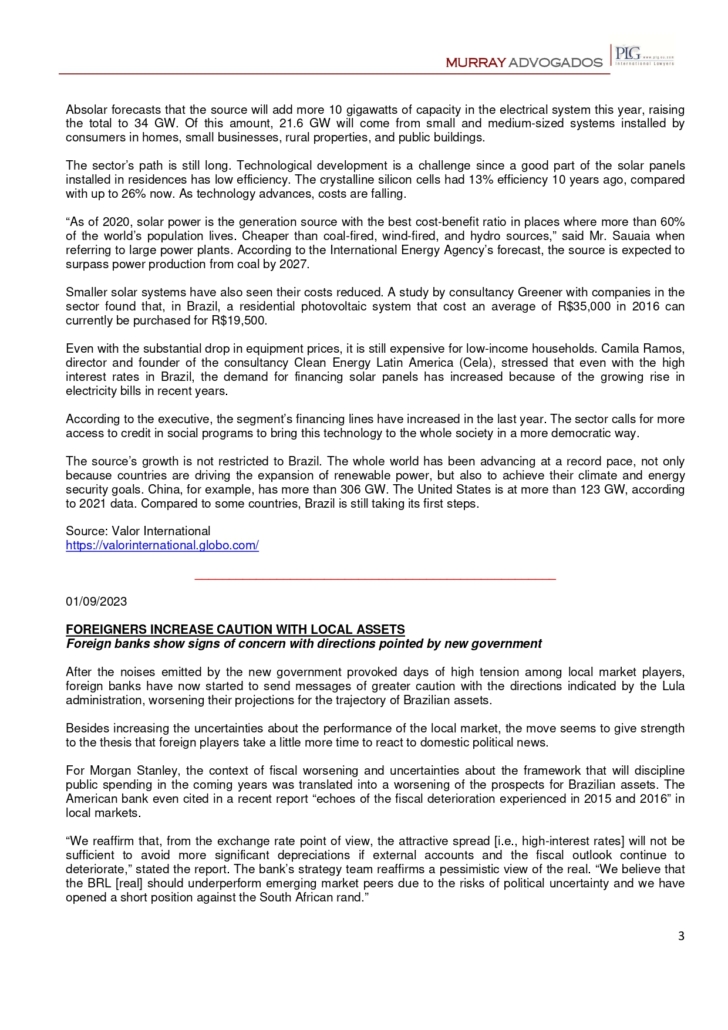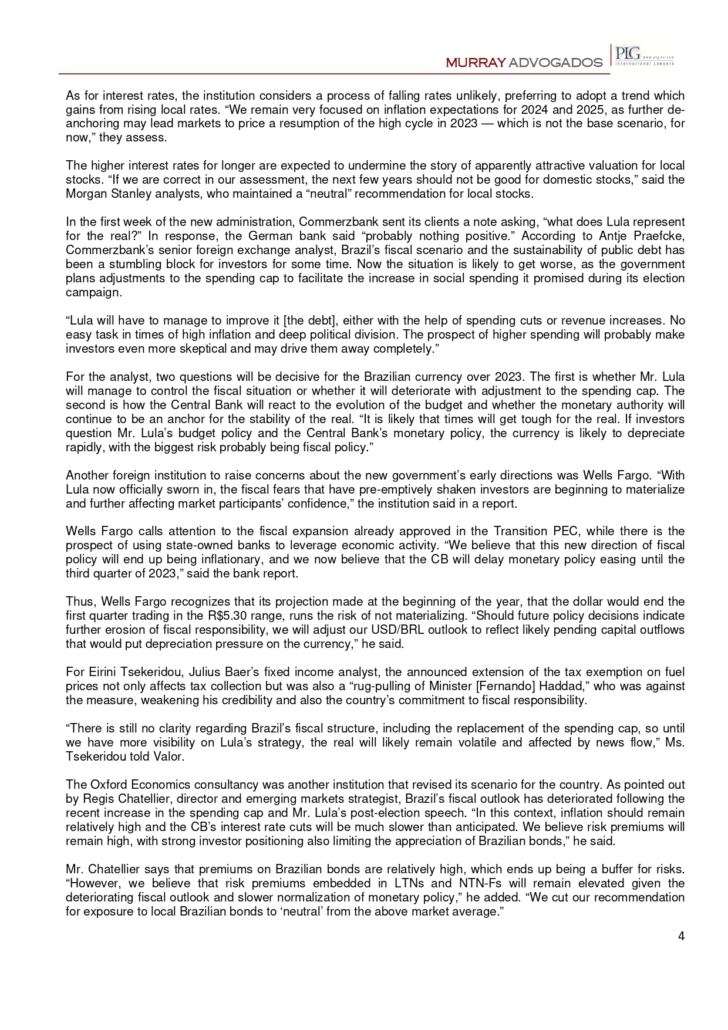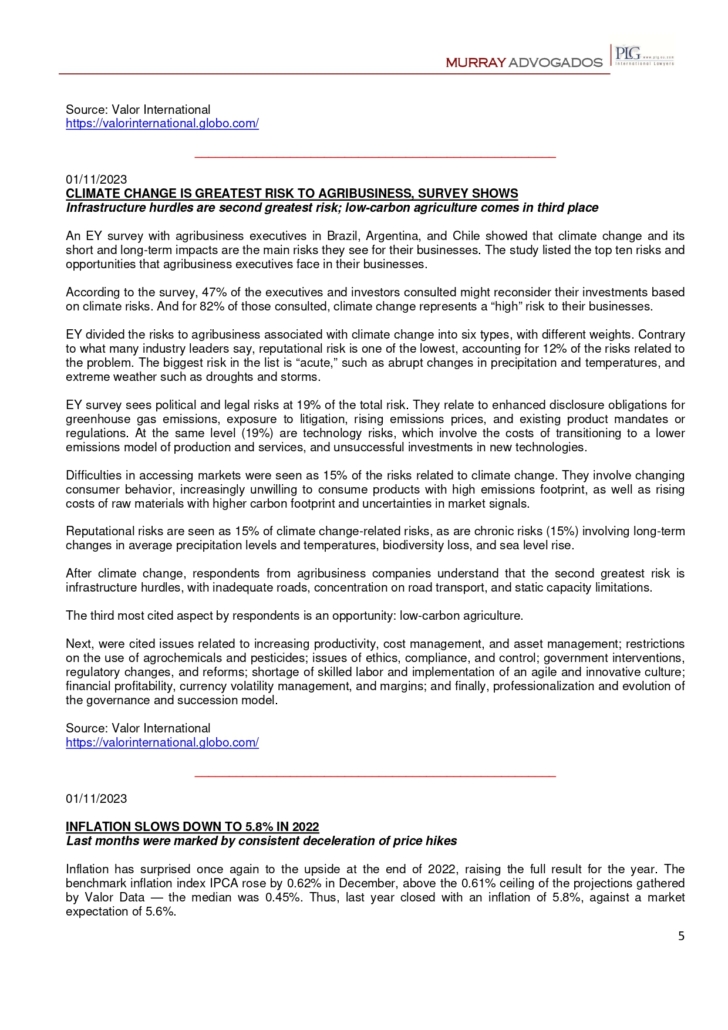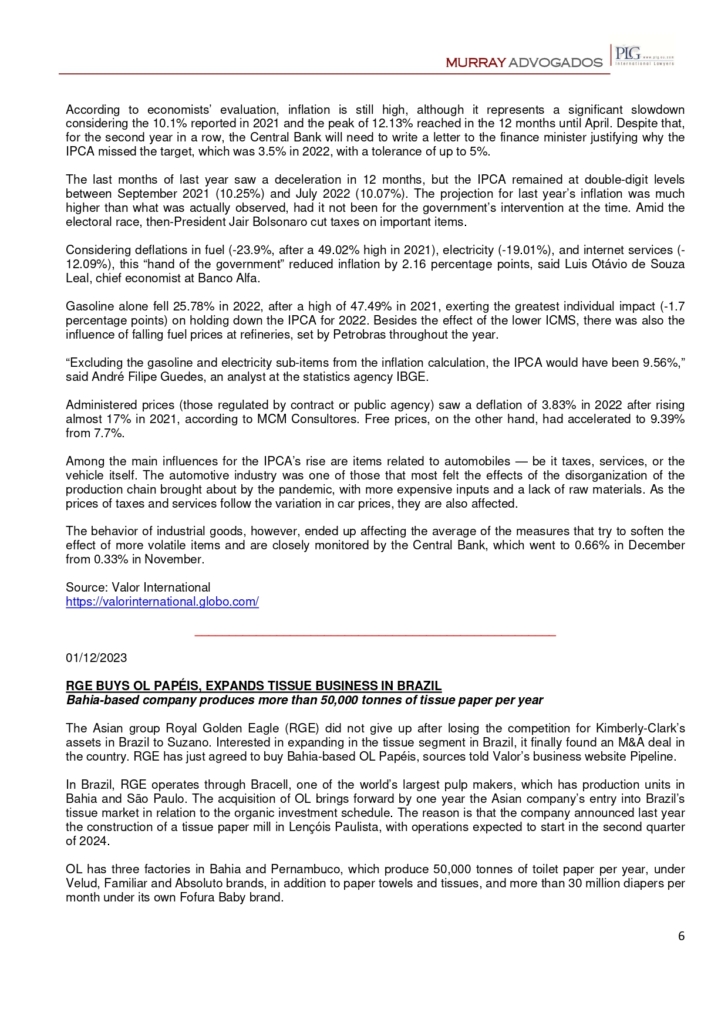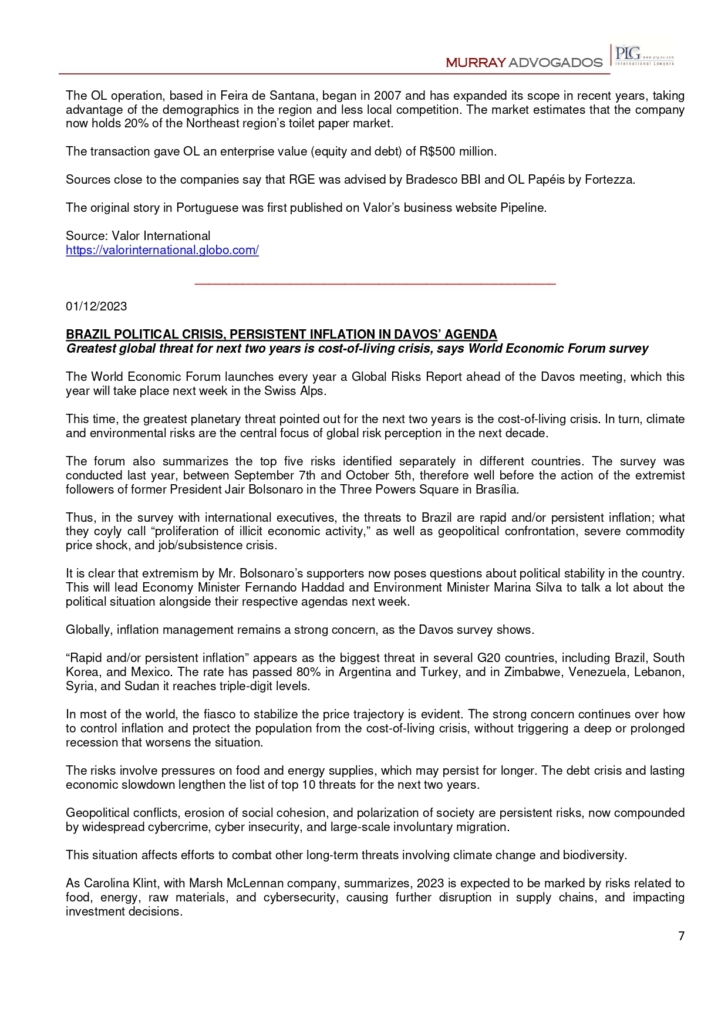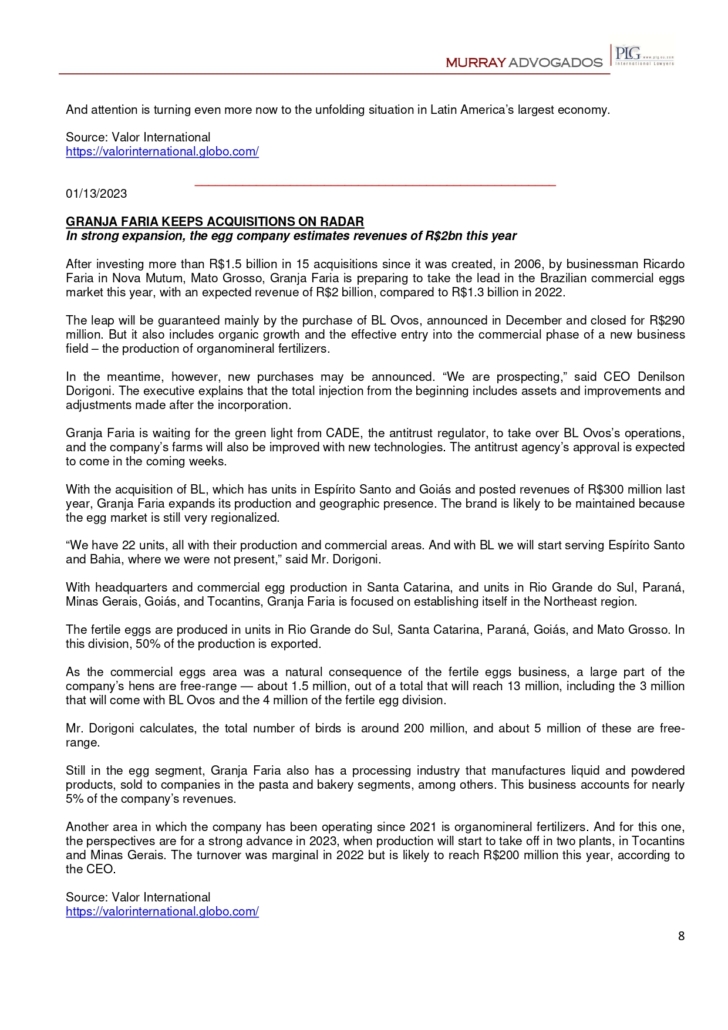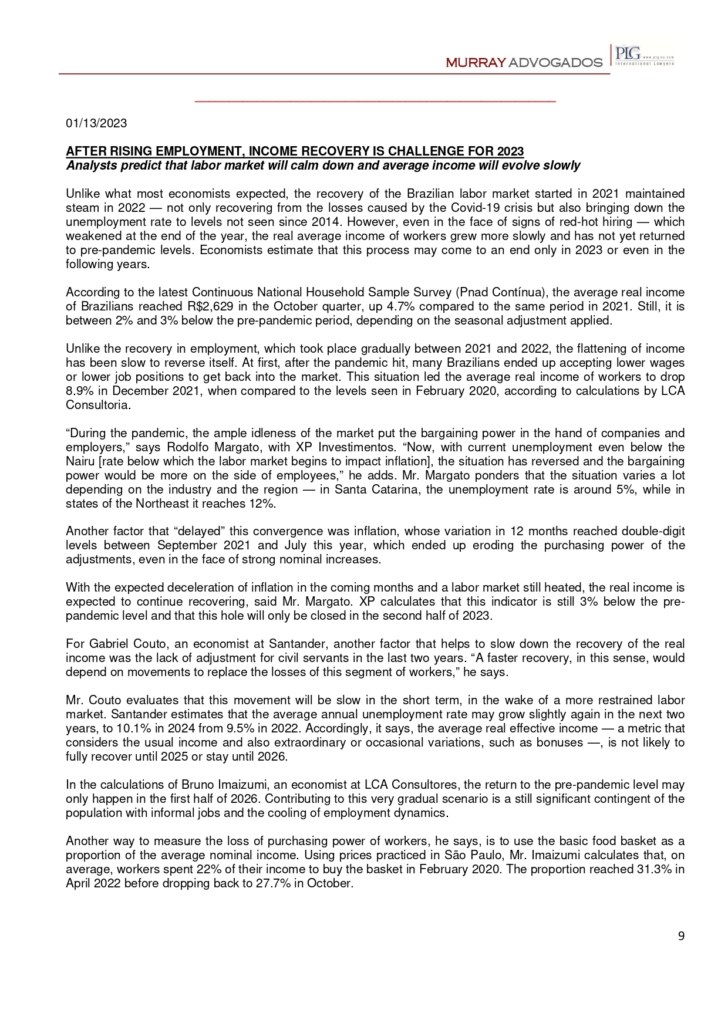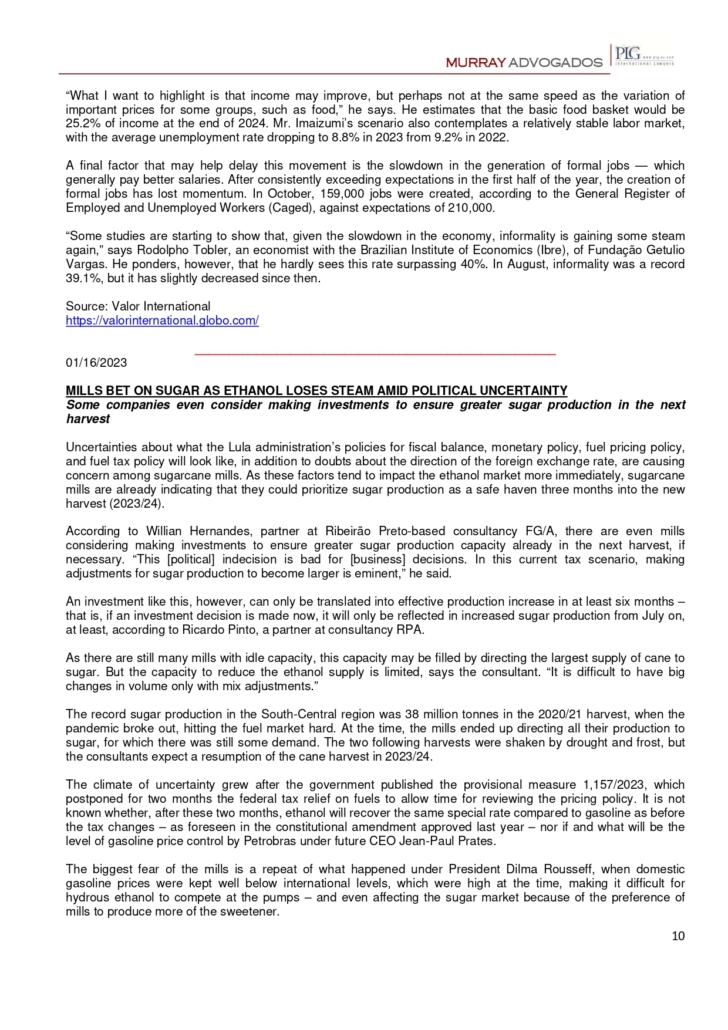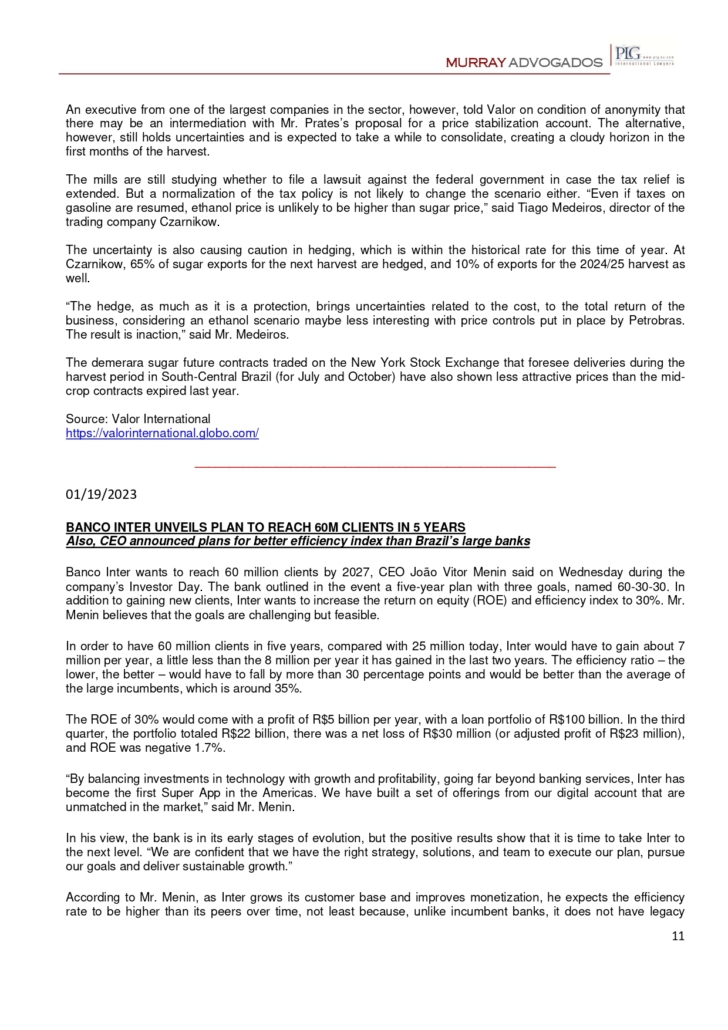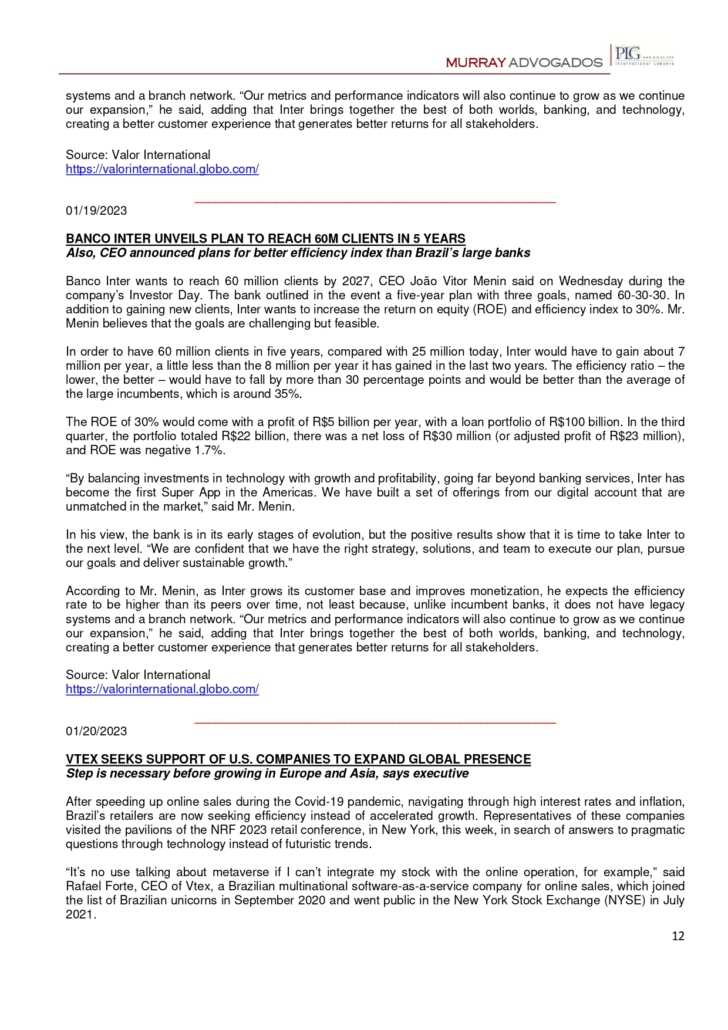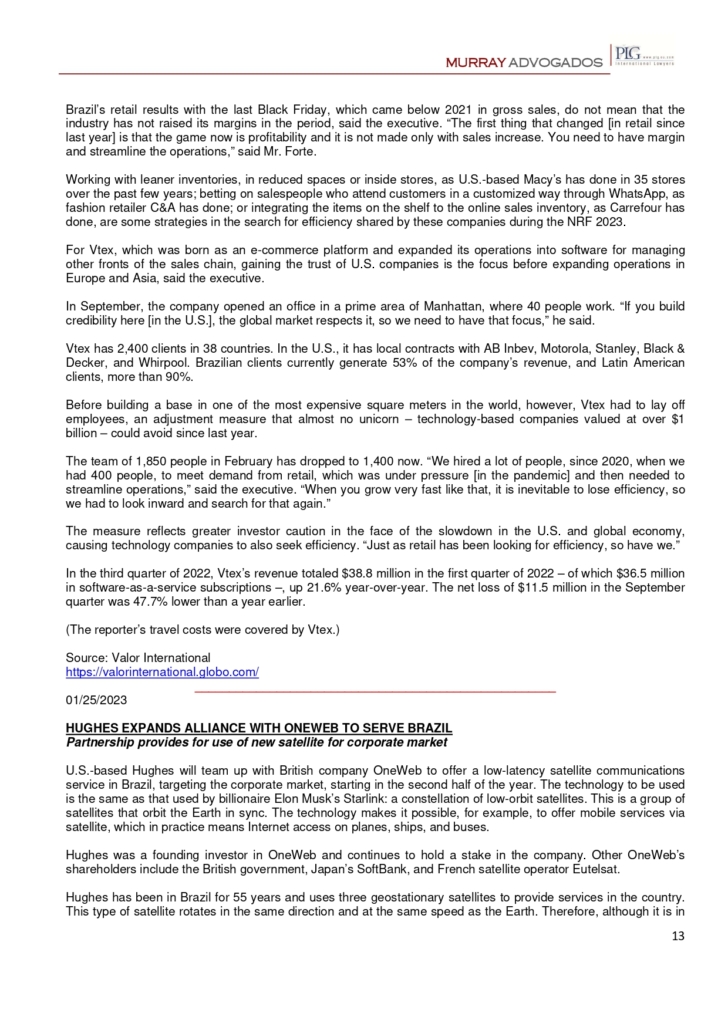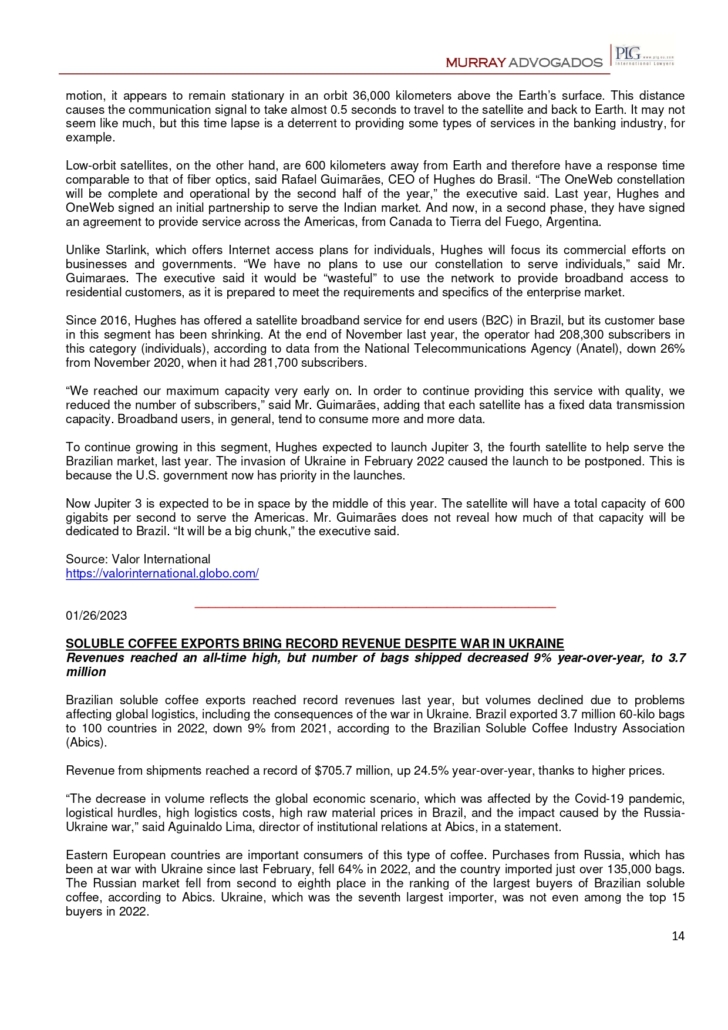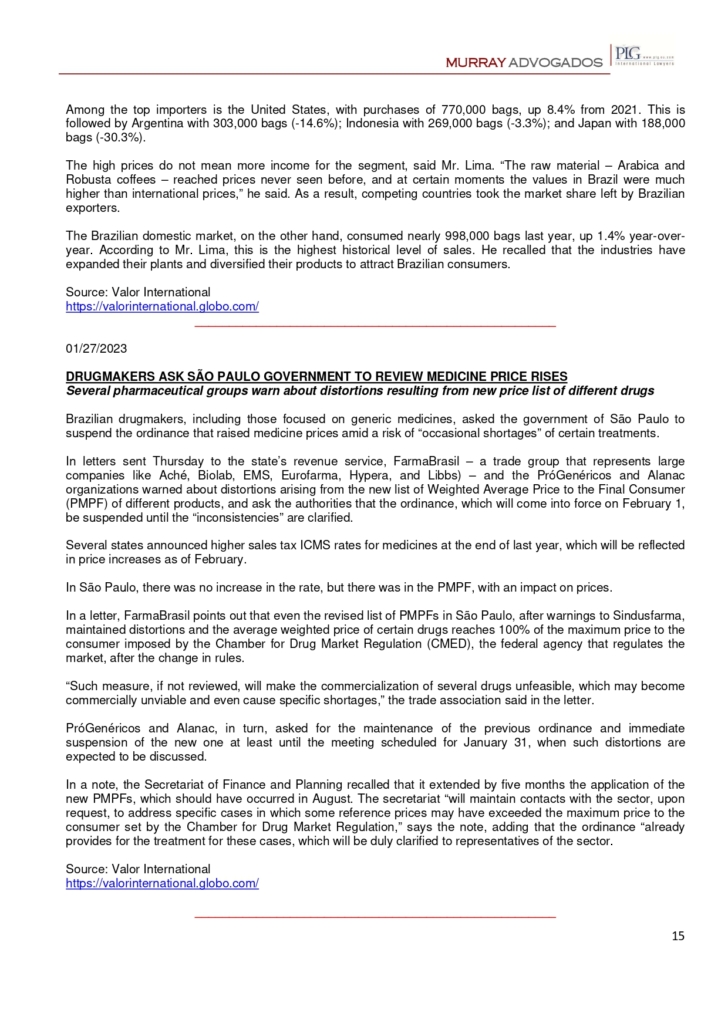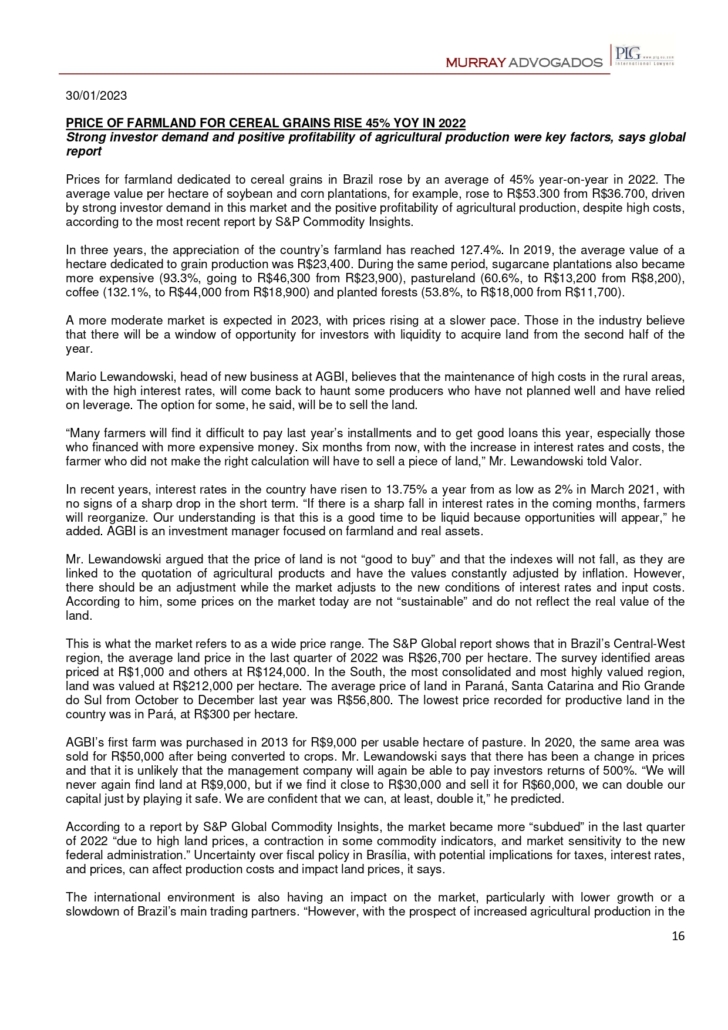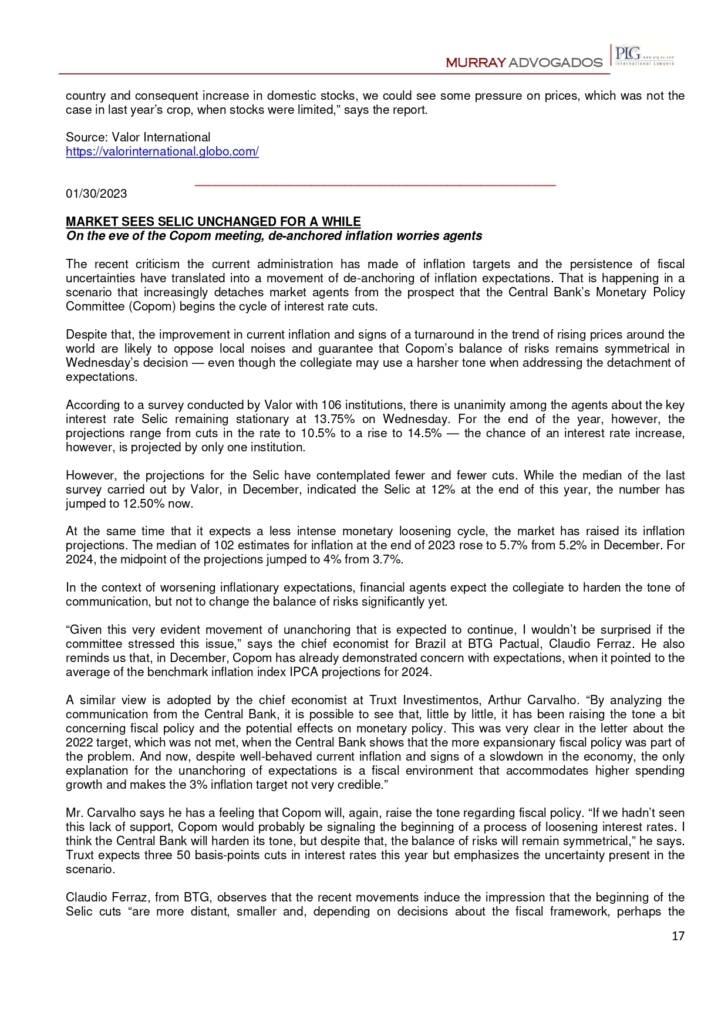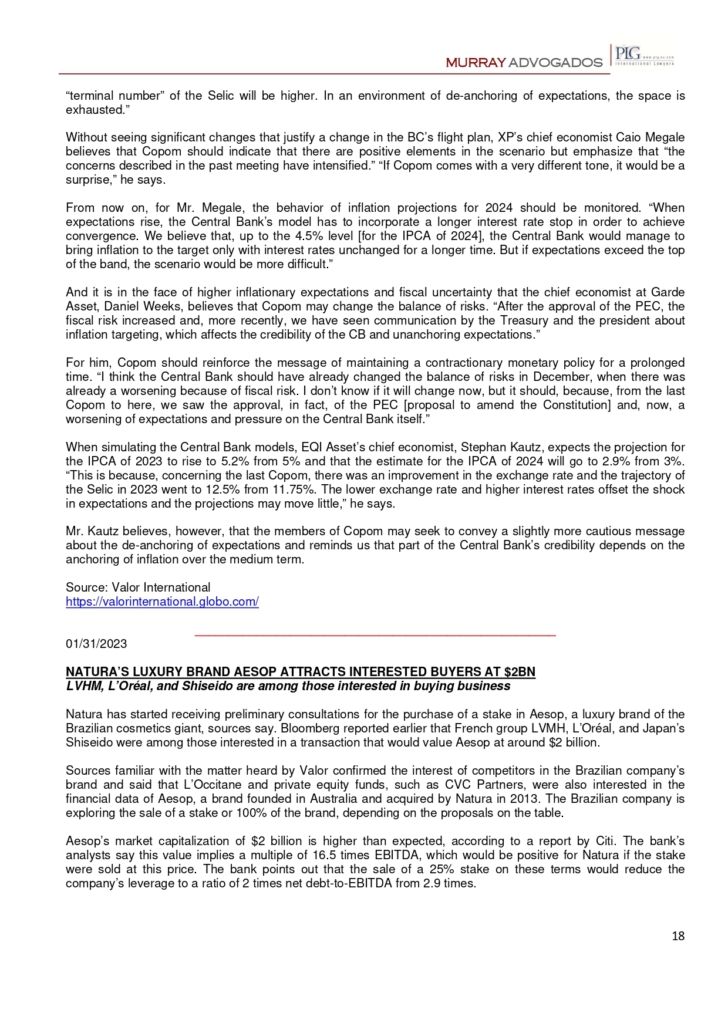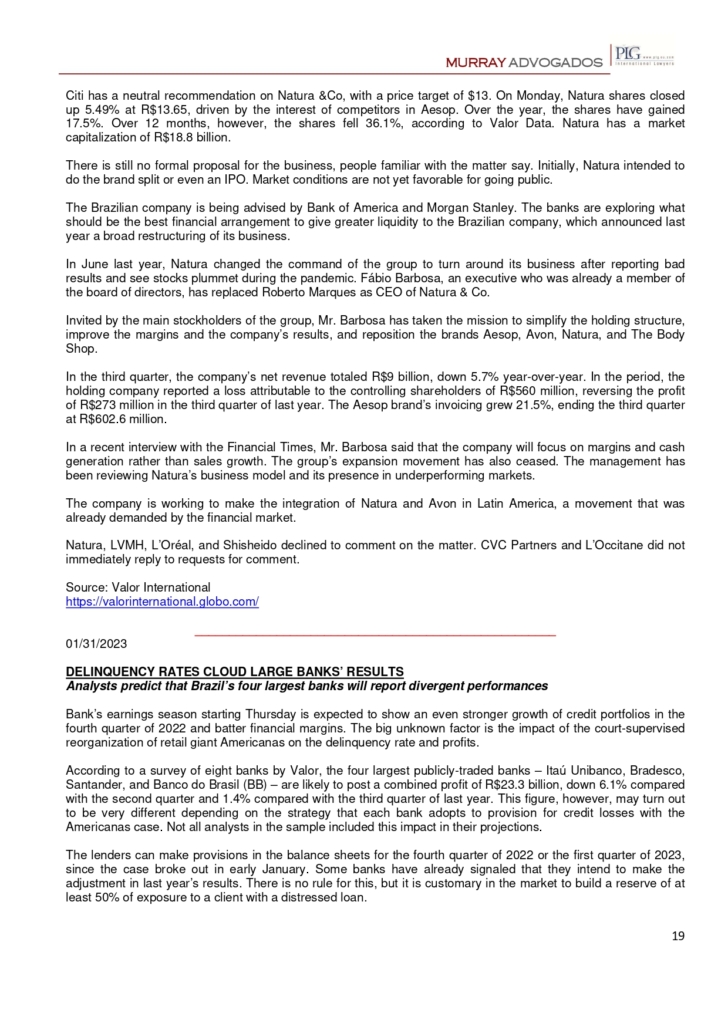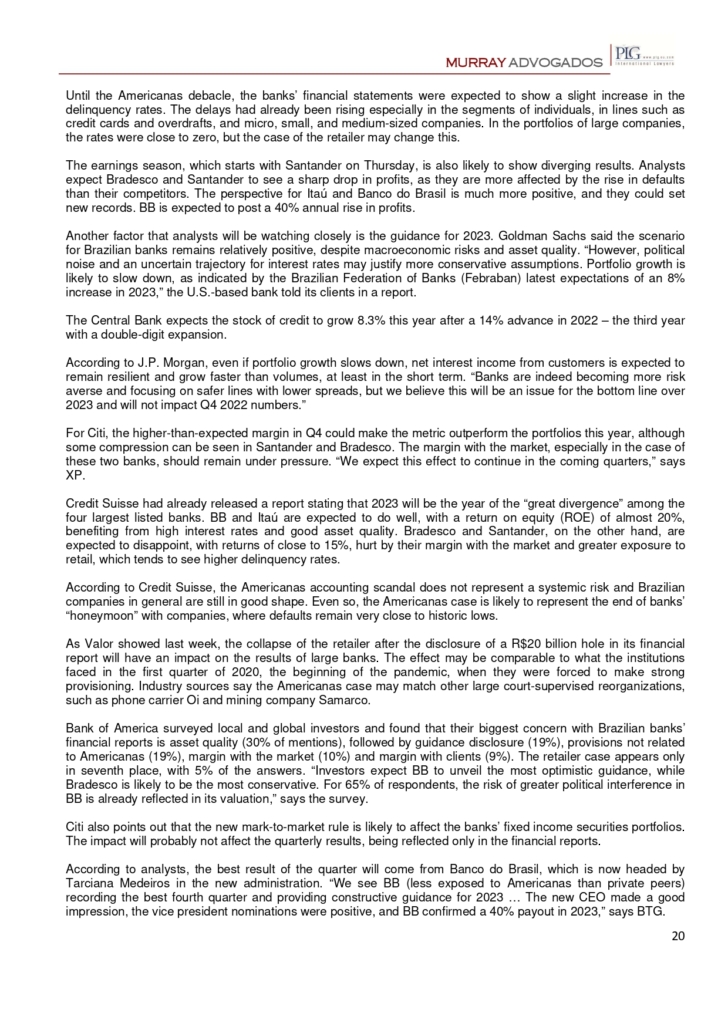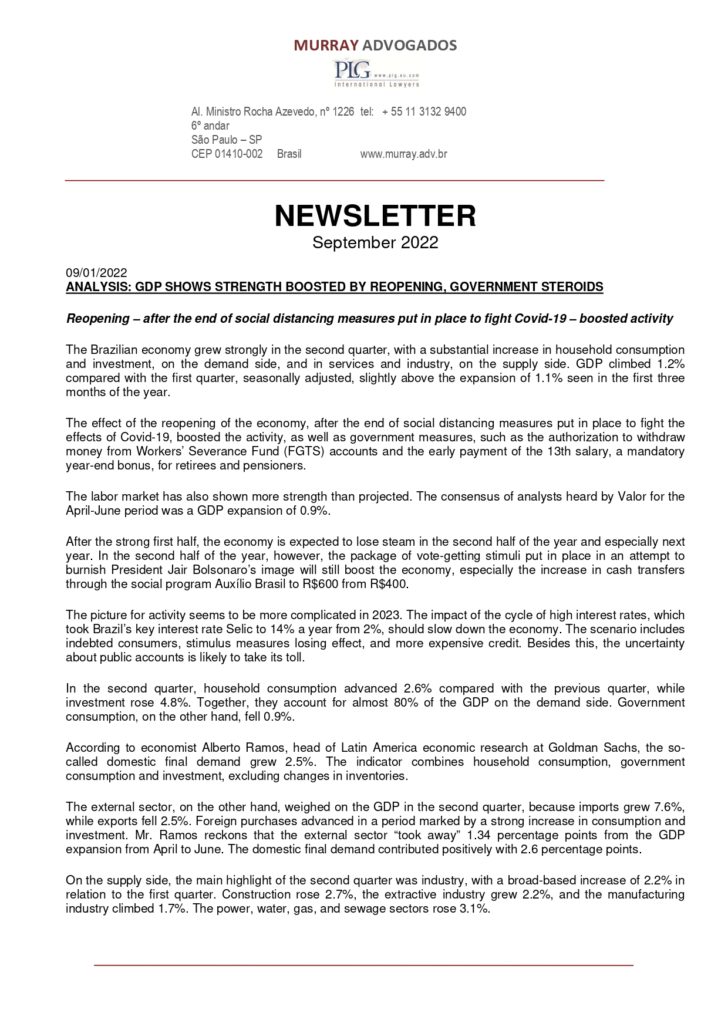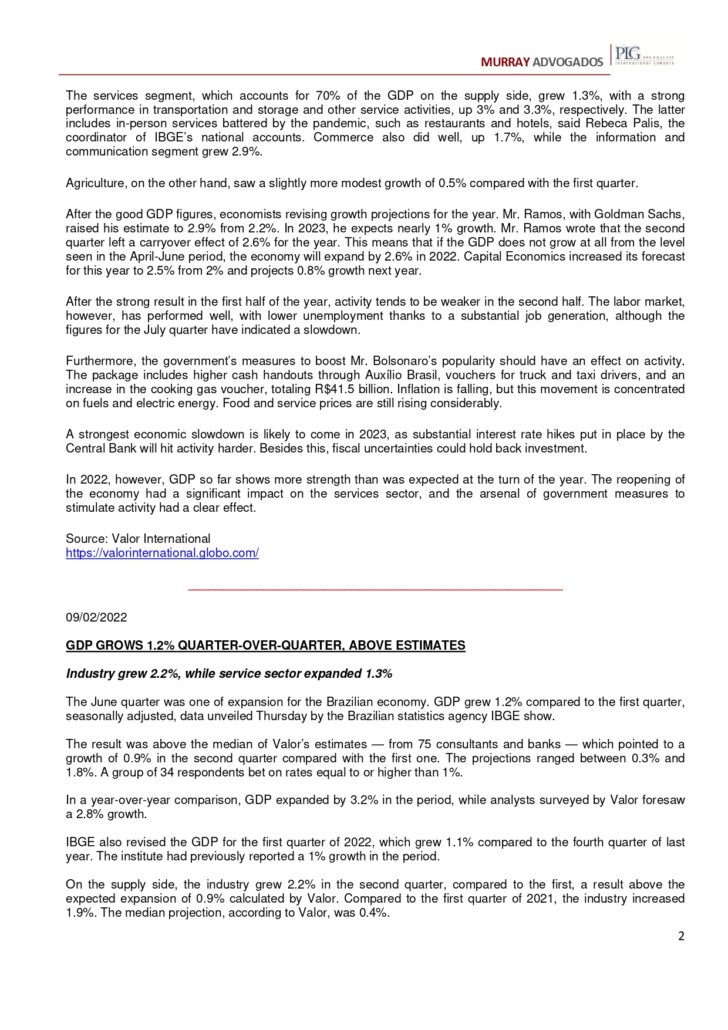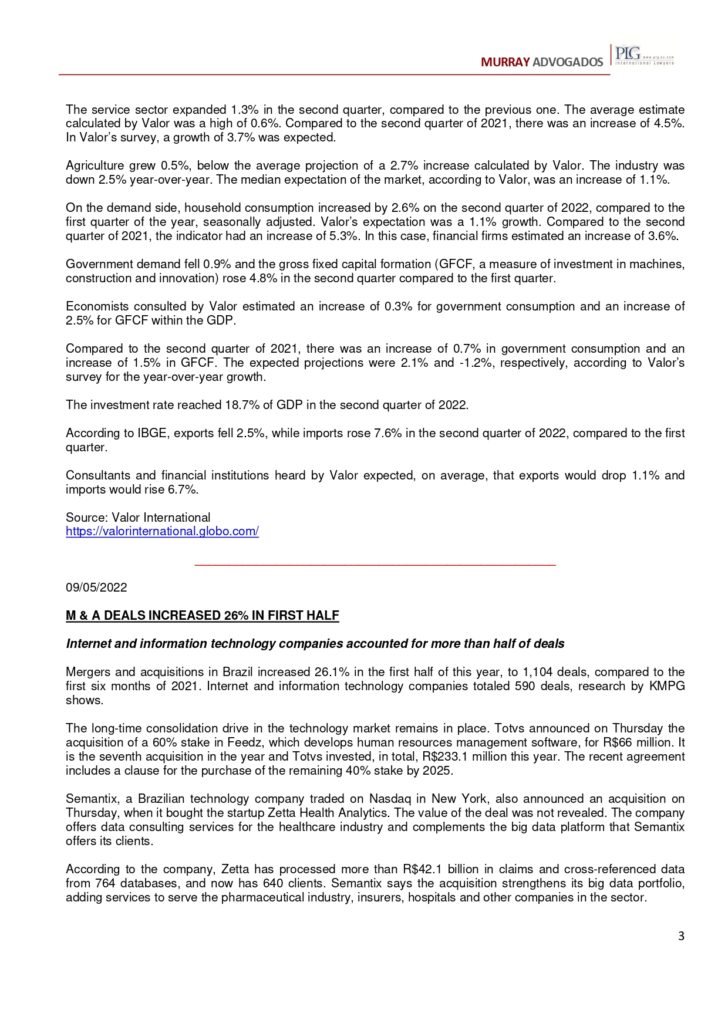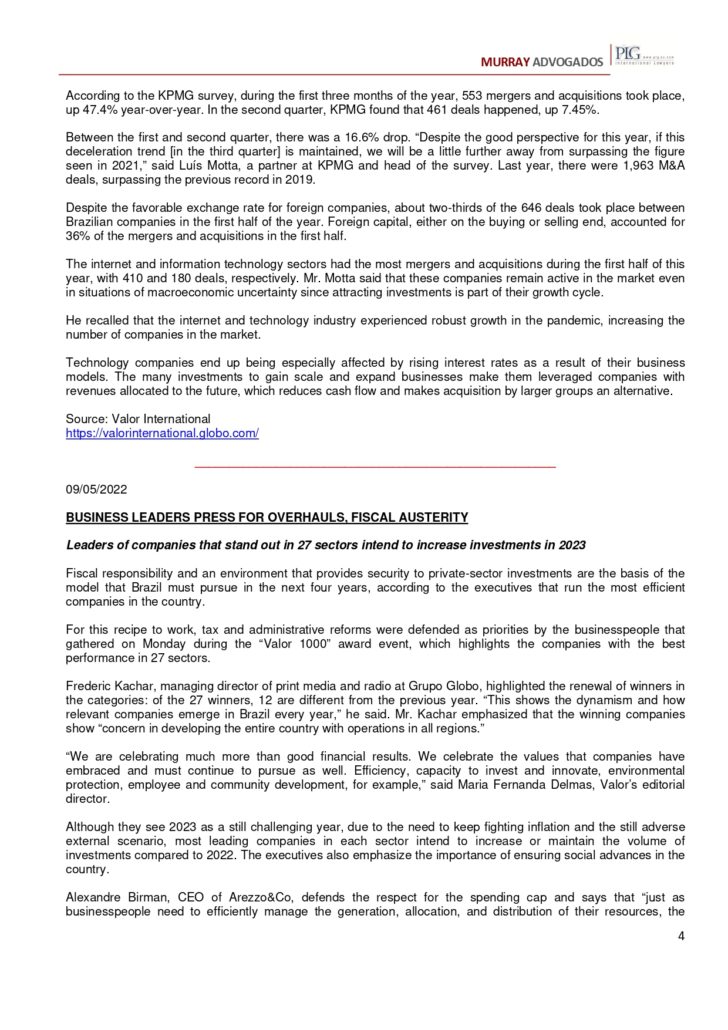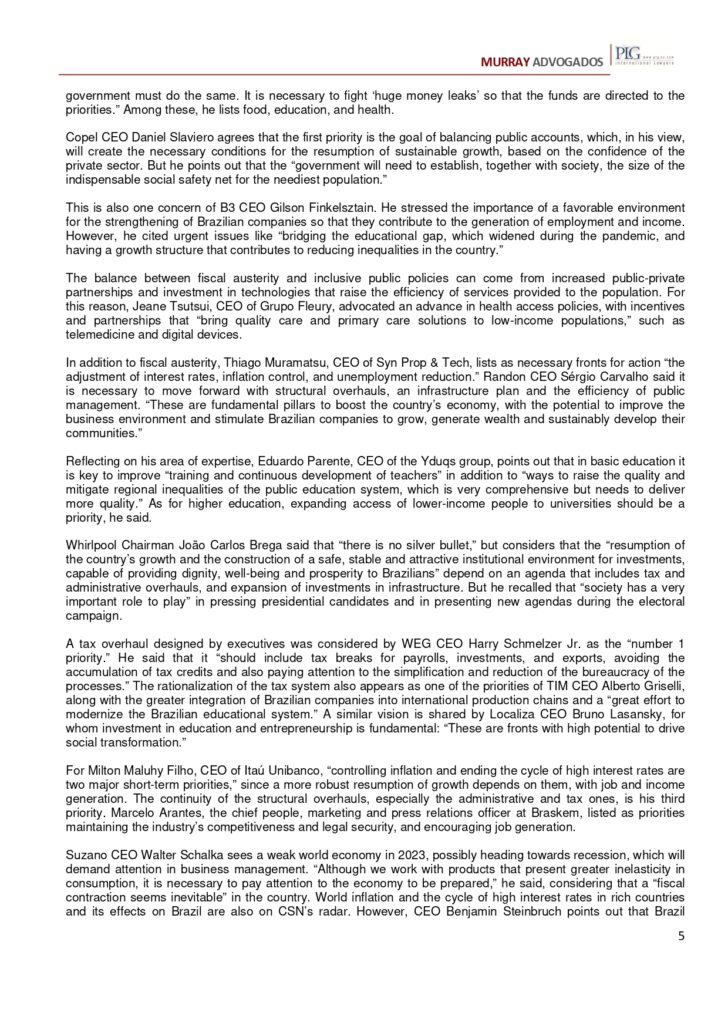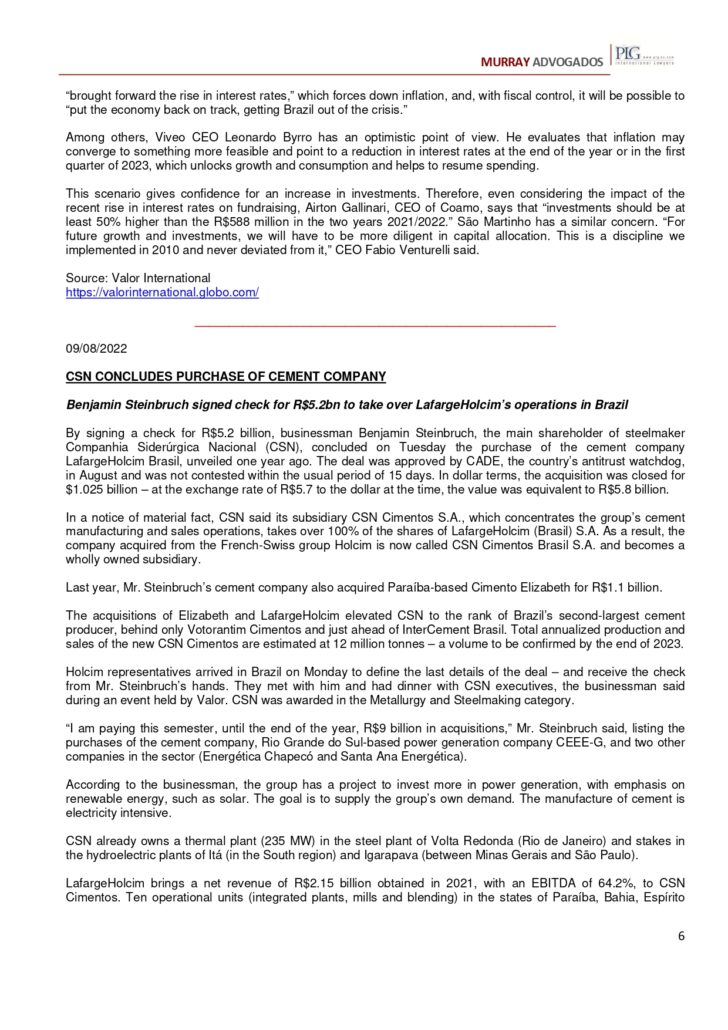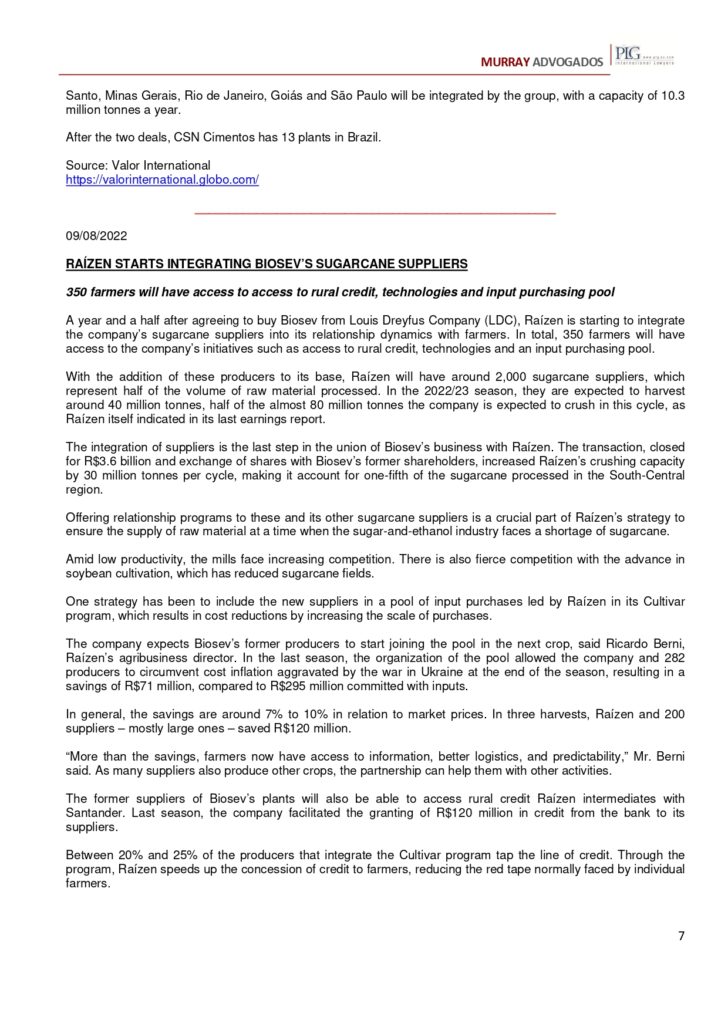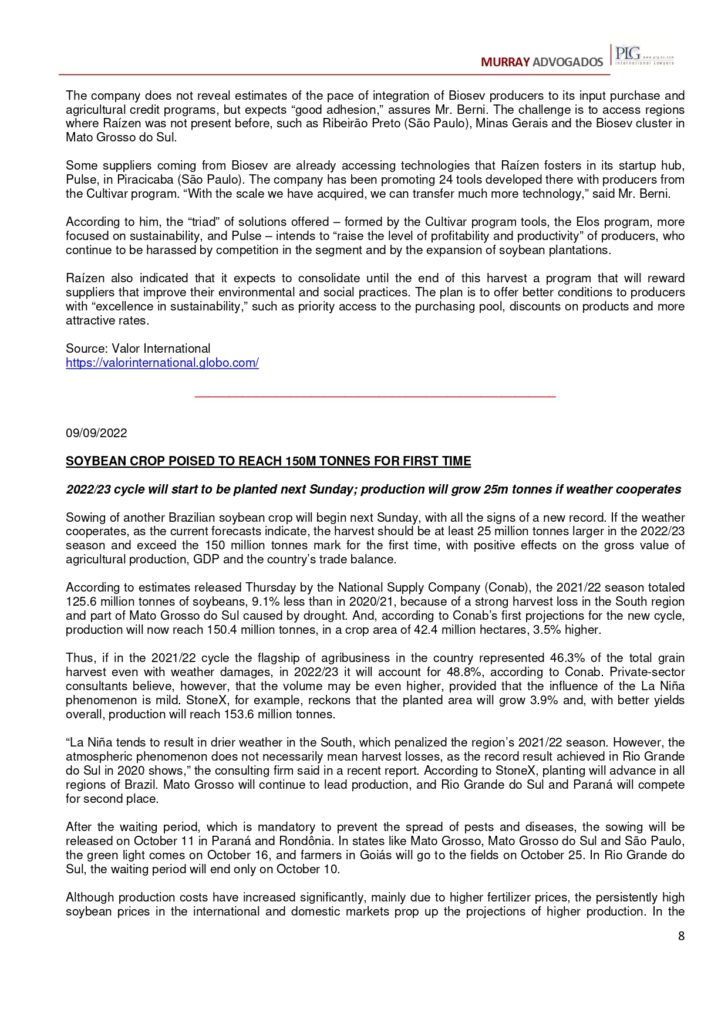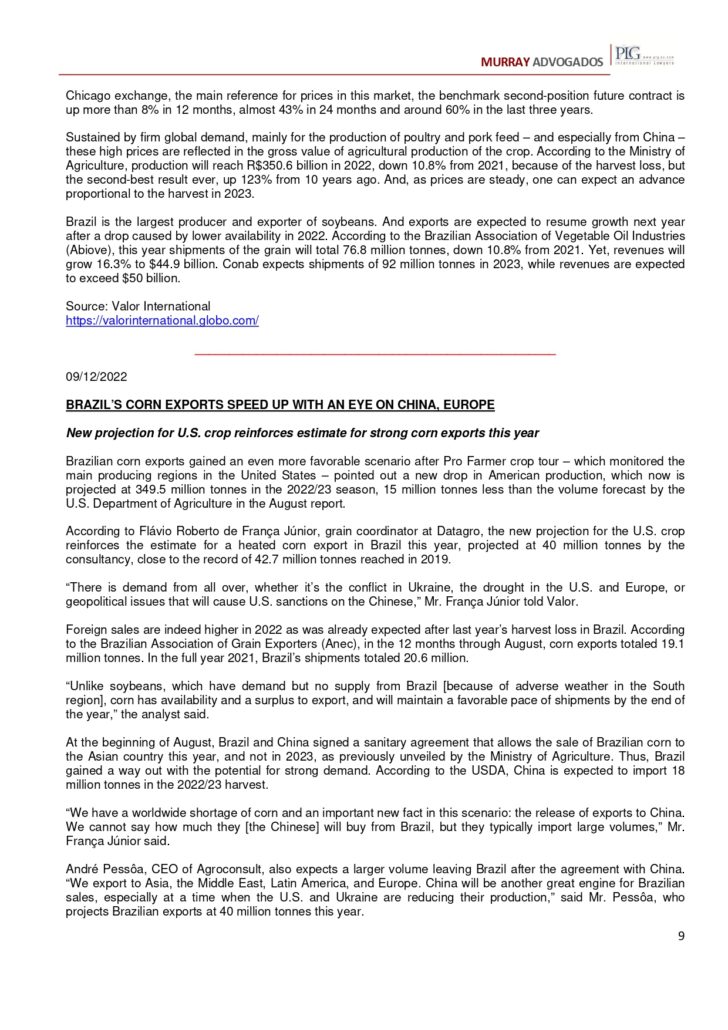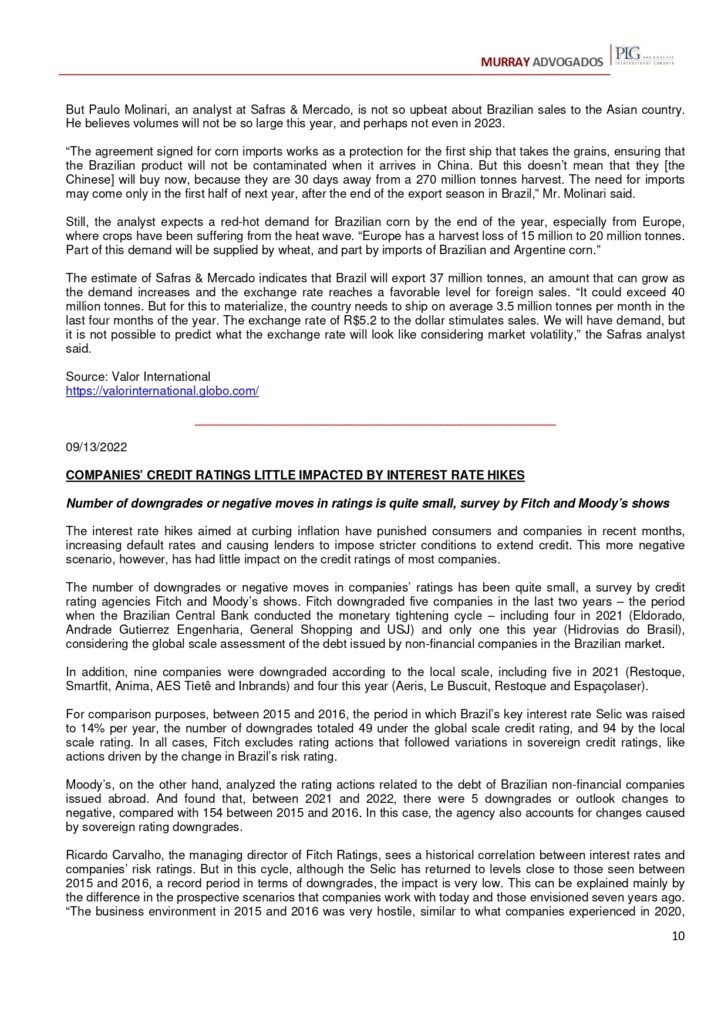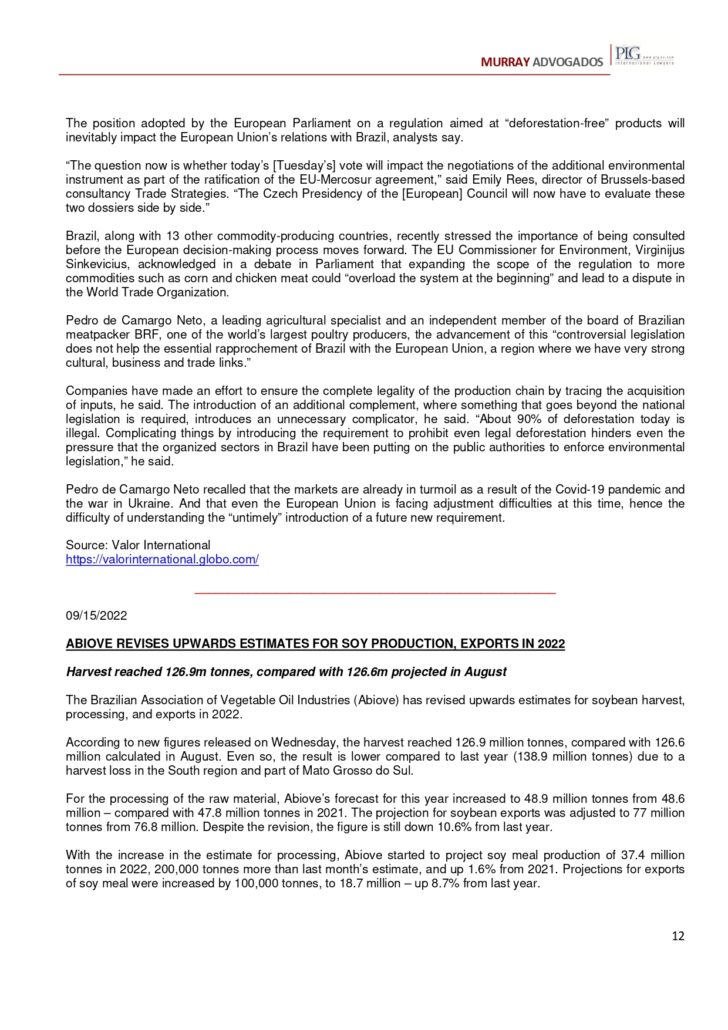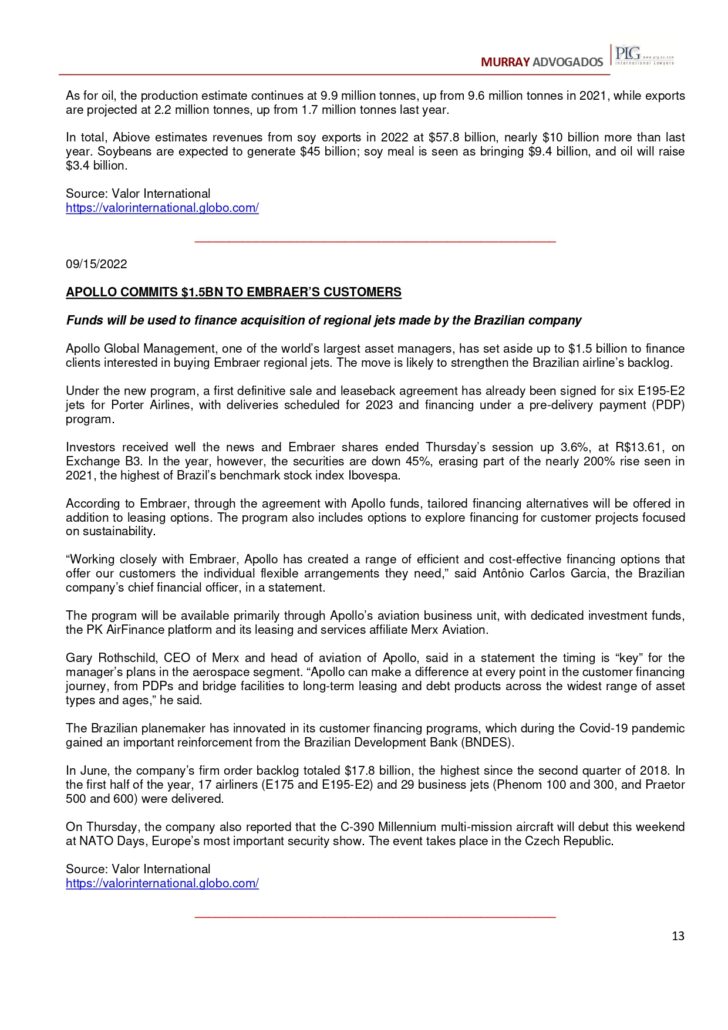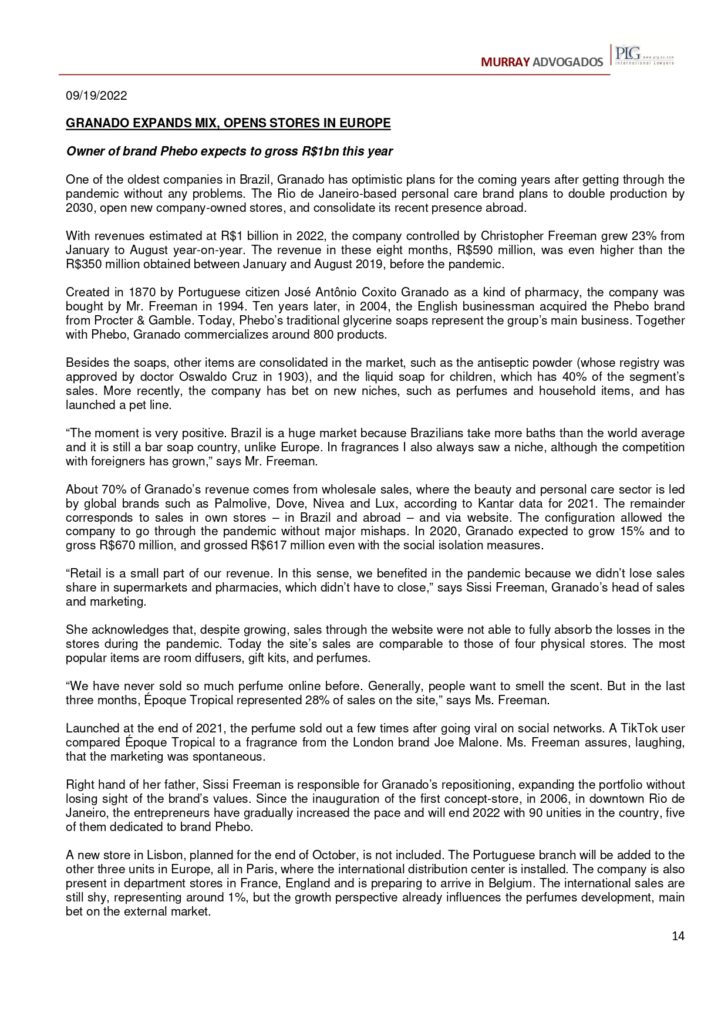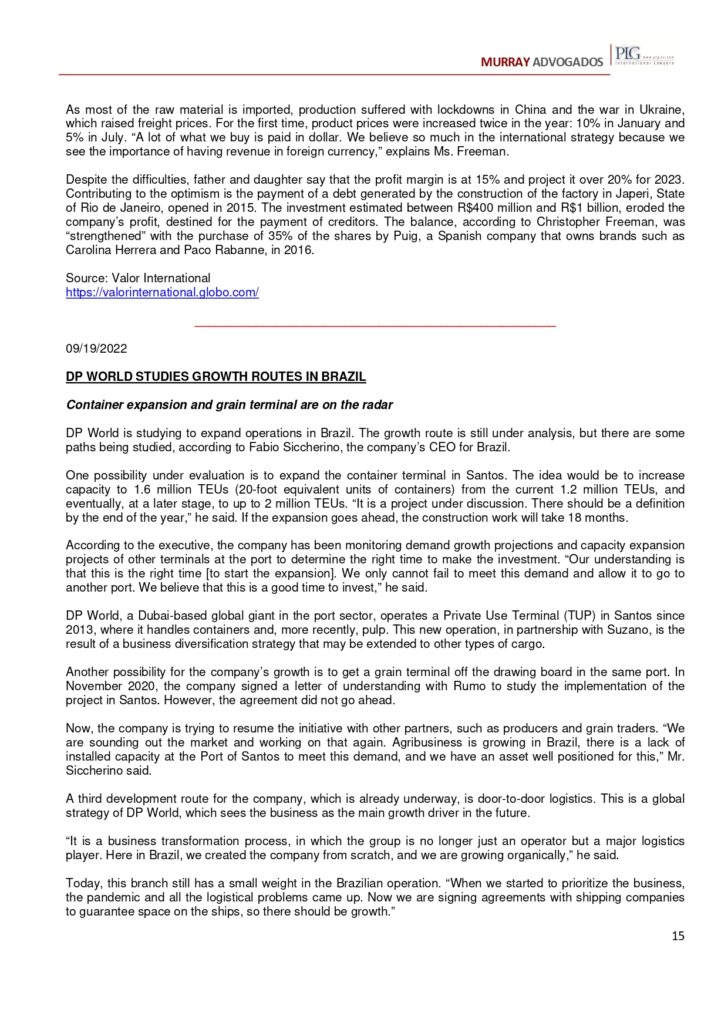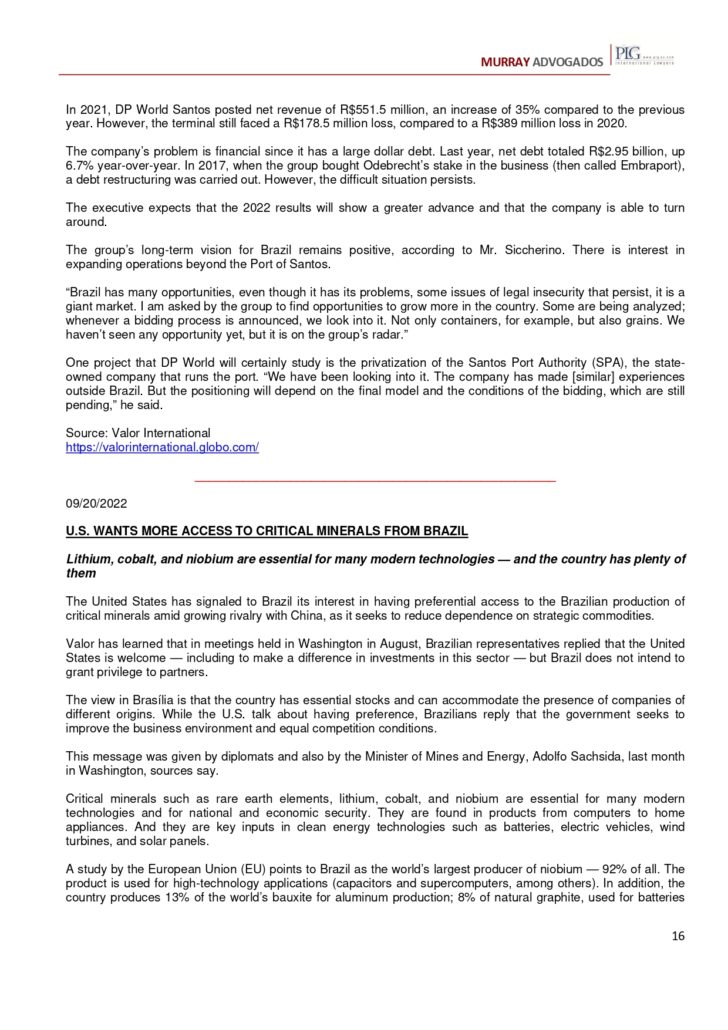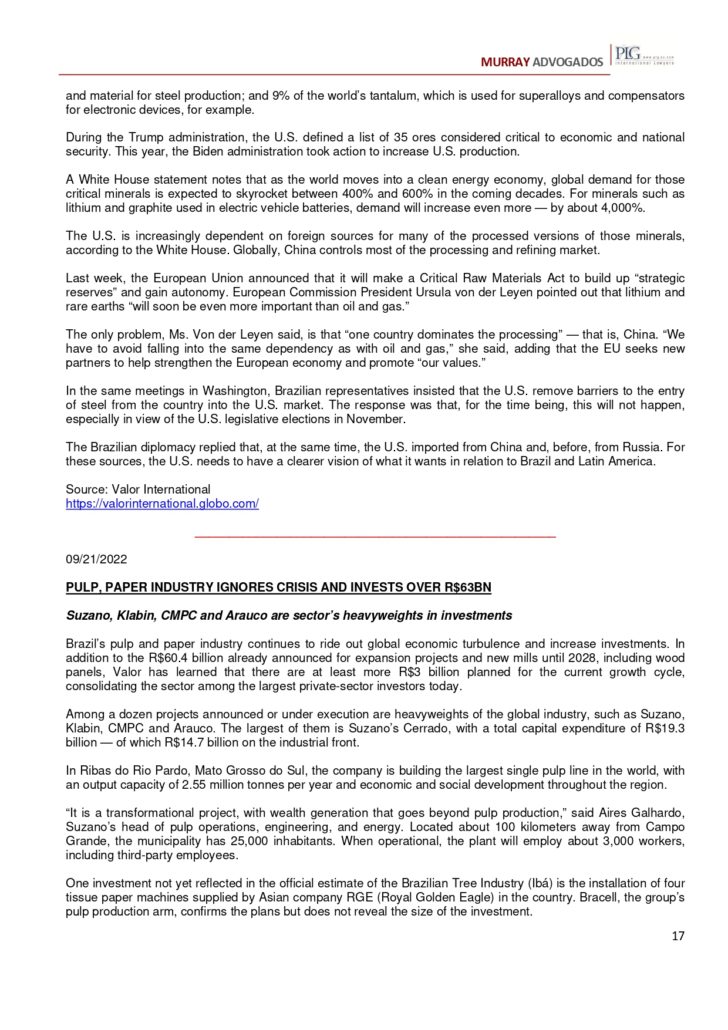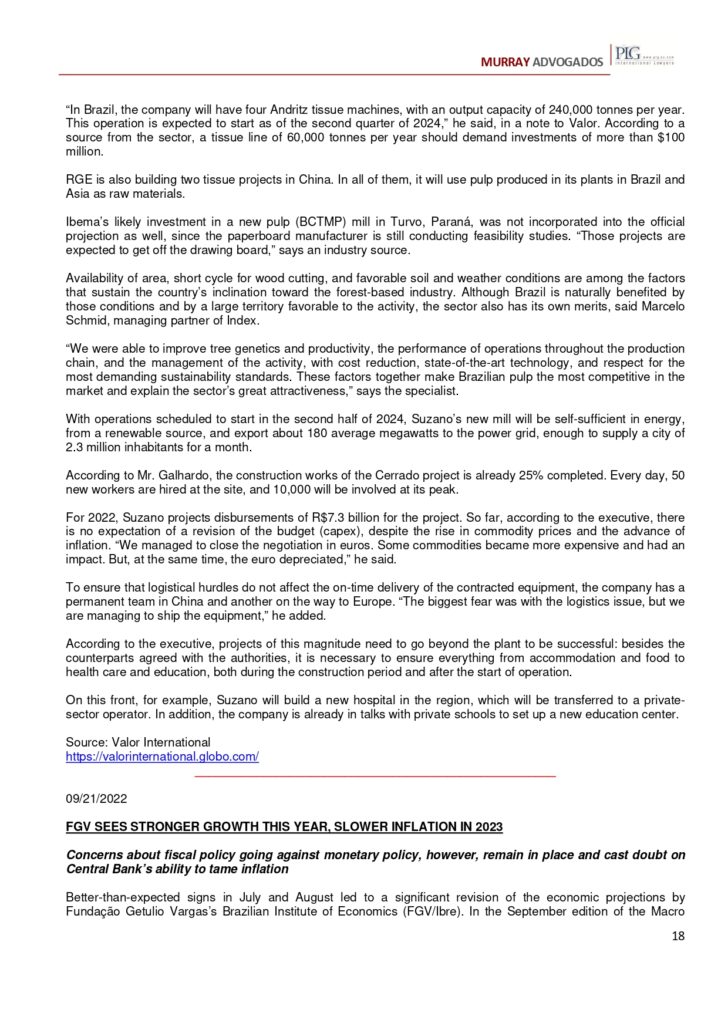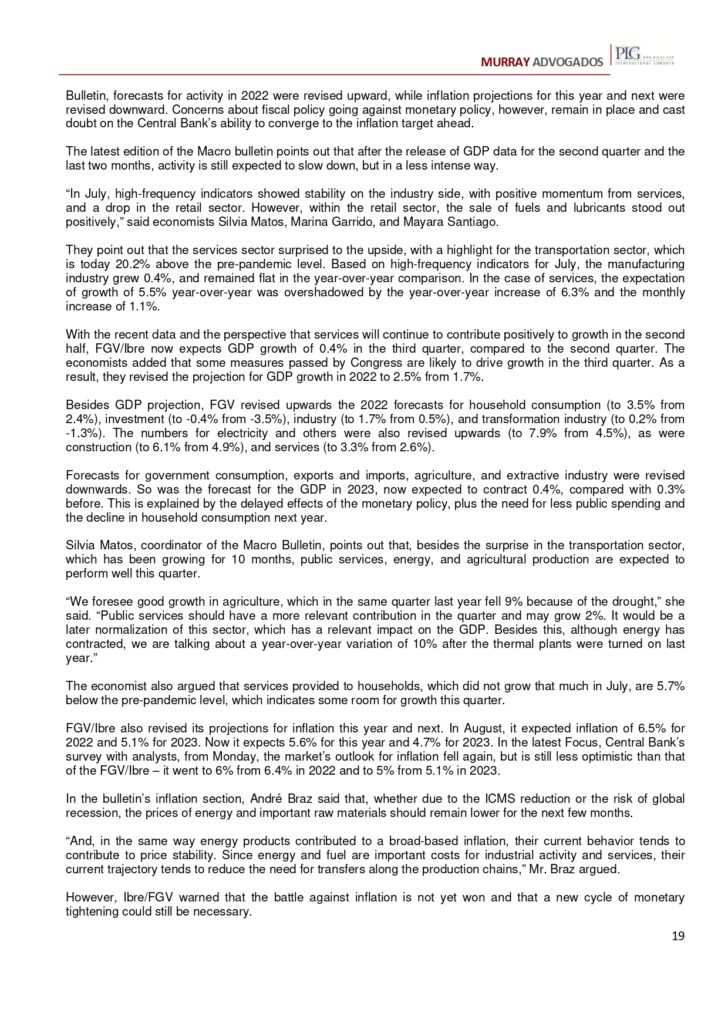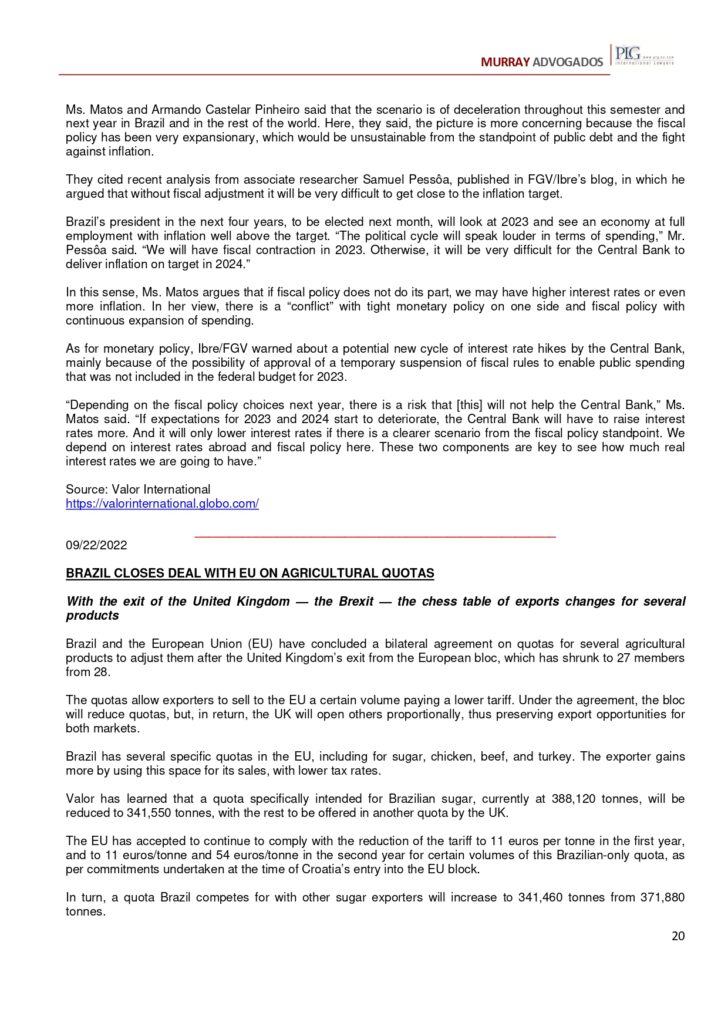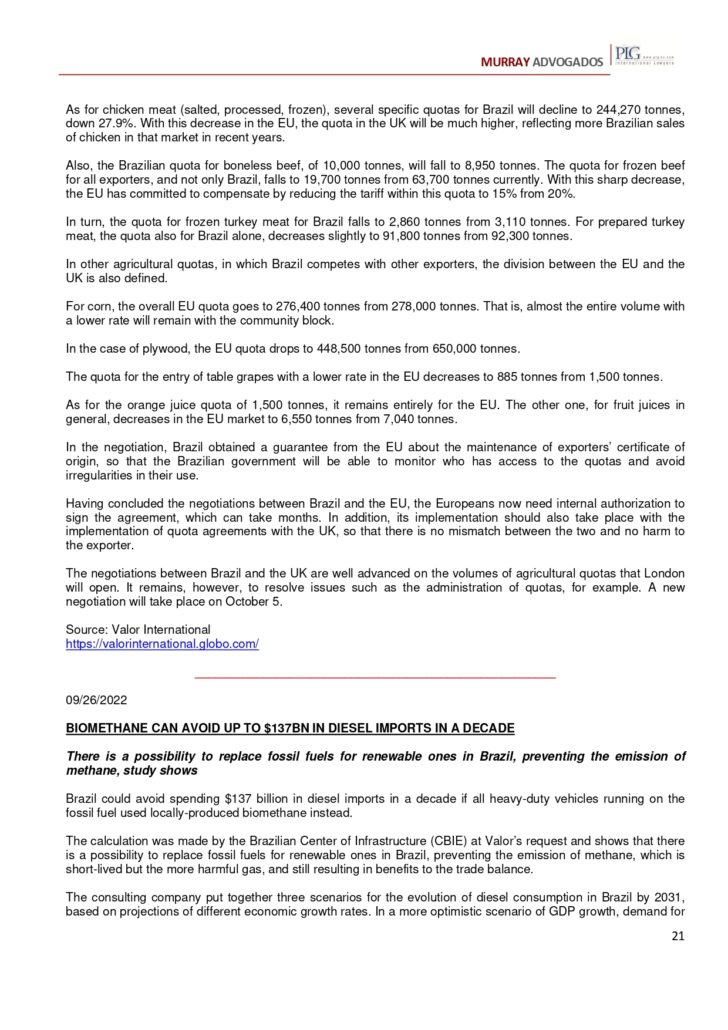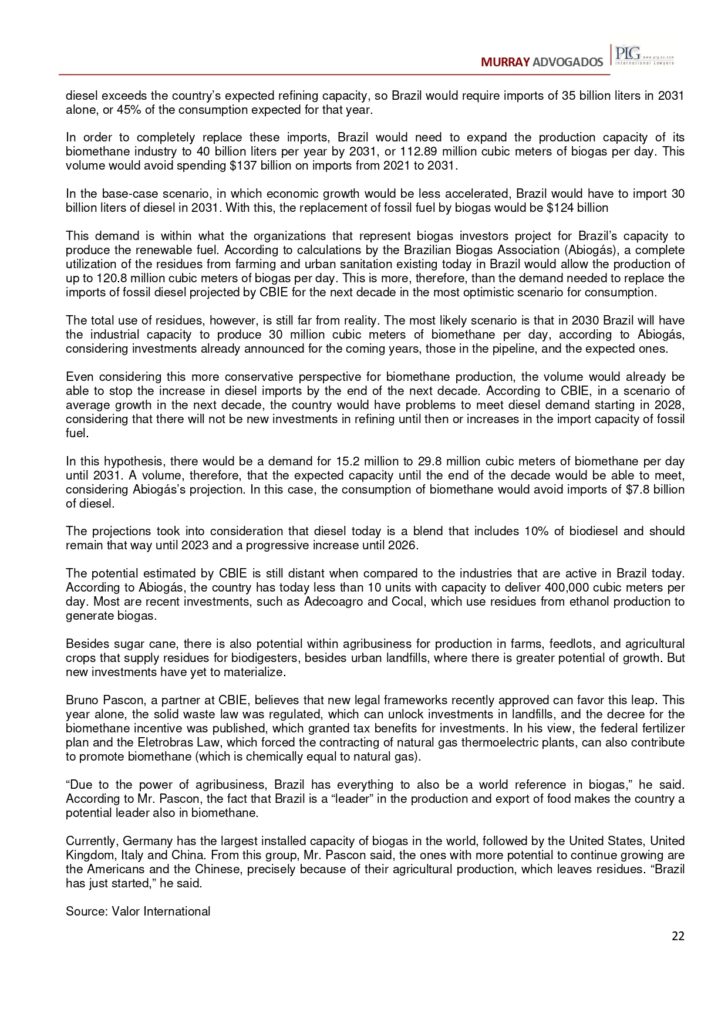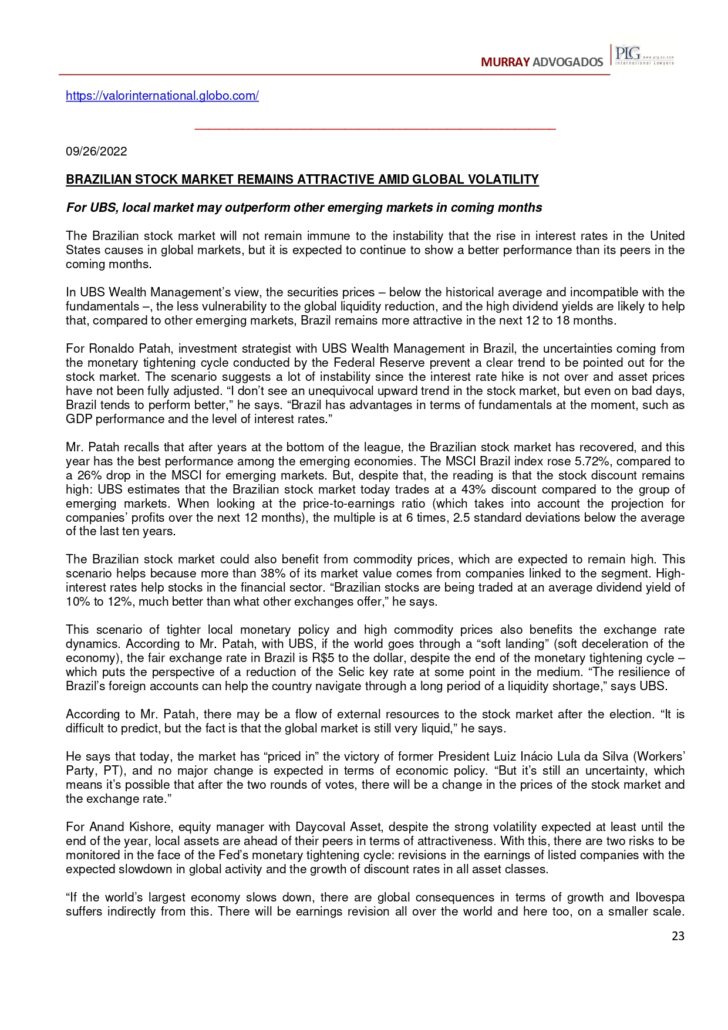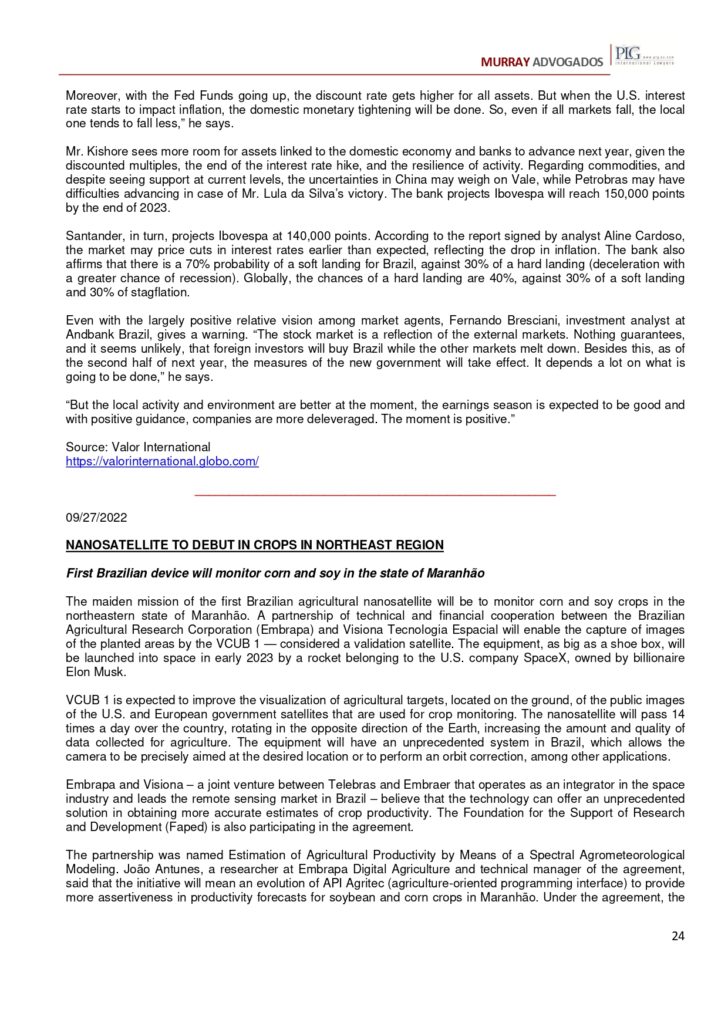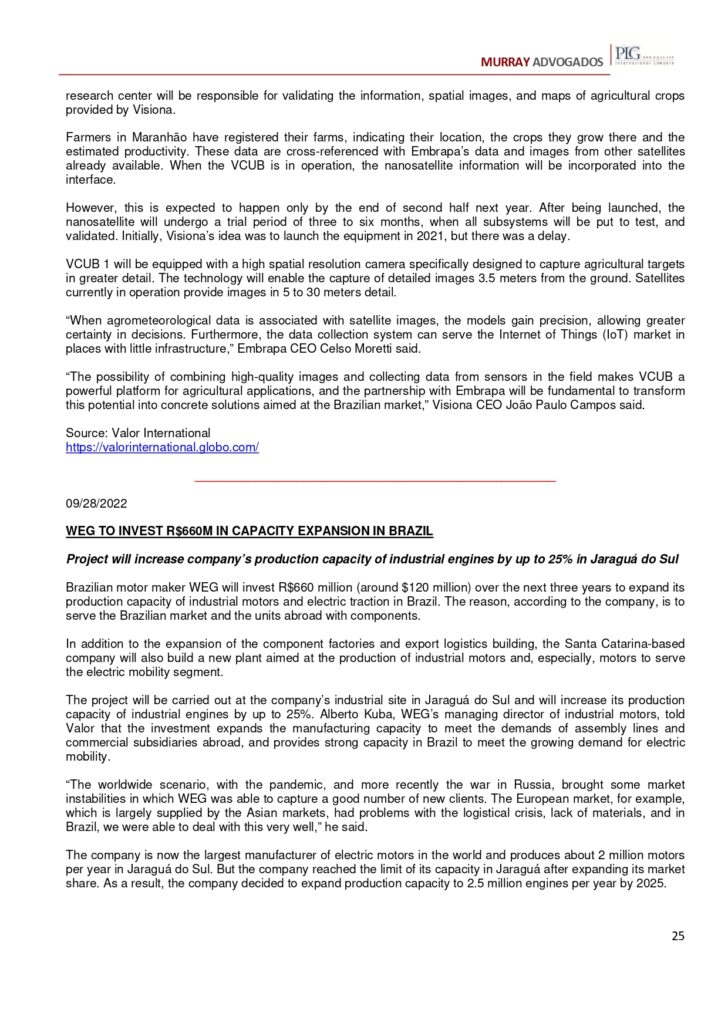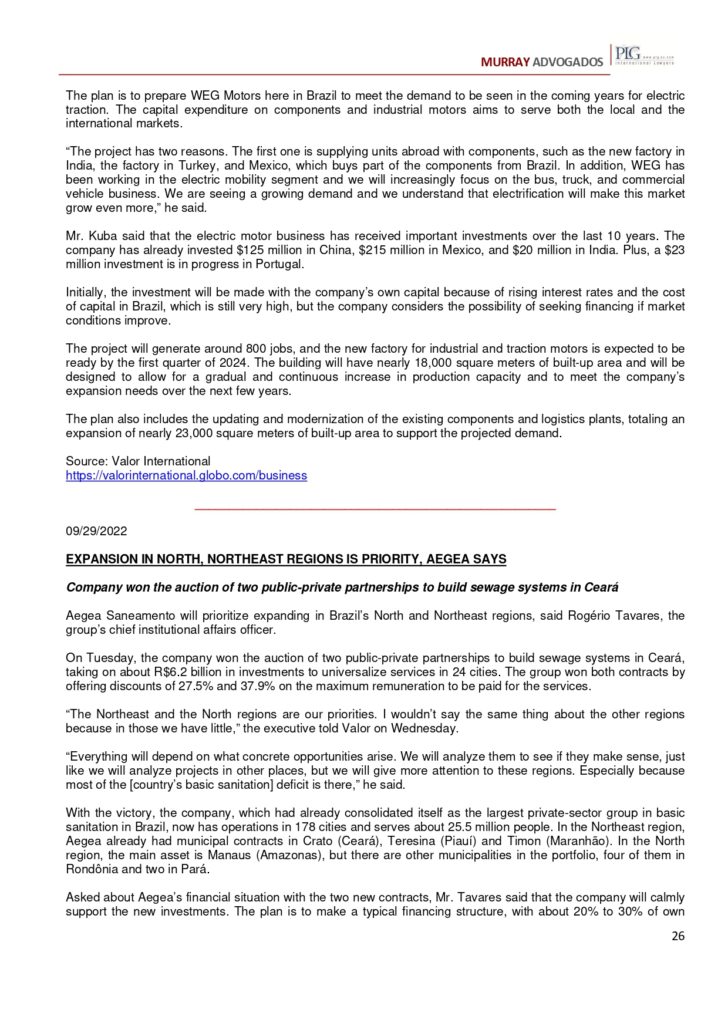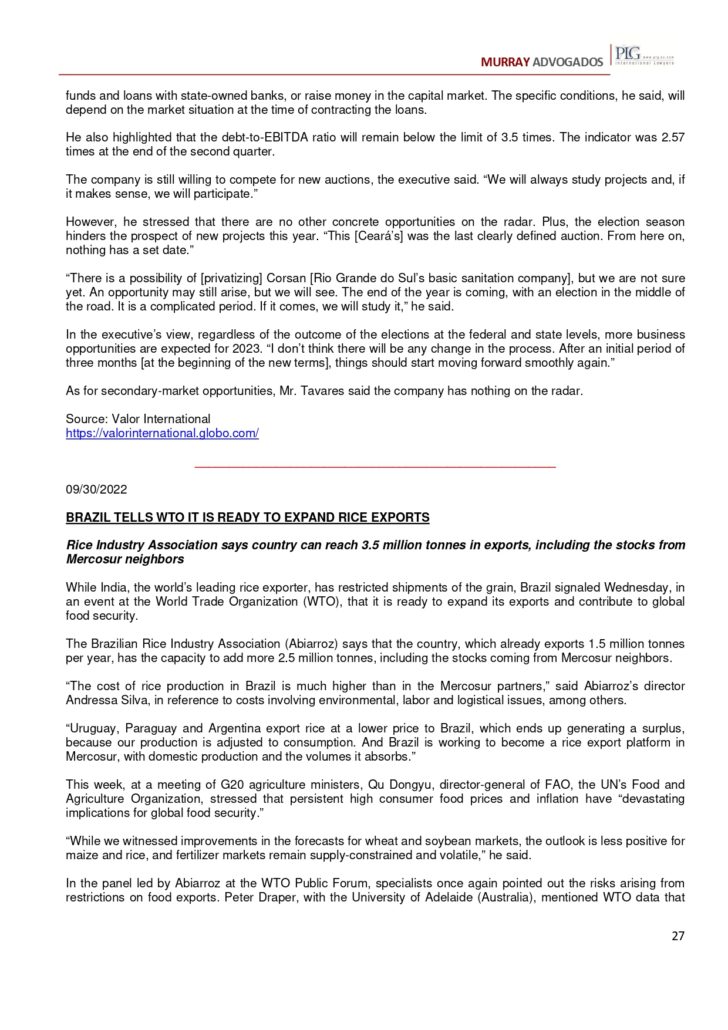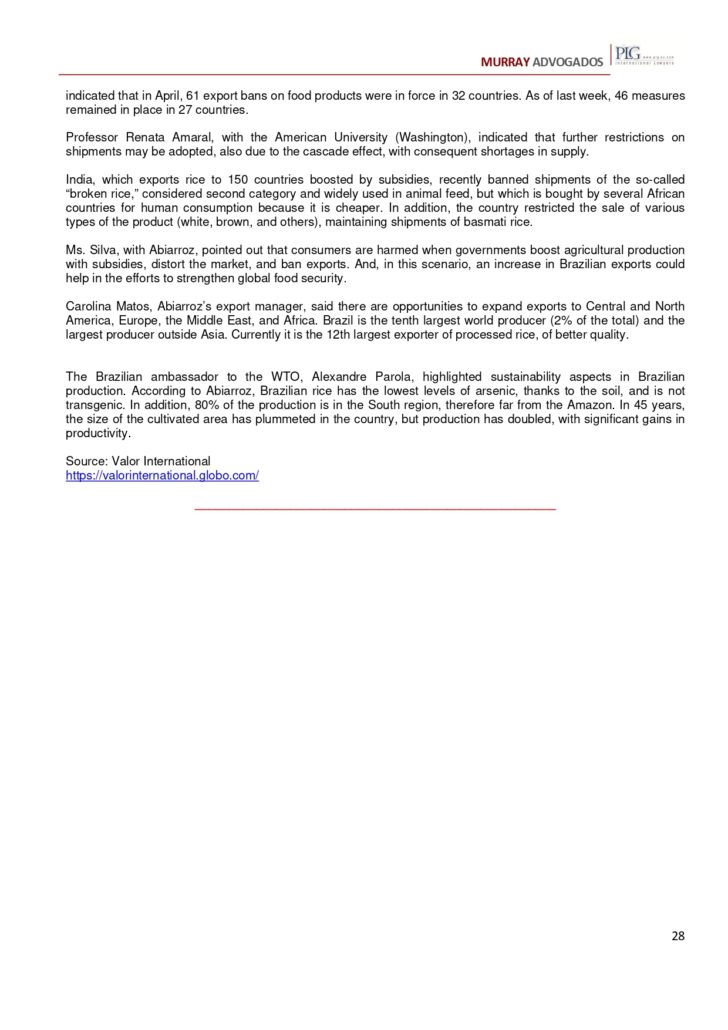MURRAY ADVOGADOS
NEWSLETTER
SEPTEMBER 2025
09/04/2025
CHINA DOUBLES DOWN ON BRAZIL WITH ENERGY FOCUS, DIVERSIFIED INVESTMENT
After era of large-scale projects, Chinese capital shifts to innovation, energy transition
Chinese investments in Brazil reached $4.18 billion in 2024, up 113% from $1.97 billion the previous year. The surge far outpaced the 13.8% increase in overall foreign direct investment (FDI) in Brazil last year, according to Central Bank data.
Despite the rebound, flows from China remain well below the record $8.8 billion peak in 2017, when major bets were placed on large-scale oil and energy infrastructure projects. Investments are now more diversified, spread across smaller projects in information technology, manufacturing, and renewable energy. A record number of deals were confirmed in 2024, totaling 39, compared with 29 in 2023 and 28 in 2017.
The figures refer to projects effectively implemented last year, based on data from the Brazil-China Business Council (CEBC). The survey combines information from multiple sources to benchmark Chinese outbound investment. Potential investments in Brazil could have reached $6.2 billion in 2024, if announced projects that failed to materialize had been included.
Brazil was the leading emerging-market destination for Chinese productive capital last year and the third-largest globally, after the United Kingdom and Hungary. In 2023, it ranked ninth. The United States, which has steadily fallen in the rankings in recent years, placed tenth in 2024, according to data from the CEBC and the China Global Investment Tracker (CGIT), a database managed by the U.S.-based think tank American Enterprise Institute.
Tulio Cariello, CEBC’s director of research and content, noted that China’s initial wave of global expansion in the 2000s targeted developed economies as it sought technological upgrading. “With the geopolitical dispute between the U.S. and China, Chinese investors started looking elsewhere,” he said.
Amid the tariff policies adopted under the Donald Trump administration, relations between China and Brazil are likely to deepen. “Geopolitics is positioning Brazil almost directly alongside China in several economic matters,” Mr. Cariello said.
The report highlights that Chinese inflows accelerated at a time when the depreciation of the real made Brazilian assets cheaper in dollar terms. The average exchange rate in 2024 was R$5.39 to the dollar, the highest since the CEBC began tracking Chinese investment in 2010.
Over the past decade, Brazil ranked among the world’s top 10 recipients of Chinese FDI for seven years. From 2007 to 2024, cumulative Chinese investment in Brazil reached $77.5 billion across 303 confirmed projects. Between 2005 and 2024, Brazil was the fourth-largest destination by stock, trailing only the U.S., U.K., and Australia, according to CGIT.
Electric power attracted the largest share of Chinese investment in 2024, totaling $1.43 billion, or 34% of the total, a 115% increase over 2023. Oil followed with 25%, led by nearly $1 billion from China National Offshore Oil Corporation (CNOOC)—one of the largest single-year commitments of the past decade, second only to 2021, when Chinese oil companies poured about $5 billion into pre-salt projects. Automotive manufacturing ranked third, with $575 million (14%), and mining came next with $556 million (13%).
“Chinese capital is already firmly established in energy, from hydropower, solar, and wind to oil. What stood out last year was manufacturing, especially tied to electrified vehicles. That has brought investment into machinery, electronics, and equipment for energy generation and transmission,” Mr. Cariello said.
The shift has been accompanied by an increase in the number of projects but a decline in their average size. The average deal fell from $507 million in 2010–2014 to $313 million in 2015–2019, and to $112 million between 2020 and 2024. According to the study, this reflects a trend toward less capital-intensive projects, typically focused on innovation and the energy transition.
By project count, electricity continued to dominate in 2024, accounting for 56% of deals. But the remaining 44% was spread across sectors, with oil extraction at 13% and the production of electrical equipment and vehicles at 10% each.
In line with Brazil’s own industrial policy, Chinese investment in manufacturing has gained traction. A record eight projects were confirmed in 2024, worth a combined $637 million—the second-highest value on record, after $907 million in 2023. Beyond electrified cars, investments covered auto parts, construction machinery, household appliances, textiles, and a wide range of electrical instruments and equipment.
This expansion has also fueled more imports from China. Currently, China is Brazil’s leading export market, with a 29.1% share, and also the largest source of imports, at 25.9%, according to official data. “The bilateral trade relationship has grown and become more complex, which also brings challenges. Some industries, such as steel and vehicles, are under pressure from Chinese imports. While Brazil continues to post a large trade surplus with China, that margin has been narrowing, which is something to watch,” Mr. Cariello noted.
Sustainability and green energy accounted for 69% of Chinese projects in Brazil in 2024, compared with 72% in 2023. Last year, they were 72%.
Mr. Cariello also pointed to the growing Chinese appetite for strategic minerals, which featured in nearly all projects confirmed or announced last year, reflecting the country’s positioning in the global energy transition.
Capital flows are also spreading more evenly across Brazil. While São Paulo and Minas Gerais remain the top destinations, with 13 and six projects respectively, 14 states received new Chinese investments in 2024—six more than in 2023. The record was set in 2019, when 17 states hosted projects.
Source: Valor International
https://valorinternational.globo.com
____________________________________________
09/05/2025
MINING PROFITS SET TO DROP AMID COST, PRICE PRESSURES
PwC’s Global Mine study points to third consecutive annual decline in operational earnings for world’s 40 largest miners
Global mining profits are set to drop in 2025, extending a streak of weakening operational performance, according to PwC’s 22nd edition of its Global Mine report, which tracks the financial results and outlook of the world’s 40 biggest mining companies.
Vale fell seven spots this year, ranking 12th, while CSN Mineração, which placed 34th in 2024, dropped out of the list altogether.
The study shows that earnings before interest, taxes, depreciation and amortization (EBITDA), the key measure of operating performance, slipped 5% in 2024 to $193 billion, marking the second straight year of decline. PwC forecasts another dip in 2025, with EBITDA edging down 1% to $190 billion.
Net income is expected to fall 4% to $88 billion, following a modest 1% gain in 2024 to $92 billion. Consolidated revenue should hold steady at about $863 billion, little changed from 2024’s $867 billion.
The sector has yet to recover from the broad downturn of 2023, when revenues dropped 7%, EBITDA plunged 26%, and profits fell 22%. In 2024, excluding gold, consolidated revenue slipped 3% and Ebitda fell 10%.
“Gold’s strong growth was so significant that we had to trace back its share of revenues to 2022 to show its impact,” said Patrícia Seoane, partner at PwC Brazil.
For 2025, the industry’s top four players will be BHP (Australia), China Shenhua Energy (up one spot), Rio Tinto (down one), and Freeport-McMoRan (up two).
According to Ms. Seoane, profit margins are being squeezed by both rising costs and falling commodity prices. Coal, for example, is under pressure from ESG-driven substitution, while iron ore prices are closely tied to China’s infrastructure cycle.
“China has been the main driver of demand. If it decides to invest heavily in infrastructure, iron ore demand and prices rise. If not, prices fall. We’re seeing iron ore prices decline because those major investments aren’t happening,” she said.
To manage costs, miners are turning to automation, robotics, and higher ore concentration technologies. Preventive maintenance is also key to extending equipment life, Ms. Seoane added. “Companies are laser-focused on cost control—because that’s what they can manage. And today, cost reduction comes through technology.”
PwC also flagged concentration risks, particularly for energy-transition minerals. China accounts for over 50% of production of about 18 minerals and holds over 10% of reserves of more than 35. Diversification of both production and processing locations is seen as crucial to reducing supply chain vulnerability.
Brazil could benefit from this shift as company seek strategic locations to mitigate supply-chain vulnerabilities and price volatility, PwC Brasil said. “We still have many undeveloped reserves of minerals beyond iron or copper,” said Ms. Seoane, citing rare-earths, the second-largest reserves after China, but accounts for less than 1% of global output, according to the U.S. Geological Survey.
However, Brazil’s weak mineral processing capacity remains a bottleneck, she warned. Brazil usually exports raw commodities without value-added processing. “The country loses out on a huge value gap that other economies capture,” Ms. Seoane said. Developing domestic processing also faces hurdles including high costs, political instability, and regulatory uncertainty.
Brazil still has a politically unstable environment, which can affect investment security. That directly impacts why the country has so little mineral processing capacity to keep the value chain here. Yet this is a crucial avenue that could generate significant value for Brazil,” said Ms. Seoane.
While the study does not go into detail on the domestic mining industry, an analysis by PwC Brazil shared with Valor shows that mergers and acquisitions (M&A) have been rising moderately since 2022, reaching 16 deals in 2024 compared with 12 in 2023. So far this year, five transactions have already been completed.
“We’ve seen a modest increase in the number of M&As in Brazil, which shows the industry remains attractive. In other words, it demonstrates that investment in the sector continues to flow,” Ms. Seoane added.
Source: Valor international
https://valorinternational.globo.com
___________________________________________
09/05/2025
BATTLE OVER ENVIRONMENTAL LICENSING PITS CONGRESS AGAINST LULA
Agribusiness bloc pushes to overturn presidential vetoes as government scrambles for votes
Even before Senate President Davi Alcolumbre convenes a session to review presidential vetoes, Congress is already maneuvering to use a provisional presidential decree (MP) —which creates the Special Environmental License (LAE)—to reinstate nearly the entire text of the environmental licensing bill passed by lawmakers in July.
At the same time, the government acknowledges difficulties in upholding the 63 vetoes issued by President Lula last month.
Just six days after President Lula signed the new licensing law, legislators and senators opposed to the executive’s vetoes filed 833 amendments to the MP, which originally covers only the LAE and consists of just six articles. The LAE, championed at the time by Mr. Alcolumbre, a government ally, is a new type of permit designed to speed up approvals for projects deemed strategic.
Lawmakers are using this as one of their tactics while Mr. Alcolumbre delays calling a joint congressional session to analyze the vetoes — expected in about two weeks, though no date has been set. Overturning Lula’s vetoes is the main goal of these lawmakers, most aligned with the powerful agribusiness caucus, which has been pressing Mr. Alcolumbre to schedule the session.
Congressman Pedro Lupion, head of the Congressional Agricultural Front (FPA), said the government shows no interest in advancing the MP. For now, there is not even a rapporteur or chair for the joint committee, which has yet to be formed. The MP must be voted on within four months, or it will expire.
“We are mobilized to overturn the vetoes. But before that, we submitted amendments to get as close as possible to the bill we approved,” Mr. Lupion told Valor, noting that he alone filed 19 amendments. “We want to force either a vote on the vetoes or on the MP. Something has to happen. The amendments reflect the text of the licensing bill. We are waiting on President Davi [Alcolumbre].”
Congressman Zé Vitor, also from the agribusiness bloc and rapporteur of the licensing bill in the House, noted that the proposed amendments to the MP contain “minor text adjustments that the internal rules previously did not allow.”
Broadly, the hundreds of amendments seek to reinsert into the general licensing law provisions that President Lula vetoed, such as: the Environmental License by Adhesion and Commitment (LAC) for medium-impact projects; exemption from licensing for rural producers whose Rural Environmental Registry (CAR) is still under review; and the removal of requirements to consult intervening agencies—such as the National Foundation for Indigenous Peoples (FUNAI)—in licensing processes affecting non-demarcated areas.
Randolfe Rodrigues, the government’s leader in Congress, said that proposing amendments is a legitimate part of the legislative process but warned that the executive would veto again if lawmakers tried to reinstate sections President Lula had struck down.
He admitted, however, that the government faces difficulty securing enough votes to block an override. The administration has not ruled out challenging the issue in court but is instead seeking a political agreement.
“Issues that violate the Constitution would obviously be subject to review, but we are not working with that scenario. Our focus is on maintaining the vetoes. I admit that keeping them is challenging right now. We are trying to build consensus and a majority, but it is a difficult scenario,” Mr. Rodrigues told Valor.
Source: Valor International
https://valorinternational.globo.com
____________________________________________
09/08/2025
PETROBRAS WEIGHS ENTRY INTO CORN ETHANOL MARKET
Deal would mark oil company’s return to the sector after exit last decade
Petrobras is considering acquiring a corn ethanol producer this year, sources told Valor. If confirmed, the move would signal the state-controlled company’s return to the sector, which it exited in the mid-2010s with the sale of assets. The corn ethanol market has been expanding as an alternative to sugarcane-based production. Ongoing projects in the segment total R$23 billion in investments.
In a statement, Petrobras said it is conducting studies and analyses of potential opportunities in the bioproducts segment, which includes ethanol.
The company added that its current 2025-2029 business plan foresees investments in ethanol, “preferably through minority strategic partnerships or shared control with relevant sector players.” While not denying ongoing talks, Petrobras said there are no firm decisions on corn ethanol projects. “The company clarifies that there is no definition regarding the raw material to be used in ethanol production projects,” it noted.
The potential move comes amid Petrobras’s broader push in fuel distribution. Since the start of the Lula administration, the company has signaled interest in returning to the distribution market, fueling speculation about possible mergers and acquisitions in the sector. In August, Valor reported that Raízen shareholders Shell and Cosan were seeking a new partner.
Days later, O Globo reported that Petrobras was studying a stake purchase in Raízen. The company denied the claim. “There is no project or study of investment in ethanol or distribution with Raízen,” Petrobras said at the time. Sources close to the company told Valor that Petrobras is evaluating opportunities with several firms, but Raízen is not currently among them.
Another scenario raised in the market is a possible deal with Vibra Energia, the former BR Distribuidora privatized under former President Jair Bolsonaro. Analysts and industry executives, however, consider such a transaction unlikely, partly because Petrobras would need to launch a full takeover bid to acquire a stake.
There would also be potential antitrust hurdles due to the potential market concentration. As of the close of trading on B3 on Friday (Sept. 5), Vibra’s market capitalization stood at R$27.9 billion. The company declined to comment.
Despite these obstacles, Petrobras has criticized the privatization of BR Distribuidora, arguing that it distanced the company from end customers. It has since sought direct supply agreements with large clients for products such as diesel. With Vale, Petrobras has signed contracts for marine fuel containing 24% biodiesel (bunker B24). The company has also signaled plans to return to the cooking gas (LPG) market.
Industry sources say buying another distributor or building a new network from scratch may not be easy for Petrobras, given a brand agreement with Vibra that includes a non-compete clause until 2029. Until then, Vibra retains the right to use the BR brand, formerly owned by Petrobras.
Vibra has expanded in recent years through acquisitions aligned with the energy transition. It acquired Comerc Energia (now up for sale), at the time Brazil’s largest independent power trader, and Zeg Biogás, a biogas and biomethane producer. It also invested in the EV charging startup EZVolt and formed a joint venture with Copersucar for ethanol trading.
Together, Vibra, Raízen, and Ipiranga control 61.3% of the distribution market, according to Brazil’s Petroleum Agency (ANP), based on data from Sept. 3.
These moves come as the fuel market faces mounting challenges from irregular operators. Major distributors have been steadily losing share to companies engaging in practices such as fraud, adulteration, and tax evasion.
Last week, federal and state authorities stepped up enforcement against multibillion-real tax evasion and fuel fraud schemes linked to the Primeiro Comando da Capital (PCC), Brazil’s most powerful criminal organization.
Source: Valor International
https://valorinternational.globo.com
____________________________________________
09/10/2025
ANALYSIS: JUSTICE FUX PIVOTS ON BOLSONARO CASE, DEFIES MORAES
Justice shifts from hard-line stance to defendant-friendly approach
Justice Luiz Fux’s vote in the Supreme Court’s First Panel on Wednesday (10) cements the more defendant-friendly approach he has adopted during the criminal proceedings over the coup plot—a departure from the tough-on-crime posture that marked his role in the Car Wash anti-corruption task force.
At the start of his remarks, Justice Fux questioned whether the Court had jurisdiction to try former President Jair Bolsonaro and echoed a central argument of the defense teams: that there was not enough time to review the “billions of pages” of case files.
Justice Fux was once known for his hard line on criminal matters, earning him the label of one of the court’s most staunch Car Wash supporters. In recent months, however, he has emerged as the main dissenting voice in the trial involving Mr. Bolsonaro and the January 8, 2023, attacks on Brazil’s halls of power.
When the first cases of the rioters who stormed the headquarters of the three branches of government came before the court, Justice Fux joined Justice Alexandre de Moraes in imposing harsher sentences. Now, however, he has positioned himself as Mr. Moraes’s main counterweight.
The turning point came in March, when Justice Fux requested more time to study the case of Débora Rodrigues dos Santos, a hairdresser who spray-painted “Game over, sucker” on the Justice statue outside the Supreme Court. When he cast his vote, Justice Fux argued for a sentence of one year and six months—far below the 14-year prison term ultimately imposed by the First Panel.
Source: Valor International
https://valorinternational.globo.com
____________________________________________
09/12/2025
UNION TAKES ITAÚ TO COURT OVER MASS LAYOFFS
Bank workers’ representatives say about 1,000 dismissals were carried out without prior notice
The Bank Workers’ Union of São Paulo, Osasco and Region has filed a class-action lawsuit against Itaú Unibanco after the bank carried out a mass layoff of employees on Monday (8). According to the union, around 1,000 workers were dismissed without the union being given prior notice.
In a statement released Thursday evening (11), the union said: “In addition to being unjustifiable in light of the bank’s multibillion-real profits—over R$22.6 billion in the last half-year alone—the mass layoffs by Itaú disrespect employees, the Collective Bargaining Agreement (CCT) of the banking category, and Brazilian labor law, which requires prior negotiation with unions in cases like this.”
“We heard from the dismissed employees in a plenary session held this Thursday (11). Itaú violated basic rules protecting employment and disregarded the collective bargaining table. A bank that earns billions cannot treat its workers as disposable numbers,” said Neiva Ribeiro, the union’s president, in the statement. “We will take legal action to reverse this attack and hold Itaú accountable for its disregard for the law and for the category,” she added.
Itaú did not immediately reply to requests for comment.
Source: Valor International
https://valorinternational.globo.com
____________________________________________
09/12/2025
BRAZIL WEIGHS SPLITTING CORPORATE LAW, CIRCULAR ECONOMY BILL
Government rethinks support after changes to class action rules and pushback from industry groups
The government may withdraw support for a bill amending Brazil’s corporate law and creating a National Circular Economy Policy, after changes introduced by the rapporteur, Congressman Luciano Vieira, in the latest draft presented on Wednesday (10). Valor has learned that the Lula administration is considering requesting that the two proposals be split, so they can proceed separately. Strong resistance from business groups and a coalition of congressional caucuses representing the productive sector is likely to complicate Mr. Vieira’s plan to put the bill to a vote next Tuesday (16).
The corporate law bill was sent to Congress in 2023, in the wake of the accounting scandal at retailer Americanas, and is part of the Finance Ministry’s microeconomic agenda. It had stalled until March, when it was bundled with bills on public procurement and circular economy as a strategy to speed up a floor vote. The package briefly appeared on the voting agenda earlier this month but was not considered. Mounting opposition to provisions in the combined bill has now led the government to rethink its strategy and weigh splitting the proposals.
One point of contention involves the mechanism for collective lawsuits against administrators, controlling shareholders, or intermediaries accused of causing losses to companies or to the capital markets by violating rules set by Brazil’s securities regulator CVM. In a previous version of his report, Mr. Vieira had endorsed an “opt-out” model, in which all shareholders of a given class are automatically included in such collective actions. That approach was supported by the Finance Ministry.
But in his latest draft, the rapporteur reverted to an “opt-in” model, where only investors who formally sign on would be included in collective suits. Finance Ministry officials say they will not support the bill under this framework, arguing that it renders the proposal “ineffective,” since individual investors already have the right to file claims on their own.
Sources close to the ministry lamented the shift, noting that the earlier draft reflected a consensus with investors and companies. The reversal was also criticized by AMEC, the Capital Markets Investors Association. “The return to the opt-in model is a technical mistake. A collective protection mechanism is incompatible with selective protection of investors, because it leaves less organized groups, such as retail investors, without adequate safeguards,” said AMEC President Fábio Coelho.
While the Brazilian Association of Public Companies (ABRASCA) favors the opt-in model, it also expressed concerns. “We welcome the return to opt-in, which we see as the better option. But companies have increasingly flagged issues with sector-specific provisions inserted in this bill. We will meet next week to take a position on these additions, which were surprising,” said ABRASCA President Pablo Cesário.
On minority shareholders, the bill establishes civil liability for administrators and controlling shareholders in cases of violations of disclosure rules. It also explicitly provides for collective civil actions to compensate investors, in a model similar to U.S.-style class actions, and expands CVM’s investigative powers.
The circular economy provisions, however, are proving even more contentious. Mr. Vieira added sector-specific obligations and plans covering mining, agriculture, construction and infrastructure, automotive, oil and gas, and sanitation.
A report obtained by Valor from the National Confederation of Industry (CNI) argued that the proposed National Circular Economy Policy “directly impacts the entire productive sector, regardless of size, nature, or scale of operations.” According to CNI, passage of the bill would subject millions of industrial and agribusiness facilities, farms, and commercial and service establishments to more than 70 new legal obligations. CNI did not comment.
The coalition of congressional caucuses representing business interests issued a statement saying the original bill had been “completely distorted by a regulatory maze that ignores the country’s economic reality,” and that the bundling of dozens of other unrelated proposals had created “a legislative monster of more than 100 articles imposing unrealistic obligations and disproportionate penalties on the productive sector.”
The statement is backed by the Congressional Entrepreneurship Caucus and others representing free markets, commerce and services, agribusiness, sustainable mining, health, competitiveness, and biodiesel, among others. They argue that “the regulatory burden, indiscriminately affecting companies of all sizes and sectors, represents a serious risk to Brazil’s competitiveness, since many firms lack the technical or financial capacity to comply with such complex and costly requirements.”
Mr. Vieira declined to comment.
Source: Valor International
https://valorinternational.globo.com
_____________________________________________
09/12/2025
MINISTRY OF FINANCE PROPOSES GLOBAL COALITION FOR CARBON MARKET
Plan calls for alliance with shared emissions cap that would be gradually reduced, offering more favorable criteria for poorer countries
The Ministry of Finance’s main proposal for COP30, to be held in Belém in November, is the creation of a coalition of countries willing to integrate their carbon markets. The alliance would operate with a shared carbon emissions cap among participants, which would be progressively reduced to encourage the decarbonization of economies. It would include fairness criteria for poorer nations and establish a permanent mechanism for channeling resources to help them adapt to climate impacts. The idea has been discussed with the European Union, China, and other countries and could become one of the major outcomes of COP30.
“We believe the proposal is effective because it establishes an emissions cap; fair, because it takes per capita income criteria into account; and politically viable, because it does not require agreement among 200 countries to move forward. All that is needed is a coalition strong enough to make it happen,” says Rafael Dubeux, deputy executive secretary of the Ministry of Finance. “If it manages to bring together Brazil, the European Union, and China, it may encourage others to join.”
The Ministry of Finance has been developing the proposal internally and in coordination with other ministries. Mr. Dubeux was invited to present the idea to a group of economists led by Brazilian José Scheinkman, who was asked to form a team to advise COP30 President André Corrêa do Lago. “We had a conversation with Scheinkman and other economists, such as MIT professor Catherine Wolfram.” Ms. Wolfram leads a group studying how to make the coalition feasible and includes several Brazilian economists.
The Brazilian government and the ministry headed by Fernando Haddad hope the proposal will gain traction in Belém. “We expect to have a joint declaration from countries at COP30 to establish the coalition,” says Mr. Dubeux. In a recent tweet, European Commission President Ursula von der Leyen expressed support for COP30 in Belém, writing: “With Brazil’s leadership in carbon markets, we must make Belém a true milestone for the planet.”
Below are the main points from Mr. Dubeux’s interview with Valor, in which he explains the proposal in detail:
Day 1
On his first day in office, Minister Fernando Haddad asked me to begin working with the ministry team on what would later become the Ecological Transformation Plan. The goal was to reorient the Brazilian economy toward a low-carbon model that is more distributive and driven by technological innovation. It is worth noting that finance ministers typically take office facing a series of fiscal emergencies, and long-term strategic planning is rarely a priority at the outset.
We launched a collective effort involving teams from the Ministry of Finance, the Internal Revenue Service, the Economic Policy Secretariat, the Economic Reform Secretariat, and the ministries of Environment, Mines and Energy, and Trade, Industry, and Services. We structured the agenda around three main objectives: innovation, sustainability, and income distribution.
The Ministry of Finance’s role
The Ministry of Finance’s core responsibilities include managing GDP, inflation, unemployment, and other macroeconomic indicators, as well as improving the business environment for investment through tax, insurance, and credit reform. These initiatives form the prerequisites for development. But they are not enough.
Minister Haddad argues that, in addition to ensuring macroeconomic balance and improving the business environment, the Ministry of Finance and the government must open a third front: developing a long-term strategy for a growth model that replaces a reliance on exporting commodities without added value with one rooted in innovation; that decouples GDP growth from environmental degradation; and that distributes income more equitably, in light of Brazil’s history of profound inequality.
Brazil holds historical legitimacy on this agenda. It hosted the 1992 Rio Summit, has a power generation mix primarily based on hydroelectricity, has used ethanol on a large scale since the 1970s, possesses the world’s richest biodiversity, has invested heavily in renewable energy, and has combined economic and climate policy initiatives.
Socio-environmental reglobalization
By early 2024, we were already discussing what proposals Brazil, as host of the G20 and COP30, could present to help shape a financial architecture capable of steering global economic growth toward a low-carbon model. We have a role to play in this debate.
The minister argues that while globalization in recent decades has brought economic efficiency to certain value chains, the time has come for “socio-environmental reglobalization.” This means adding a new layer to international governance so that, alongside economic efficiency, global integration also incorporates social and environmental considerations. The goal is not to dismantle globalization, but to create a new model of productive integration that fully accounts for these elements.
Fund for tropical forests
As we prepared proposals for COP, we realized that, alongside the key topics already under discussion—such as NDCs (countries’ climate commitments), adaptation, and climate justice—there was a gap. What was missing was a proposal with a stronger economic focus at the heart of the climate challenge.
We had already developed a proposal with the Ministry of the Environment for the Tropical Forest Forever Facility (TFFF), a fund for tropical forests being launched by Brazil. If successful, it will become one of the most significant contributions of the COP30 process. Concrete in its design, it aims to generate a permanent flow of billions of dollars for developing countries that preserve tropical forests—a fund even larger than the resources of many multilateral banks.
The TFFF is set to become one of the largest global funds ever created. Our goal is for implementation to begin at COP30, with initial contributions coming from sovereign wealth funds, governments, central bank reserves, and philanthropic organizations. Yet, as crucial as the TFFF may be, it does not directly tackle the core issue of climate change: greenhouse gas emissions.
Unrealistic expectations
Some observers, in my view, hold unrealistic expectations that the “transition away” from fossil fuels approved at COP28 will prompt some countries to announce they will stop using or producing oil by 2030 or 2040. I do not believe that will happen.
What we can do is create mechanisms that enable an orderly phase-out of fossil fuels. This can occur once regulatory and financial frameworks induce the transition, either because low-carbon alternatives become more competitive or because continuing to exploit oil under current conditions becomes prohibitively expensive through carbon pricing or other regulations.
Four criteria
In the debate over decarbonization, four main criteria typically emerge. First, which producers face the highest and lowest costs? Those with the highest costs would likely be the first to halt production. Second, which producers have the highest and lowest carbon intensity per barrel? Third, per capita income: it makes sense for wealthy nations to cut emissions before poorer ones. Why should Nigeria stop producing oil while Canada continues to do so? That would not be fair. Fourth, energy security: countries must also weigh the stability of their energy supplies when planning emission reductions.
A global emissions cap
Given these criteria, how can we design an organized transition that reduces emissions quickly while ensuring fairness and equity? At the Ministry of Finance, in collaboration with the Ministry of the Environment, we developed the idea of creating a global emissions cap—one that would decline over time. Setting such a limit for the economy is fundamental to a regulated carbon market.
Market integration
Any activity that generates emissions would need to purchase allowances under this cap. As the cap decreases over time, the cost of these allowances would rise, creating a financial incentive for companies to decarbonize. We would start with a cap close to current emission levels and, ideally, reach net-zero emissions by 2050.
The most effective way to tackle climate change globally would be through a carbon price established by this emissions cap—a “cap-and-trade” system that gradually declines to zero by 2050. But such a system would require the approval of nearly 200 countries participating in the COPs. We already know that it is not realistic; one country even withdrew from the Paris Agreement.
The Open Coalition
We wanted to present a proposal that reflects Brazil’s ambition while remaining politically feasible. That led to the idea of creating the Open Coalition for Integrating Carbon Markets. The central goal is to bring together the world’s largest economies.
Three major objectives
In our view, the proposal must achieve three objectives at once: it must be effective in reducing emissions, fair, and politically viable. The solution we found is the Open Coalition: a group of countries sharing a common emissions cap, which would be reduced gradually over time.
Criteria for quotas
Each country’s quota would be determined using several factors. Population size is one—China and Luxembourg cannot receive equal quotas. Per capita income is another factor, ensuring social justice: higher-income countries would have stricter quotas, giving developing countries room to emit more while requiring wealthier nations to accelerate their decarbonization.
Finally, there must be a border adjustment mechanism—different from the European Union’s CBAM (which imposes a carbon price on emissions embedded in imported products)—to balance trade considerations fairly across coalition members.
Border adjustment
How does the EU’s proposal differ from ours? First, governance: the CBAM is unilaterally established by the EU, whereas in our coalition, all participants would share in governance. Only those unwilling to price carbon would remain outside—and they would bear the consequences. Moreover, our proposal would not create a financial flow from poorer nations to wealthier ones.
Money for adaptation
We propose directing part of the revenue collected from the carbon market and border adjustment toward climate adaptation efforts in developing countries. This would create a permanent financial flow to address the climate crisis.
In summary, the proposal is effective. It imposes a cap, it is fair because it incorporates a per capita income mechanism, and it is politically viable because it does not require consensus among 200 countries. All that is needed is a coalition strong enough to move forward. If it includes Brazil, the EU, and China, it could encourage others to join. Another relevant player is California, which—if it were a country—would rank as the world’s fourth-largest economy.
Social justice mechanisms
We are considering differentiated border adjustments based on per capita income—countries with lower income levels could be exempt from paying or required to pay less.
Source: Valor International
https://valorinternational.globo.com
____________________________________________
09/16/2025
BRAZIL’S VP SEES STRONGER U.S. TIES, HIGHLIGHTS KEY MINERAL AGENDA
Geraldo Alckmin rules out retaliation and defends cautious trade stance
The recent tensions between Brazil and the United States are likely to ease, and dialogue and negotiations with Washington are expected to increase, Vice President Geraldo Alckmin said Monday (15). Mr. Alckmin, who also serves as Minister of Development, Industry, Trade and Services, said Brazil sees an opportunity to build a broad agenda with the U.S., especially around strategic minerals.
Asked about his confidence in dialogue with the U.S., Mr. Alckmin said it’s important to stay calm, adding with a laugh that he’s an anesthesiologist, drawing chuckles from the audience.
Mr. Alckmin said Brazil and the U.S. have a “positive agenda,” highlighting two centuries of partnership and long-standing American investors such as General Motors and Caterpillar. “The U.S. has a trade surplus with us. Among G20 countries, they only have a surplus with three: the U.K., Australia, and Brazil. This year, our exports to them rose 4.5%, while their exports to us grew 12.5%. Brazil is not the problem, Brazil is the solution.”
On tariffs, he noted that eight of the top ten American products exported to Brazil are subject to zero duties, and the country’s average tariff rate is 2.7%. On the non-tariff front, he added, Brazil offers abundant clean, green, renewable energy, and also sees potential to advance cooperation on strategic minerals.
He emphasized that private sector engagement in the U.S. is essential to negotiating changes in U.S. trade policy. The goal, he said, is to lower rates and remove the remaining 35% of items still subject to the tariff hikes.
Mr. Alckmin rejected any immediate application of Brazil’s reciprocity law and argued for a cautious approach that promotes free trade and multilateralism. “Let’s not forget that last week, pulp was removed from the tariff list. The rate didn’t drop to 10%, it went to zero.”
He pointed to other positive developments in Brazil, such as food prices improving, the exchange rate reaching R$5.32 per dollar, and gains in the stock market. His main concern, he said, is the need for strict fiscal and monetary policies.
“There’s nothing worse for fiscal policy than a Selic [base rate] at 15%,” he said. “A 1% increase in Selic adds R$48 billion just to roll over the debt. You cut R$200 million from healthcare, R$300 million from education, R$400 million from logistics and infrastructure, and every 1% costs R$48 billion to roll over the debt.” He added that there is no justification for Brazil having the second-highest interest rate in the world.
When asked about the presidential race, Mr. Alckmin replied that elections tend to make journalists and politicians anxious. “Every election is competitive, and that’s a good thing,” he said, adding that the economy will ultimately decide the outcome. “We’re in an odd-numbered year, and elections are in even-numbered years.”
In municipal elections, he said, voters focus on local issues like public lighting, day care, and health clinics. In national elections, the key factors are the economy, inflation, and employment. “And it’s about how people feel in the six months leading up to the election. That’s true around the world. What matters is the economy. So it’s essential to control inflation and support jobs.”
He concluded on a hopeful note: “The positive news is that Brazil is no longer on the hunger map,” citing a 5.8% unemployment rate as a favorable sign.
Source: Valor International
https://valorinternational.globo.com
____________________________________________
09/16/2025
GLOBAL RACE FOR CRITICAL MINERALS COULD SPEED UP BRAZIL’S REGULATION
Push for modern legal framework comes as country seeks to align with demand for rare earths, nickel, niobium, copper, and other key metals
The global geopolitical race to secure access to critical minerals is creating momentum for Brazil to modernize its legal framework for resource exploration. The country has been undergoing regulatory changes since the 2019 collapse of Vale’s Córrego do Feijão tailings dam in Brumadinho, a period that saw measures such as increased fines imposed by the National Mining Agency (ANM). Still, Brazil lags in updating rules in areas such as penalties for companies that fail to develop exploration concessions within established deadlines.
Marcio Pereira, a partner at BMA Advogados, noted that Brazil has historically been more “reactive” in its regulatory approach but said he has “never seen” the sector so mobilized to push for improvements in the legal framework needed to advance mining in the country.
He emphasized that global dynamics—including pressure initially driven by the United States to secure strategic mineral supplies—have reinforced the industry’s perception that Brazil must modernize its regulations to take advantage of rising demand for critical minerals such as rare earths, nickel, niobium, and copper.
Since the pandemic, Brazil has enacted Law 14066/20 and decrees 10965/22 and 11197/22, which set out sanctions and procedures for mineral exploration. ANM is responsible for implementing the fines. According to Mr. Pereira, the expectation is that the agency will finalize the rules this month, a step that could help unlock investment and speed up development.
“Now [after regulation] there will be meaningful fines for those who ‘sit’ on concessions,” Mr. Pereira said.
João Raso, a BMA lawyer specializing in mining, pointed out that several factors currently hinder the development of Brazil’s mineral reserves. Data from the Brazilian Mining Institute (IBRAM) show that, among critical minerals, Brazil holds the world’s third-largest nickel reserves but ranks only eighth in production; the second-largest graphite reserves but is fourth in output; the fourth-largest titanium reserves but only 16th in production; and the second-largest rare earth reserves but 11th in output.
“Having all this internal and external pressure saying we need to move [on critical minerals] is what will trigger change,” Mr. Raso said, citing demand from companies and countries for inputs vital to industries such as electrification, technology, and defense.
Source: Valor International
https://valorinternational.globo.com
____________________________________________
09/19/2025
ENERGY ACCOUNTS FOR ONE-THIRD OF M&A DEALS IN BRAZIL THIS YEAR
Transactions in the sector reach R$50bn out of R$140bn total through September
The energy sector has emerged as a major driver of mergers and acquisitions in Brazil this year, accounting for nearly R$50 billion in deals, or one-third of the market, despite high interest rates that have made companies more cautious. With upcoming concession renewals and a wave of asset rotation, industry giants are reshaping their portfolios through multibillion-real transactions.
From January to mid-September, energy represented around 35% of the total financial volume of M&A advisory transactions in Brazil, which reached roughly R$140 billion, according to data from consultancy Dealogic. That figure includes the R$12 billion acquisition announced last week by Spain’s Iberdrola of a stake in Neoenergia previously held by Previ, the pension fund for employees of Banco do Brasil, one of the largest deals in the sector this year.
Other major transactions include the proposed delisting of Serena by private equity firm Actis and Singapore’s sovereign wealth fund GIC, in a deal worth more than R$15 billion. Another significant deal was Equatorial’s sale of transmission assets to Canadian pension fund CDPQ.
More deals are underway and are expected to boost these figures in the coming months. Engie, for example, has reportedly put a minority stake in its transmission assets up for sale. People with knowledge of the deal also said Energisa is exploring a sale of its transmission lines. Meanwhile, French utility EDF is selling a thermal power plant and looking for a partner in its renewable energy business. Brookfield is close to announcing a deal involving Quantum.
“There’s a lot happening in the energy space,” said Felipe Mattar, managing director at Morgan Stanley in Brazil. “The backdrop is a combination of factors, including the renewal of distribution concessions and future renewals of large hydroelectric contracts. These companies need to recycle assets to make room in their portfolios.” He noted that the upcoming expiration of distribution concessions typically reduces EBITDA, which in turn drives asset turnover.
Energy continues to reshape Brazil’s M&A landscape. Roderick Greenlees, global head of investment banking at Itaú BBA, said the sector has always played a key role in M&A activity and remains central to the country’s largest deals this year. “In transmission, there are groups that win auctions and build the power lines, and then, because these are stable revenue assets, they naturally attract pension funds as buyers,” he said.
However, the trend is not uniform across the sector. The renewable energy segment is facing a supply glut, and many companies are being hit by “curtailment”—a forced reduction or halt in electricity generation imposed by Brazil’s National Electric System Operator (ONS).
Mr. Greenlees said that the only reason energy hasn’t had an even stronger year is that deals involving renewable energy assets are on hold. The main obstacle, he said, is the difficulty in pricing assets impacted by curtailment, which is causing losses.
Engie said in a statement that it is currently conducting “a thorough and strategic analysis to define the most interesting lots for participation in the October auction.” The company added that it “does not comment on market rumors.”
Energisa said it is “constantly analyzing opportunities, considering prudent capital allocation, a commitment to quality, and appropriate returns to shareholders.” EDF confirmed it is exploring the possibility of taking its Brazilian subsidiary public in order to bring in new partners, with the goal of recycling capital. Brookfield declined to comment.
Source: Valor International
https://valorinternational.globo.com
____________________________________________
09/23/2025
BIOECONOMY SEEN AS OPTION TO SAVE AMAZON
Experts defend economic potential of strategy, with job and income generation, but warn it is not only solution nor will it solve problems immediately
The bioeconomy has significant commercial and socioeconomic development potential for Brazil, especially in areas where environmental preservation has become strategic in the face of the effects of climate change. However, according to experts and producers interviewed by Valor, there is a clear awareness that this is not a silver bullet, although it is a path to be followed not out of utopia, but out of pragmatism.
“When we support and promote the bioeconomy, we are not proposing an immediate substitution of food and goods production in the traditional way we have today, but a gradual transition. The bioeconomy is not the silver bullet that will solve all problems overnight, but it has enormous potential to generate jobs and income, especially for Brazil,” says Pedro Zanetti, a specialist in land use transition, food systems and bioeconomy at the Climate and Society Institute (iCS).
Mr. Zanetti comments that, amid global efforts to decarbonize the economy, Brazil is still behind in the competitiveness of its bioeconomy, although it is one of the countries with the greatest potential for housing approximately 12% of the world’s forest cover, including most of the Amazon.
“The size of the global market for forest-compatible products is approximately $175 billion. But, considering the 64 products the Amazon already exports, Brazilian participation is only 0.2% or $300 million per year. And the Amazon alone represents one-third of tropical forests in the world,” observes Mr. Zanetti, citing data from a survey by the Amazon 2030 Project, an initiative by researchers to develop an action plan for the Brazilian Amazon.
The iCS specialist highlights as an example of Brazil’s fragility in the current bioeconomy market the fact that Bolivia is the main exporter of Brazil nuts to the world, also known as Amazon nut.
“Despite Brazil being the largest producer of Brazil nuts, most of the processing and added value stays with neighboring countries, like Bolivia and Peru. This shows that Brazil still needs to invest in processing and industrialization to retain more value within the country,” says Mr. Zanetti.
When asked about the possibility that the advance of the Brazilian bioeconomy could be targeted by attacks from traditional producers or climate deniers who prefer another type of exploitation of the Amazon, Mr. Zanetti says this happens, but emphasizes the economic benefit as a powerful advantage.
“Climate denialism is driven by ideological or economic interests, especially those linked to illegal deforestation. But when the bioeconomy proves financially viable, even more conservative producers adopt it,” he says. “The bioeconomy is not an ideological issue, it’s a business that makes sense because it generates jobs, increases income, and improves the quality of life of entire communities. And it does all this on top of environmental protection. It’s an agenda that can unite different sectors of society,” he adds.
As explained by Rodrigo Spuri, conservation director of the NGO The Nature Conservancy (TNC), the bioeconomy in Brazil has different scales and it is necessary to understand that the idea is not to replace agribusiness, but rather to open a new path that brings micro and macroeconomic benefits.
“The growth potential of the bioeconomy cannot be compared to that of large-scale agribusiness, but it is significant and can be equivalent to sectors like cattle ranching in states like Pará,” says Mr. Spuri, emphasizing the advantages in terms of business generation and income increase for families living in forest areas.
The TNC director also argues that one of the main roles of the bioeconomy is to change the narrative that the forest is an obstacle to economic development, showing that it is, in fact, a value-generation mechanism.
“In addition to generating monetary value, the bioeconomy promotes income distribution and economic inclusion of diverse communities, generating significant value for those who live off the forest, even if it doesn’t make them big entrepreneurs,” says Mr. Spuri. “Brazil has the potential to be a leader in the sector due to its biodiversity, but needs to invest more in research and development to take advantage of forest knowledge and create new products and technologies,” he adds.
“The bioeconomy is not the silver bullet that will solve all environmental conservation problems alone. But it is a component and a strategy to add value to Brazil’s natural capital, such as forests and biomes, through market products,” concludes Mr. Spuri.
Source: Valor International
https://valorinternational.globo.com
____________________________________________
09/24/2025
BRAZIL WILL NEED FISCAL ADJUSTMENT AFTER 2026, GOLDMAN SACHS SAYS
Whoever wins next year’s election will have to persuade voters that fixing public finances is necessary, says Alberto Ramos, head of Latin America economic research at the investment bank
Convincing Brazilians that a fiscal adjustment is necessary after the 2026 election won’t be an easy task for any incoming president, given the country’s “reasonably good” economic growth over the past three years, fueled, in the words of Goldman Sachs, by “fiscal steroids.”
“The essence of populism is this short-term sense of well-being achieved through mechanisms that are unsustainable over time. The bill comes later,” said Alberto Ramos, head of Latin America economic research at Goldman Sachs. “What worries me is that after the election, whoever wins will need to push for a fiscal adjustment when the population doesn’t feel there’s a problem. Growth has been good, unemployment low, wages rising. I don’t think people will buy into the idea that we need a deep fiscal adjustment.”
Mr. Ramos contrasted Brazil’s situation with Argentina’s, where President Javier Milei won office on a platform of tough reforms at a time when the economy was already in deep trouble, facing contraction, soaring inflation, and rapid impoverishment.
“He pushed through a fiscal adjustment equivalent to 6 percentage points of GDP in an economy that also had very rigid spending, and was already suffering significantly. But it was clear to most of the population that the Kirchnerist model had failed—economically, socially, and politically,” Mr. Ramos said.
He believes part of the recent improvement in Brazilian asset prices stems from investor expectations that a new administration will take office in 2027, and bring with it a shift in economic policy.
“No matter who wins, a fiscal adjustment will be inevitable, and it won’t be easy,” he said. “If President Lula is reelected, fiscal realities will impose tighter constraints, otherwise, things won’t end well. A more conservative candidate would probably be more inclined to implement that adjustment. But my question is: Is Brazil ready?,” Mr. Ramos asked, adding that he’s not fully convinced about a scenario in which the current opposition wins either.
Mr. Ramos said the necessary overhaul would include loosening the rigid structure of public spending: changing laws that tie budget allocations to health and education, revising the rule that mandates real increases to the minimum wage, and reviewing other legislation that hardwires spending.
“We already know the path to take, if there’s political will,” he said.
Political balance
One hurdle, however, is that “Congress is not exactly the guardian of fiscal orthodoxy,” Mr. Ramos added. “The real fight between Congress and the government is just about who gets credit for the spending. The political balance may not be one that allows these reforms—some of which are constitutional—to pass. In Argentina, the crisis helped get them through. That’s not our situation, thankfully, but if we keep delaying, we may hit a breaking point that forces a much more painful and destabilizing adjustment.”
Brazil’s fiscal issues aren’t new, but have worsened recently, leaving policymakers with less room to maneuver, he said. One example: the government has already raised taxes without improving fiscal fundamentals.
“A fiscal adjustment that relies on tax hikes is already a poor-quality fix, but even so, how would society react, after four years of rising taxes?” Mr. Ramos asked. “We’ve used up our ammo without defeating the enemy. We raised taxes to spend more, not to improve the primary balance.”
Adjusting for the economic cycle, Brazil’s fiscal picture is worse than the headline numbers suggest, he said.
“When the economy was booming, the government doubled down and injected even more liquidity, overheating the system. The best time to make adjustments is when the economy is doing well. Now, it’s slowing, and they want to reverse the fiscal impulse. They should’ve held back earlier, taken advantage of the revenue from growth to build a better primary result.”
Mr. Ramos said Brazil’s economy is now slowing because it has hit “capacity constraints.” He believes the recent GDP growth of 3% or more is above the country’s potential. On top of that, monetary policy remains tight.
“But if someone arrived from another planet and saw Brazil with 15% nominal interest rates and 10% real rates, they’d assume the country is in deep recession. And it’s not—it’s just slowing, because there are credit policies, quasi-fiscal programs. The effectiveness of monetary policy has been undermined by fiscal activism,” he said.
Letting the economy slow is necessary to bring down inflation and eventually lower both inflation and interest rates, Mr. Ramos added.
“If no action is taken, that’s the path we’re on—and it’s not one we should resist, because we’re not facing an economic collapse.”
He said he doesn’t expect a “fiscal disaster in 2026,” despite it being an election year. “But we should be running a surplus,” he said. “This government’s view, which I don’t share, that the economy only grows through fiscal stimulus, paired with an upcoming election, means that the current slowdown is probably not deep enough to allow monetary policy to shift to a neutral stance.”
Even if there is room for the Central Bank to begin cutting rates in December, he said, interest rates will likely remain tight through the end of 2026.
Mr. Ramos acknowledged some improvement in headline inflation but noted that service inflation “is still far from good.” Currency appreciation and lower prices for commodities and food have helped, he said, but given those factors, “Inflation should be around 2%.”
“That’s not the case. The target is 3%, and we’ve been above it for many years. The Central Bank’s projections don’t even place 3% within the relevant forecast horizon. It’s a tough battle that requires a completely different fiscal approach from what we’ve seen over the past four years.”
“The difference between medicine and poison is dosage,” he added. “Monetary policy is the medicine, but its dosage can become toxic because of fiscal policy. Fiscal policy needs to take over the burden that monetary policy is carrying right now.”
Source: Valor International
https://valorinternational.globo.com
____________________________________________
09/24/2025
BRAZIL MULLS HIGHER TAXES ON REAL ESTATE, AGRIBUSINESS CREDIT INSTRUMENTS
Congressional rapporteur’s plan would raise income tax to 7.5% while preserving exemptions for infrastructure, agribusiness receivables
The rapporteur of the provisional presidential decree that serves as an alternative to the Tax on Financial Transactions (IOF), Congressman Carlos Zarattini (Workers’ Party), will propose increasing the income tax (IR) rate on Agricultural Credit Bills (LCAs) and Real Estate Credit Bills (LCIs) from 5% to 7.5% starting in 2026. The change aims to preserve the exemption on infrastructure bonds, as well as Real Estate (CRIs) and Agribusiness Receivables Certificates (CRAs).
Mr. Zarattini also presented a proposal granting income tax exemption for real estate investment trust (REIT) and agribusiness chain investment funds (Fiagros) with at least 100 shareholders, a profile that currently represents most of the market. The government’s original proposal had set a 5% tax on these investments.
The agribusiness caucus, the largest in Congress, is firmly against raising taxes on agribusiness securities. “We will not accept 7.5% on LCAs,” said Congressman Pedro Lupion, president of the Parliamentary Agricultural Front (FPA).
The report was expected to be submitted on Tuesday (23) to the joint committee of Congress. However, at the request of Lower House Speaker Hugo Motta, its presentation was postponed so the text could first be discussed in a leaders’ meeting. Mr. Zarattini said the party leaders made suggestions, but he does not yet know which will be incorporated. He expects to release the report on Wednesday (24), with a vote at the committee likely on Tuesday (30).
The rapporteur said he will maintain in his report the government’s proposal to establish a fixed 17.5% income tax rate on financial investments in Brazil starting in 2026. This will end the staggered system, which charged 22.5% on investments of up to six months and 15% on those longer than two years. He also said he will maintain the increase in the tax rate on interest on net equity (JCP) from 15% to 20%.
The government’s proposal also granted income tax exemption to foreign investors, provided they are not based in tax havens. The rapporteur broadened this benefit to include certain over-the-counter transactions and the issuance and redemption of depositary receipts in Brazil or abroad. He also kept the 25% tax on earnings of investors domiciled in tax havens, but set the rule to take effect one year after the law is enacted.
Mr. Zarattini also proposed raising the tax on Guaranteed Real Estate Bills (LIG) for individuals from 5% to 7.5%. In the case of LCI, LCA, and Mortgage Bills, he suggested a 7.5% rate for individuals and 17.5% for companies. He also expanded the allocation requirement of LCAs from 65% to 80% and included an “update of the legal framework,” without giving further details.
Mr. Zarattini also introduced a change exempting companies and setting a 7.5% tax on individuals’ earnings from Development Credit Bills (LCDs). The government’s original plan had been 17.5% for companies and 5% for individuals.
The rapporteur said he will keep the provision that establishes two rates for the Social Contribution over Net Profit (CSLL), at 15% and 20%. The 9% bracket will be eliminated, meaning companies currently taxed at that rate will move to 15%. This measure only affects financial institutions, including fintechs.
Also preserved is the government’s proposal to reinstate the 18% tax rate on Gross Gaming Revenue (GGR) from sports betting, as originally suggested by the Finance Ministry when it submitted the sector’s regulation to Congress. Lawmakers had reduced the rate to 12%. This measure has the greatest revenue potential of the package—R$10 billion—within the broader plan to raise revenue and control spending as an alternative to increasing the IOF. The Finance Ministry expects the provisional decree to generate R$20 billion.
The proposal to tax LCIs and LCAs was poorly received by asset managers and market analysts. Guilherme Almeida, head of fixed income at Suno Research, said the measure is negative because these instruments are important funding sources. “The cost associated with these sources is lower and, consequently, so is the cost of credit at the end, due to today’s exemption,” he said.
He cited a study by real estate sector associations estimating that a 5% tax increase on LCIs could raise mortgage lending rates by 0.7 percentage points. “This increase from 5% to 7.5% will have an even greater impact,” he said.
In a statement, the Brazilian Association of Real Estate Credit and Savings Entities (Abecip) said the proposed taxation of LCIs is worrisome and could directly impact mortgage credit rates.
Renato Jerusalmi, founding partner and portfolio manager at Riza Asset, said that among the available options, taxing bank securities is the most suitable because it addresses banks’ very cheap funding, typically at 92% to 94% of the CDI (the interbank deposit rate, used as an investment benchmark in Brazil). “Since banks have access to many different sources, the consolidated impact should not be so significant.” He noted, however, that the operations backing these issuances will see funding affected. “But with a developed capital market, companies have alternatives.” Overall, he said, the measure is negative because it continues the trend of taxing the productive sectors.
For Octaciano Neto, former agriculture secretary of Espírito Santo and founder of agribusiness financing consultancy Zera, LCAs should remain exempt. “Compared with the OECD average, Brazilian agribusiness receives 75% less in subsidies,” he said. He argued that the taxation will drive investors toward CRAs, which will remain tax-exempt. “On the other hand, the taxation will accelerate the capital market’s overtaking of banks in financing agribusiness,” he said.
Source: /valor International
https://valorinternational.globo.com
____________________________________________
09/25/2025
ASSAÍ SUES FRENCH CASINO, SEEKS FREEZE OF BRAZILIAN RETAILER GPA SHARES
Brazilian cash&carry chain asks court to block R$475m stake amid dispute over tax liabilities of Pão de Açúcar’s parent company
Cash-and-carry chain Assaí has filed a lawsuit against French retailer Casino, requesting a freeze on all of its shares in GPA, after being notified that it could be held liable for the tax contingencies of Pão de Açúcar’s controlling shareholder.
The case was filed on Wednesday (24) at São Paulo’s Business and Arbitration-Related Disputes Court.
Currently, only part of the tax liabilities is being pursued by the Treasury—about R$36 million. However, the risk of further claims prompted Assaí to request a remedy to block 22.5% of Casino’s stake in GPA, valued at roughly R$475 million.
According to people familiar with the matter, Assaí fears Casino could sell the remaining 110 million common shares it still holds in GPA and transfer the proceeds to France. Casino already has a plan to monetize the stake and is seeking buyers. If new tax claims arise, with the capital moved abroad, Assaí argues it would be left exposed.
In its financial statements, Casino already classifies its Brazilian operations as discontinued.
An arbitration proceeding is expected to be opened within 30 days at the Brazil-Canada Chamber of Commerce Arbitration and Mediation Center. But such cases take an average of three years, which led Assaí to file an application for injunctive relief.
Assaí was a GPA subsidiary until 2020, when Casino took over GPA’s control. Currently, the French retailer is GPA’s second-largest shareholder, behind the Coelho Diniz family.
Last week, Brazil’s Attorney General’s Office of the National Treasury (PGFN) notified Assaí of the opening of an Administrative Liability Recognition Proceeding (PARR). The Treasury considers Assaí jointly liable for debts incurred while it was part of the same economic group as GPA (2007–2020). GPA disputes this, as it publicly stated in October 2024.
Under Brazil’s National Tax Code, however, companies can be held jointly responsible for contingencies related to acts and events that occurred before a corporate spin-off. These could involve disputes over social taxes PIS and Cofins or Tax on Financial Transactions (IOF).
Assaí could also face liability for other GPA-related obligations. According to a person with access to transaction documents, GPA has around R$17 billion in total contingencies and 5,000 municipal, state, and federal tax assessments. Assaí could be exposed to a portion of these related to the pre-2020 period.
In GPA’s second-quarter balance sheet, legal proceedings with guarantees and surety bonds totaled R$13.5 billion.
In its filing, Assaí argues that GPA’s owners acted abusively by selling assets in Brazil and distributing dividends to shareholders in Europe despite billions in contingencies.
Part of those dividends helped Casino pay foreign creditors during its debt restructuring proceedings in France after 2018.
A former Pão de Açúcar executive recalled that independent members had seats on the board of directors before the spin-off, as did Casino, which led the board at the time when these contingencies were growing. He added that there was widespread concern within the company that the amounts could escalate.
“However, there wasn’t much to be done since Casino, through Arnaud Strasser and others such as Ronaldo Iabrudi, had the decision-making power,” the person said.
In September last year, the Federal Revenue listed R$1.3 billion in Assaí’s assets as collateral for potential GPA debts. In October, however, GPA successfully appealed, and the measure was lifted.
At the time, GPA acknowledged responsibility for Assaí’s legal cases, which totaled R$36 million—R$4 million tax-related, R$15 million labor, and R$17 million civil.
The issue resurfaced because, according to people close to the matter, the Treasury is exploring alternative ways to hold Assaí accountable.
The chain argues it could only act now, after being formally notified of the PARR. The company is represented by the law firm Mattos Filho.
The Federal Revenue monitors whether companies maintain at least 30% of their assets to cover contingencies. Alerts are triggered when asset levels fall below that threshold.
Assaí’s advisers believe GPA’s asset sales, including the Colombian Éxito chain, reduced this ratio and drew the Treasury’s attention. That led the PGFN to look to Assaí, once part of GPA, as a potential source of recovery.
Following the PGFN notification, Assaí has 15 days to submit its administrative defense. The process may require deposits in court or guarantees.
Market participants expect GPA shares to respond to the development in Thursday’s (25) session, as Casino considers selling the stake to meet financial covenants with foreign creditors, a move Valor reported earlier. A decline in share value could affect those plans. Casino declined to comment.
This marks the first time Assaí has taken legal action against Casino. The cash-and-carry chain still carries debts left behind by the French group.
When Assaí was separated from GPA five years ago, it inherited about R$8.5 billion in debts from Colombian unit Éxito, a decision imposed by Casino. At the time, Assaí was GPA’s main cash generator.
Roughly 90% of Assaí’s current liabilities stem from that legacy debt burden, compounded by high interest rates. The company became fully independent in 2021 after its spin-off from GPA and is now a publicly traded corporation with no controlling shareholder.
“This story seems endless,” said a longtime observer. “Assaí was saddled with Éxito’s debt at Casino’s insistence, and suffered governance-related share discounts while Casino was still a shareholder. Then Casino left, and the problems continued to follow Assaí.”
Source: Valor International
https://valorinternational.globo.com
____________________________________________
09/25/2025
CENTRAL BANK SETS CONDITIONS TO LIFT PIX, TED TRANSFER CAP
Financial institutions must boost cybersecurity and capital to remove limits on Brazil’s instant payment and wire systems
Brazil’s Central Bank has detailed the requirements for financial institutions using third-party technology providers to request a waiver from the R$15,000 limit per instant payment (Pix) or same-day wire transfer (TED) transaction, announced earlier this month. Among the conditions, firms must implement real-time transaction monitoring and maintain a capital buffer as collateral.
Earlier in the month, the Central Bank had indicated that financial institutions using IT Service Providers (PSTIs) to connect to Brazil’s National Financial System Network (RSFN) could apply for a 90-day exemption from the cap if certain security controls were in place. The regulation, now published in the Official Gazette, defines what those controls are.
PSTIs are tech firms that enable smaller firms to connect to the RSFN, allowing them to operate services like Pix for clients. Two of these providers were recently hit by cyberattacks that compromised millions of accounts managed by institutions using Central Bank infrastructure. In response, the regulator tightened rules for both the providers and their client institutions to strengthen cybersecurity.
The new regulation outlines the conditions under which the Central Bank may authorize a temporary waiver of transaction limits. To obtain permanent exemption, both institutions and their PSTIs must comply with the more comprehensive security controls published on September 5.
Kenneth Ferreira, a partner at law firm Lefosse specializing in banking and financial services, said the exemption is not “broad,” but an “exception contingent on technical robustness and control,” aimed at increasing the safety of institutions using PSTIs.
The waiver applies only on weekdays between 6:30 a.m. and 6:30 p.m. in the case of Pix transactions. For both Pix and TED, the waiver can be renewed for additional 90-day periods, provided the firm has not experienced “serious operational deficiencies or failures.”
Rodrigo Caldas de Carvalho Borges, a partner at law firm CBA Advogados, said the time-bound nature of the waiver enhances security, as the limited timeframe increases oversight, potentially allowing for quicker detection and response to incidents.
To qualify for the waiver, financial institutions must maintain a capital reserve equal to 100% of the highest daily interbank transfer volume processed through their Instant Payment Account (Conta PI) in August, in the case of Pix. For TED, the reserve is based on the highest daily transaction volume made from their Reserve Account or Settlement Account.
Mr. Borges noted that this requirement serves as a financial cushion. “The institution must prove it has unencumbered capital equivalent to its peak transfer day in August. The goal is to ensure that, in the event of large-scale fraud, the institution can absorb the losses on its own, avoiding collapse and systemic risk,” he said.
Firms must also meet governance criteria, including not sharing or storing private keys used to sign RSFN messages within PSTI environments—one of the vulnerabilities exploited in recent cyberattacks.
They must also use distinct digital certificates for different systems and regularly update access permissions, especially for third-party contractors with access to core systems or reserve operations.
Mr. Ferreira said that while the new rules will likely improve security and reduce vulnerabilities, they won’t eliminate the risk of hacking. “Security depends not just on regulations, but also on technical excellence in implementation, audits, penetration testing, corporate governance, incident response, continuity planning, and constant review,” he noted.
To be eligible for the waiver, financial institutions must demonstrate real-time monitoring of atypical or fraudulent transactions. The regulation also requires mechanisms to suspend transaction processing in the event of a suspected severe compromise of their own systems or those of the contracted PSTI.
“We’re seeing an escalation in cyberattacks, and recent events have taught us important lessons,” said Ailton de Aquino Santos, the Central Bank’s director of supervision, during an event in São Paulo. “Criminal activity is migrating from the physical to the virtual world, and financial stability increasingly depends on cybersecurity.”
Source: Valor International
https://valorinternational.globo.com
____________________________________________
09/26/2025
BRAZILIAN FIRMS LOBBY U.S. TO EASE TARIFFS IMPOSED BY TRUMP
Lobbying by JBS, EMS, Suzano, and Embraer highlights U.S. political divisions over trade with Brazil
Brazilian executives and business leaders from major companies affected by Donald Trump’s tariff surge have been lobbying intensively in Washington to reverse the impact of the trade measures imposed by the U.S. president since August.
Embraer successfully negotiated, setting an example for other powerful entrepreneurs—such as the Batista brothers, owners of JBS, Carlos Sanchez of pharmaceutical giant EMS, and companies from other industries like Suzano—to pursue tariff reductions or eliminations.
Sources indicate a division within the U.S. government regarding Mr. Trump’s heavy-handed tariff policy toward Brazil. On one side, a more hardline faction supports the surcharges; on the other, a pragmatic group of lawmakers believes the decision is “pushing Brazil into China’s arms” and bolstering President Lula’s narrative.
“Moderate lawmakers understand that Brazil exports products not produced in the U.S., and many American companies are being harmed,” said one source. “There is also concern about inflation.”
Brazilian companies have been holding regular meetings with White House officials to negotiate inclusion on the list of exemptions—about 700 items were added last month. Pulp was removed from the list, but paper remains subject to U.S. tariffs.
Carlos Sanchez of EMS told Valor that he hired a lobbying firm in the U.S. The businessman was in Washington about two weeks ago to defend his company’s interests. While pharmaceuticals were not directly affected by the U.S. measures, EMS imports raw materials from the U.S. and operates a factory in Atlanta. “Trump signaled that he is reviewing the pharmaceutical sector because drugs are expensive in the U.S., and much of the supply comes from Europe,” Mr. Sanchez said.
“Many [lawmakers] have no idea what is happening in Brazil. We explained that we are a democratic country,” Mr. Sanchez added. About two weeks ago, Mr. Sanchez said that he had also met with representatives of JBS in Washington.
Joesley Batista of the J&F group, the holding company controlled by the Batista family and owner of JBS, known for his close ties with President Lula, was among those who gained direct access to Mr. Trump.
The meeting, held at the White House in early September, may have helped persuade the American leader to consider reopening negotiations with Brazil, whose tariffs have severely impacted beef exports.
Valor has learned that the meeting between Joesley Batista and Mr. Trump was not initially aimed at discussing the surcharge on Brazilian animal protein. Instead, it was arranged as part of an institutional agenda due to J&F’s size and importance in the U.S., where the group employs 75,000 people and accounts for half of its revenue.
Against this backdrop, the conversation started with J&F’s investments in the U.S., but Mr. Batista took the opportunity to raise concerns about the effect of tariffs on Brazilian products and on consumer prices in the American market.
According to people familiar with the meeting, Mr. Batista told President Trump that the 50% tariff would directly affect hamburger prices in the U.S. He argued that without Brazilian beef, U.S. processors would be forced to use more expensive meat to produce burgers.
Mr. Batista also reportedly warned Mr. Trump of similar consequences in coffee and orange juice—two other major Brazilian exports to the U.S.
Attention now turns to the upcoming meeting between presidents Lula and Trump, scheduled for next week.
Source: Valor International
https://valorinternational.globo.com
____________________________________________
09/29/2025
COMPANIES TURN TO “REVERSE IPOS” TO GAIN STOCK EXCHANGE ACCESS
Private-sector investors acquire listed firms in Brazil as traditional IPOs remain scarce
With Brazil’s initial public offering market in a prolonged drought—more than four years without a wave of listings and no clear signs of recovery—some private companies are considering a backdoor route to go public: acquiring firms already listed on the B3, Brazil’s main stock exchange. The strategy is known as a reverse IPO.
These targets are often small-cap companies with very low trading volumes. Many of them went public during the IPO boom at the height of the pandemic but have since become minor players in the market, with little prospect of regaining relevance among investors.
Valor has learned that some of these listed companies are working with investment banks to signal their openness to being acquired for a reverse IPO. One such candidate is Westwing, a home décor e-commerce company currently valued at R$58 million on the B3.
People familiar with upcoming deals said the next reverse IPO may involve Oranje, a newly launched bitcoin treasury operation that acquired Intergraus, a college prep course provider, from Bioma. The deal, announced in May, was conditional on Intergraus registering as a public company and being listed on the B3. Last week, Oranje confirmed its intention to carry out a reverse IPO in October.
Another case is real estate developer BRZ, which had been pursuing a traditional IPO for years but ultimately opted to merge with Fica, a listed company in the same sector that has long been forgotten by the market.
Reag, a fund manager recently caught up in the “Hidden Carbon” police operation, also executed a controversial acquisition when it took over Getninjas, a services marketplace. Sources who requested anonymity said Getninjas had attracted interest from other companies looking to list via a reverse IPO. The appeal, in that case, was that the company had more cash on hand than its market cap, due to a steep decline in its share price.
An investment banking executive specializing in equities said several companies are exploring this route, although the cases remain isolated. He noted that any buyer would likely need to carry out a follow-on share offering once market conditions improve to restore liquidity.
Closed window
BRZ’s Chief Financial Officer and Head of Investor Relations Fabiano Valese said the lack of visibility on when the IPO market might reopen weighed heavily on the decision. He also pointed to synergies with Fica’s landbank. “This move shortens our path to becoming a listed company, and we’ll have a significant landbank,” he said.
Mr. Valese recalled that BRZ maintained internal plans for an IPO even after the initial attempt was derailed by rising volatility and interest rates. The company already operates day to day as if it were publicly traded, he said. More recently, BRZ began holding talks with investors. The merger with Fica is expected to close in the coming months, which will mark BRZ’s official debut on the B3.
Conrado Stievani, a partner in capital markets at law firm BMA, said his office has received inquiries about reverse IPOs. He noted that some companies are doing the math to decide whether to buy a listed company and carry out a future follow-on, or simply wait for IPO windows to reopen.
“There are companies looking at this option,” Mr. Stievani said, but he emphasized that any company pursuing this path must prepare for the operational complexities and due diligence involved in such acquisitions.
Henrique Ferreira Antunes, a capital markets partner at law firm Mattos Filho, said some buyers are also eyeing reverse IPOs as a way to make use of tax losses accumulated by the target company. “But they must consider any hidden liabilities tied to that corporate registration,” he warned.
Another issue, Mr. Antunes noted, is the post-transaction challenge of repositioning the company under a new brand. This typically involves an “educational” effort and “non-deal roadshows”—investor meetings not tied to a specific transaction.
Mr. Antunes also stressed that any firm going public via a reverse IPO must be ready for life as a listed company, which includes regular earnings reports and constant market communication.
Gustavo Rugani, a partner at law firm Machado Meyer, said that in practical terms, a reverse IPO is essentially a merger and acquisition deal between a private company and a public one. “And in a market like this, where conditions are unfavorable for traditional IPOs, it works as a shortcut,” he said. “It’s about seizing the moment. In 20 years working in this field, I’ve never seen such a long dry spell for IPOs.”
Contacted by Valor, Westwing said it is currently focused on profitability and growth, and that “a reverse IPO is not in the company’s short-term plans.”
Oranje said it would limit its comments to the material fact disclosure already made to the market. In it, the company said the acquisition of Intergraus “is aligned with its strategy of building an educational platform based on non-degree courses” and that Intergraus “has a strong brand and valuable intangible assets that will support growth” in its operating markets.
Fund manager Reag did not respond to requests for comment.
Source: Valor International
https://valorinternational.globo.com
____________________________________________
09/29/2025
REGENERA CERRADO ENTERS NEW PHASE WITH FOCUS ON CARBON EMISSIONS
Program to measure impact of bio-inputs on soybean and corn farming
Regenera Cerrado—a regenerative agriculture program backed by Cargill and run by the BioSistêmico Institute (IBS) in partnership with 11 organizations—is entering a new stage focused on deepening research into the impact of regenerative techniques on soybean and corn production in Brazil’s Cerrado biome. The new phase will require $3 million in funding, of which $600,000 has already been secured by Cargill. The rest is still being raised.
“In the first phase, we focused on productivity, costs, and the crops’ resilience to climate challenges,” said Letícia Kawanami, Cargill’s director of agricultural business sustainability for South America. Now, the program will assess metrics such as carbon fixation and emissions reduction, the effects of bio-inputs, biodiversity improvements, and soil health. More workshops and field days will also be held to bring knowledge to more producers.
Ms. Kawanami noted that many of Cargill’s clients—including companies like Unilever, PepsiCo, and Nestlé—have their own environmental targets for reducing carbon emissions and protecting ecosystems, which also extend to their suppliers. Regenerative agriculture programs like this one help meet those goals. “These companies are increasingly interested in sourcing sustainably produced raw materials,” she said.
Launched in 2022, Regenera Cerrado was created to study and promote regenerative agriculture on soybean and corn farms in Brazil’s Cerrado. The initiative currently monitors 12 farms in southwestern Goiás, covering 7,841 hectares.
Each farmer adopts the practices best suited to their own property, such as no-till farming, crop rotation, cover crops, and the use of biological inputs. “These farms contributed all of their empirical knowledge so that researchers could scientifically validate it,” said Priscila Calegari, agriculture director at the BioSistêmico Institute.
A team of 35 researchers collected and analyzed data from the 2022/23 and 2023/24 crop seasons. Results from the first phase showed that in the 2023/24 harvest, average soybean yields in fields using regenerative practices reached 69 60-kilo bags per hectare. In areas using conventional methods, average yields were 66 bags per hectare. The average in Goiás, affected by drought, was 56 bags per hectare.
Marion Kompier, from Fazenda Brasilanda in Montividiu, Goiás, is among the program participants. Her family grows 6,600 hectares of soybeans each year. She said that by adopting regenerative agriculture, they were able to cut costs on fungicides, herbicides, and fertilizers by 50%. The average cost of soybean farming in Goiás is about 60 bags per hectare, but at Brasilanda, it dropped to 45 bags, she said.
Ms. Kompier also reported improved productivity. Some fields yielded up to 79 bags per hectare. On average, soybean yields in the 2024/25 season reached 70 bags per hectare in Goiás, compared to a national average of 60, according to Brazil’s National Supply Company (CONAB). “Improvement is gradual. Regenerative agriculture is a journey; you don’t flip the switch overnight,” she said.
Practices adopted at Brasilanda include crop rotation, cover crops, crop-livestock integration, organic fertilizers, and biofertilizers. Insect control is done with traps.
“We use homeopathy in soybeans and corn to reduce herbicide use, and we apply Bordeaux mixture [a copper sulfate- and lime-based fungicide used in organic farming]. Now we’ve started using bees to pollinate the soy,” Ms. Kompier said.
Source: Valor International
https://valorinternational.globo.com
____________________________________________

